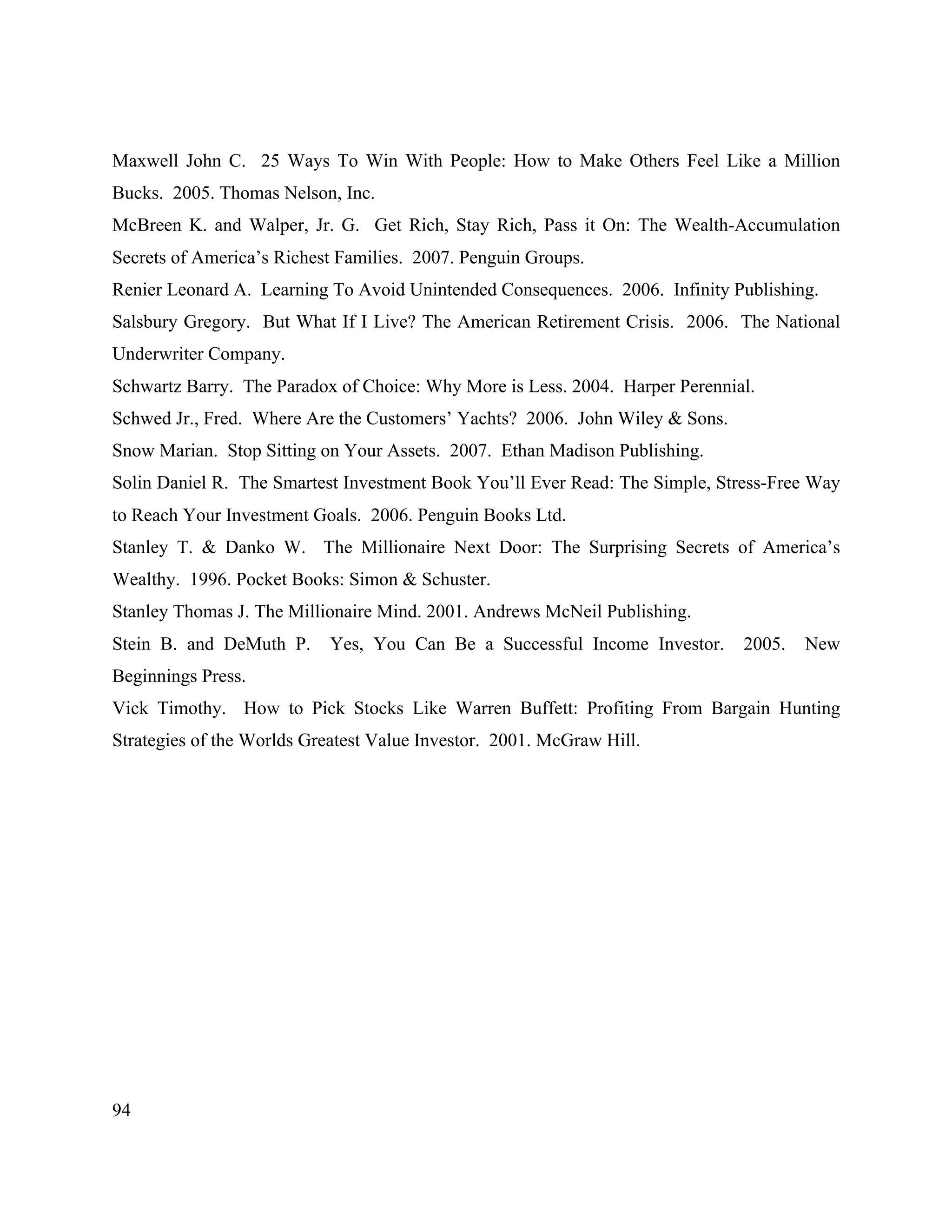This document provides an introduction and preface to the book "Dr. Dave's Uncommon Financial Advice" by David Shafer. The summary discusses how traditional financial planning models have failed many Americans by not providing enough income for retirement. It outlines the common advice of saving 10% of income, investing in mutual funds, and paying off debt quickly. However, this strategy does not factor in longer lifespans and rising costs that impact retirees. The introduction advocates for an evidence-based model that considers people's strengths and encourages adherence to personalized plans in order to better ensure a comfortable retirement.
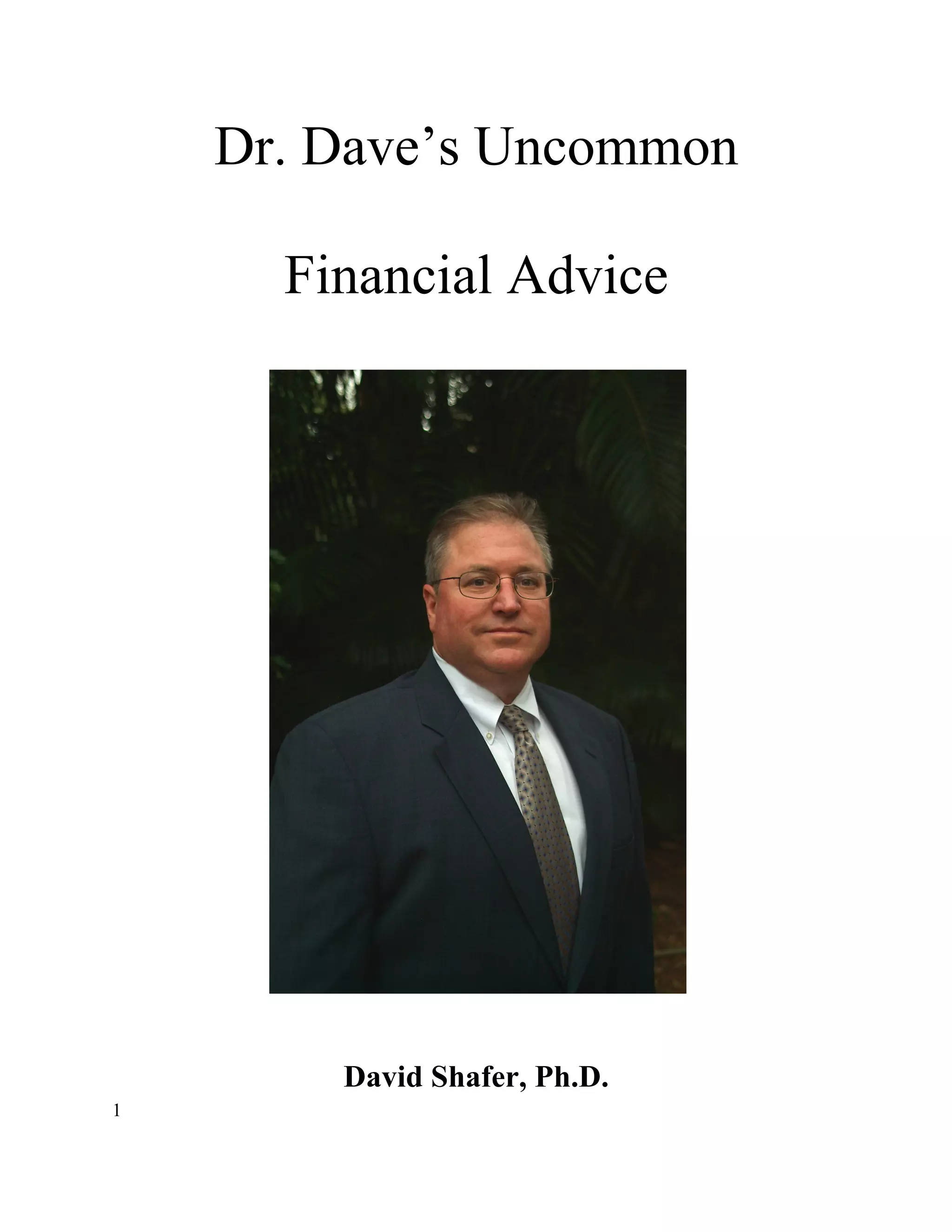
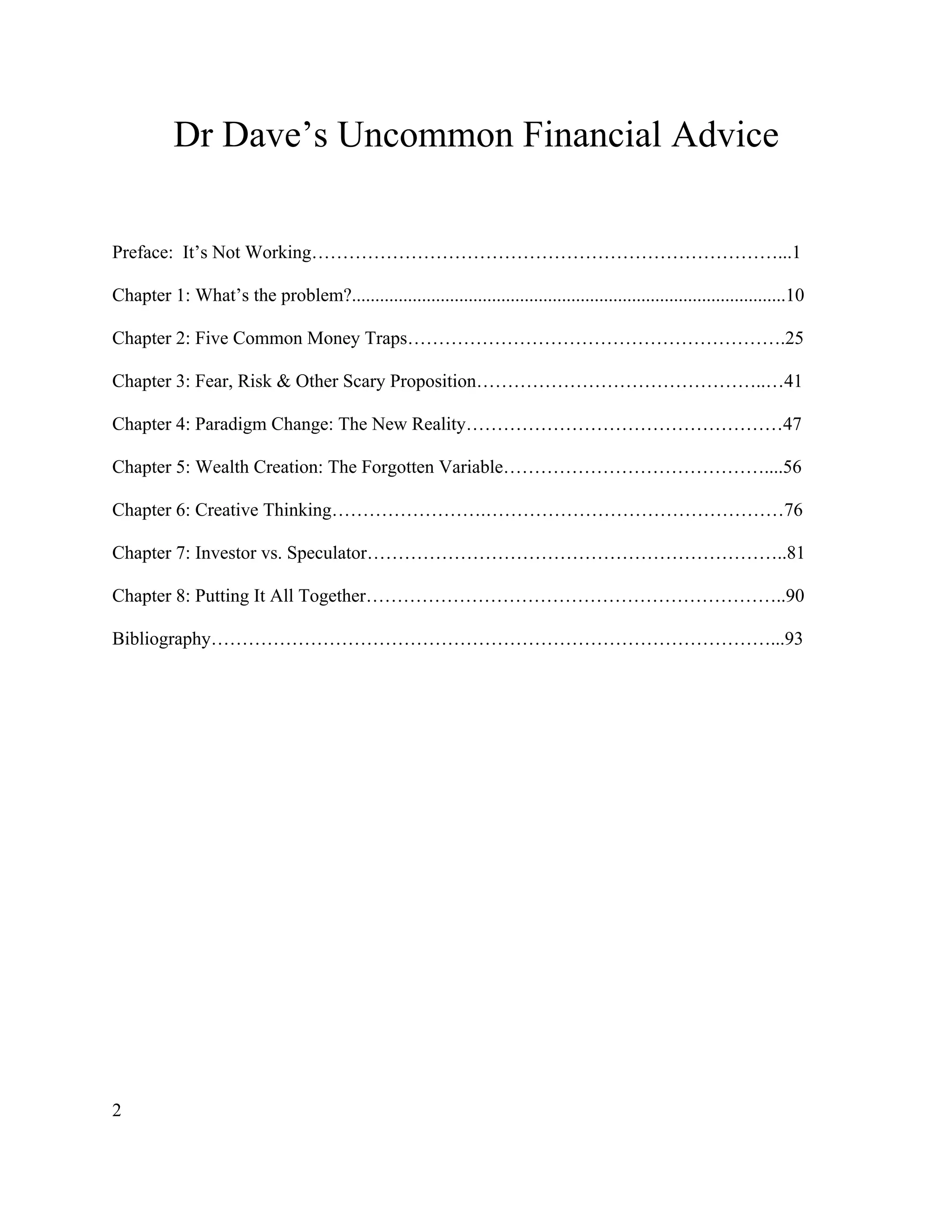
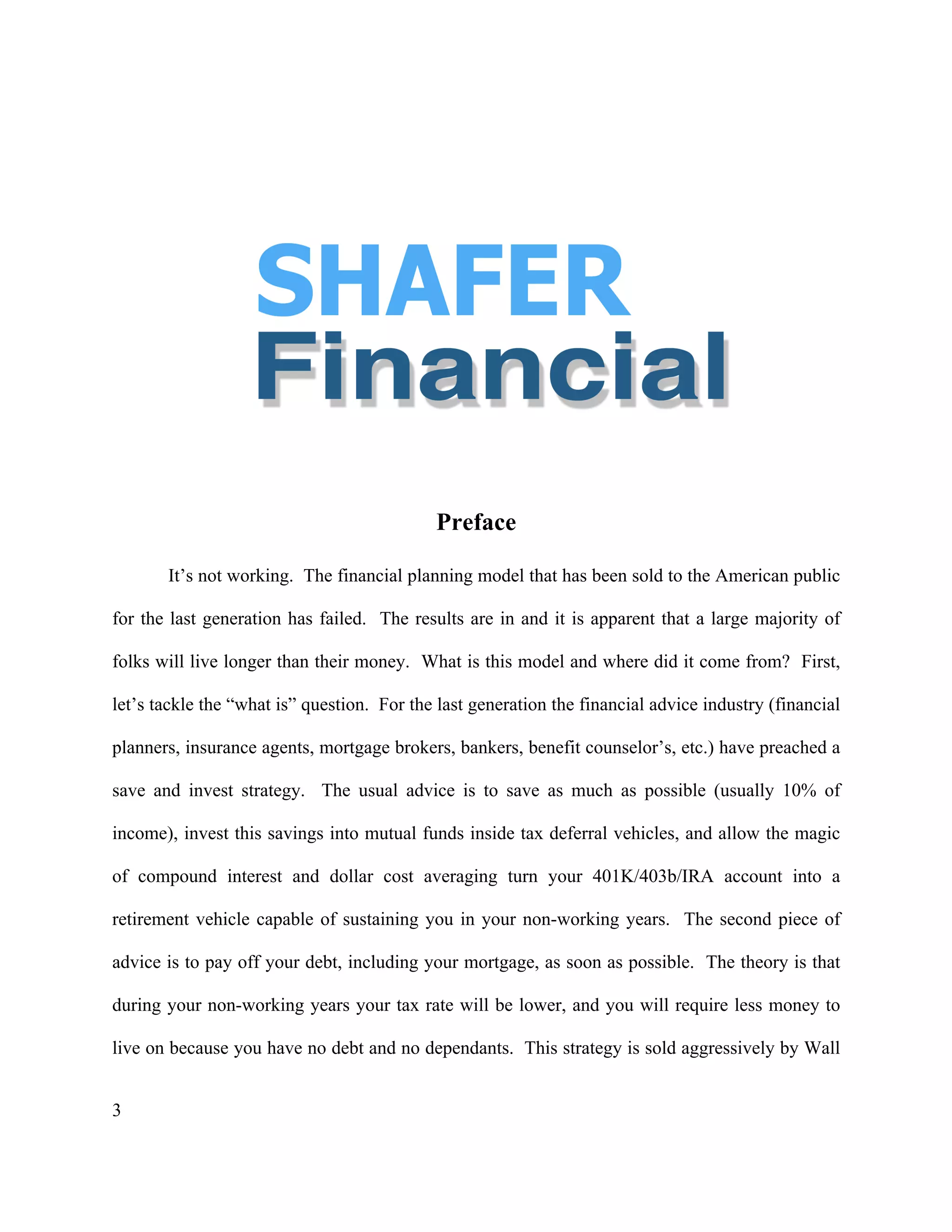
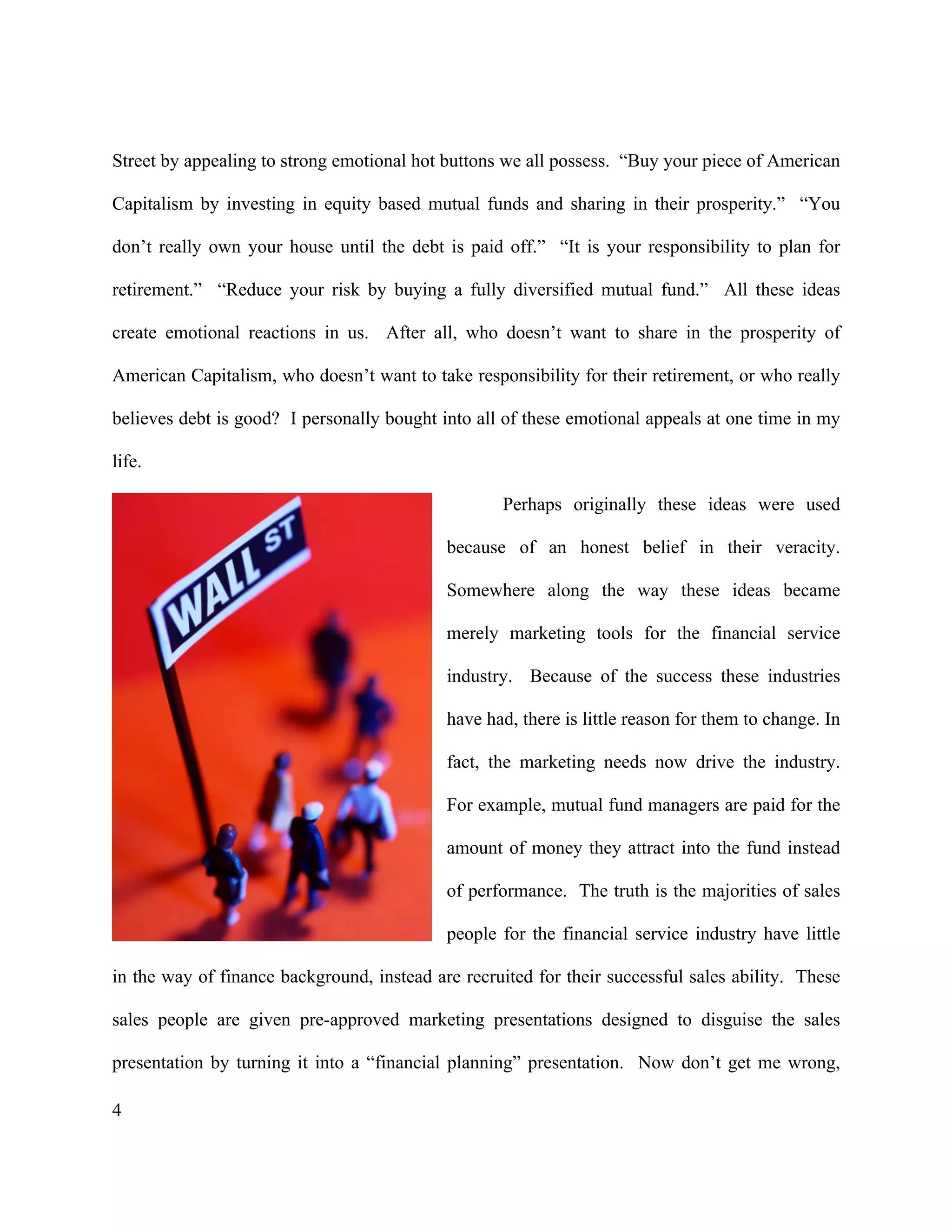

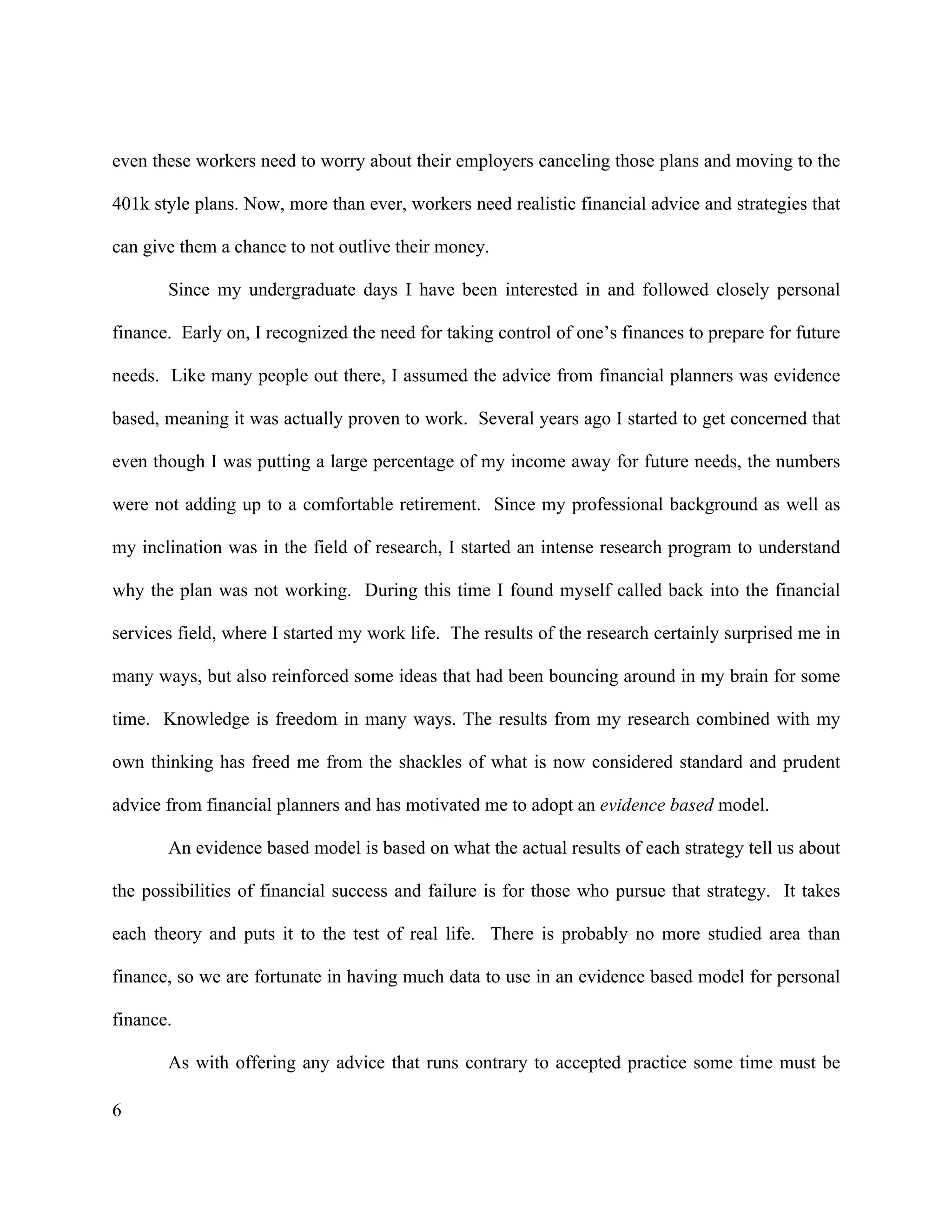

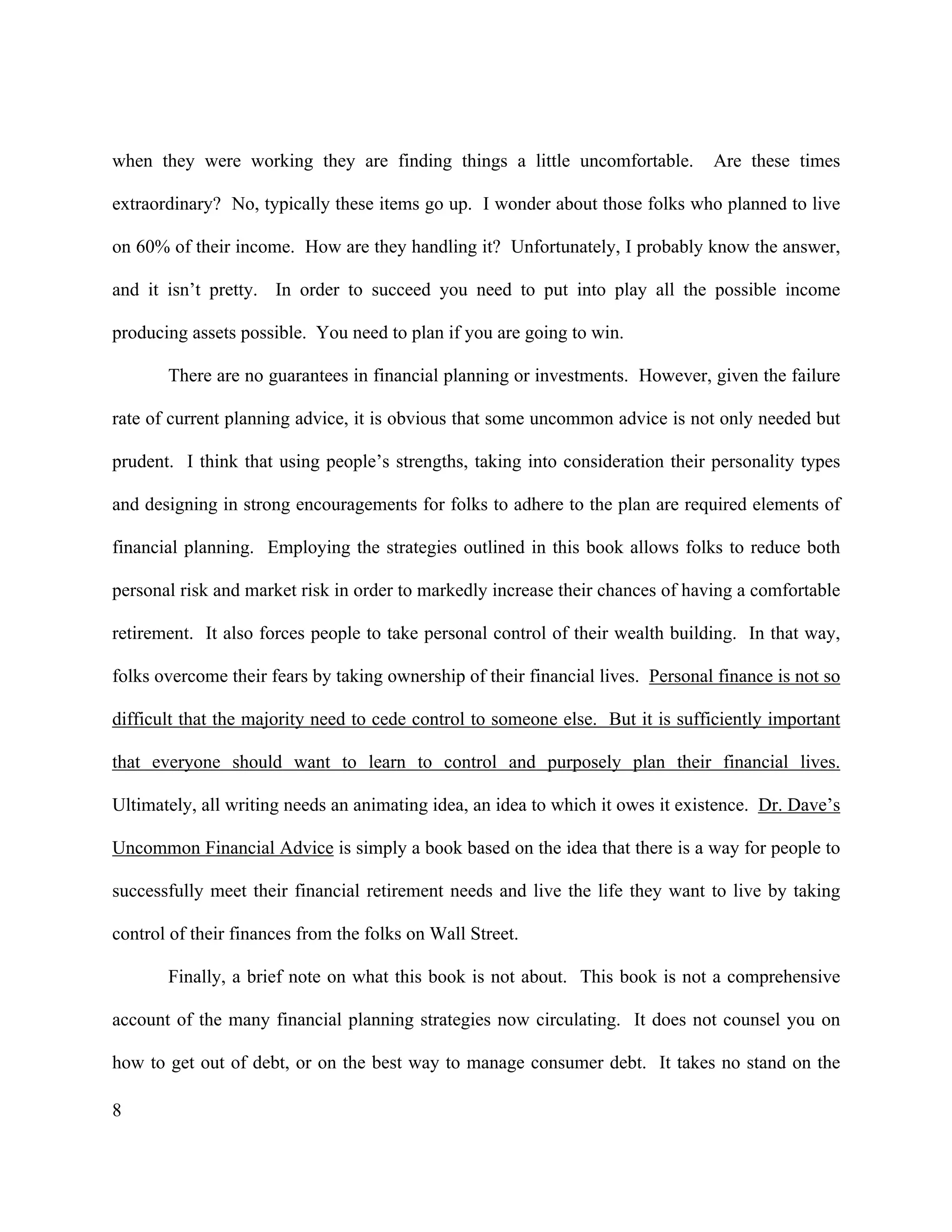
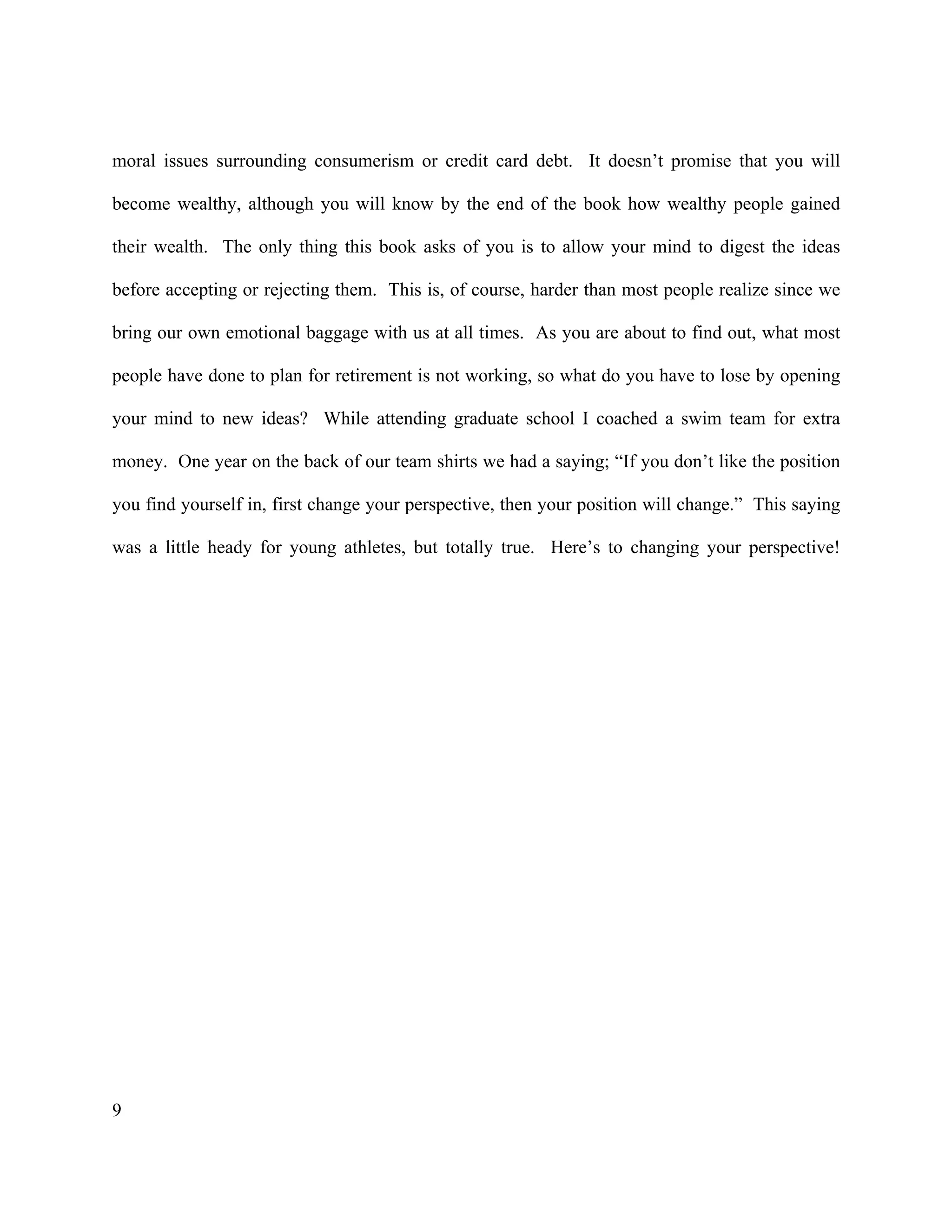
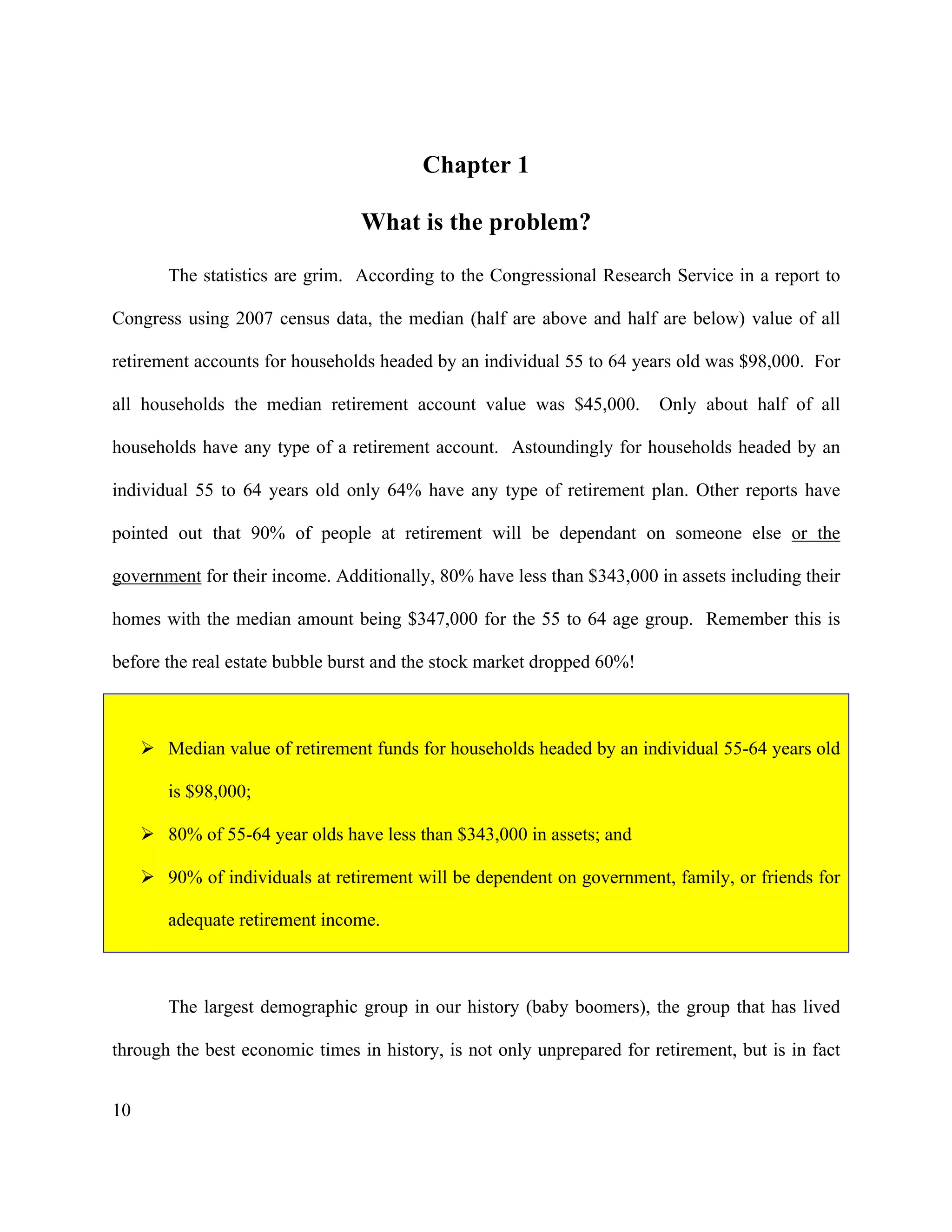

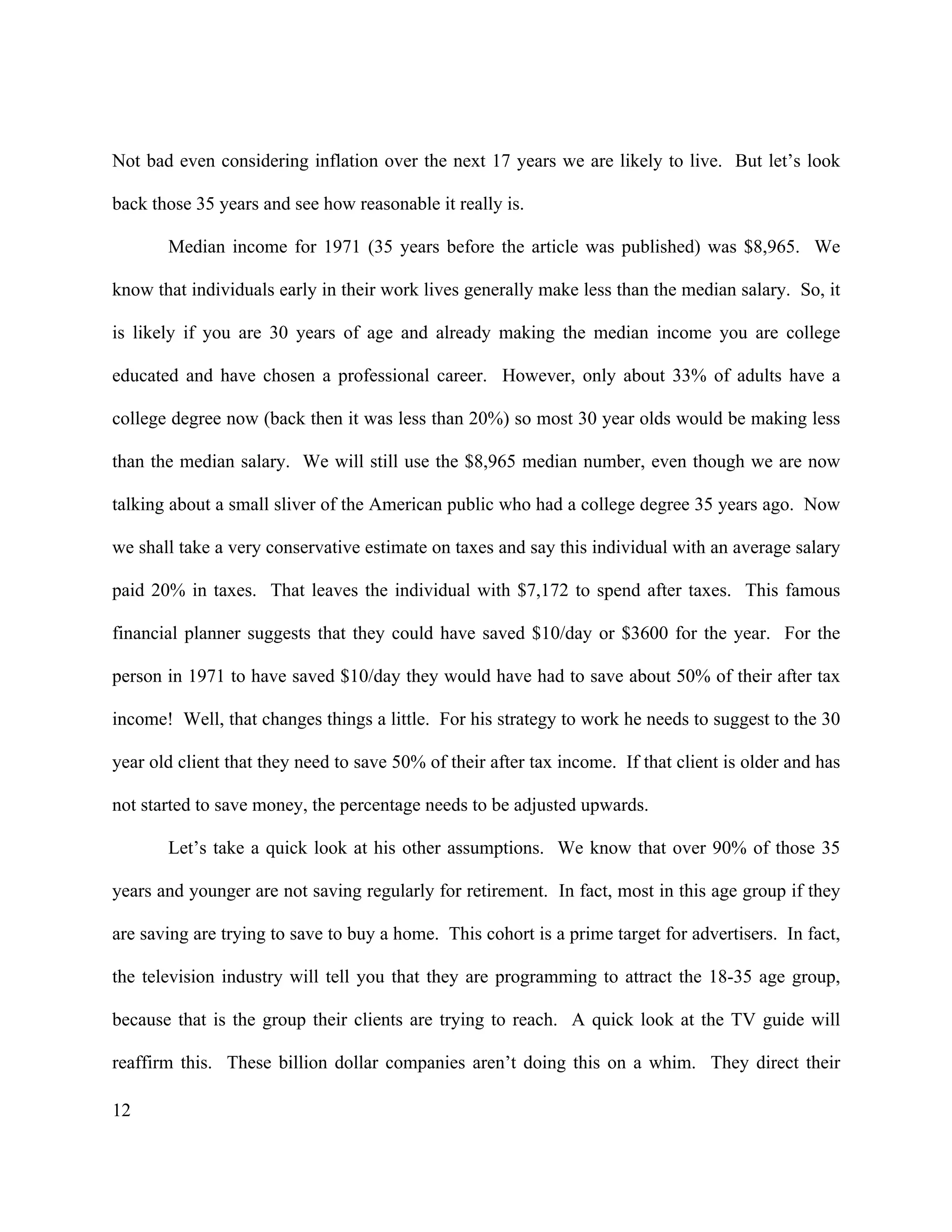

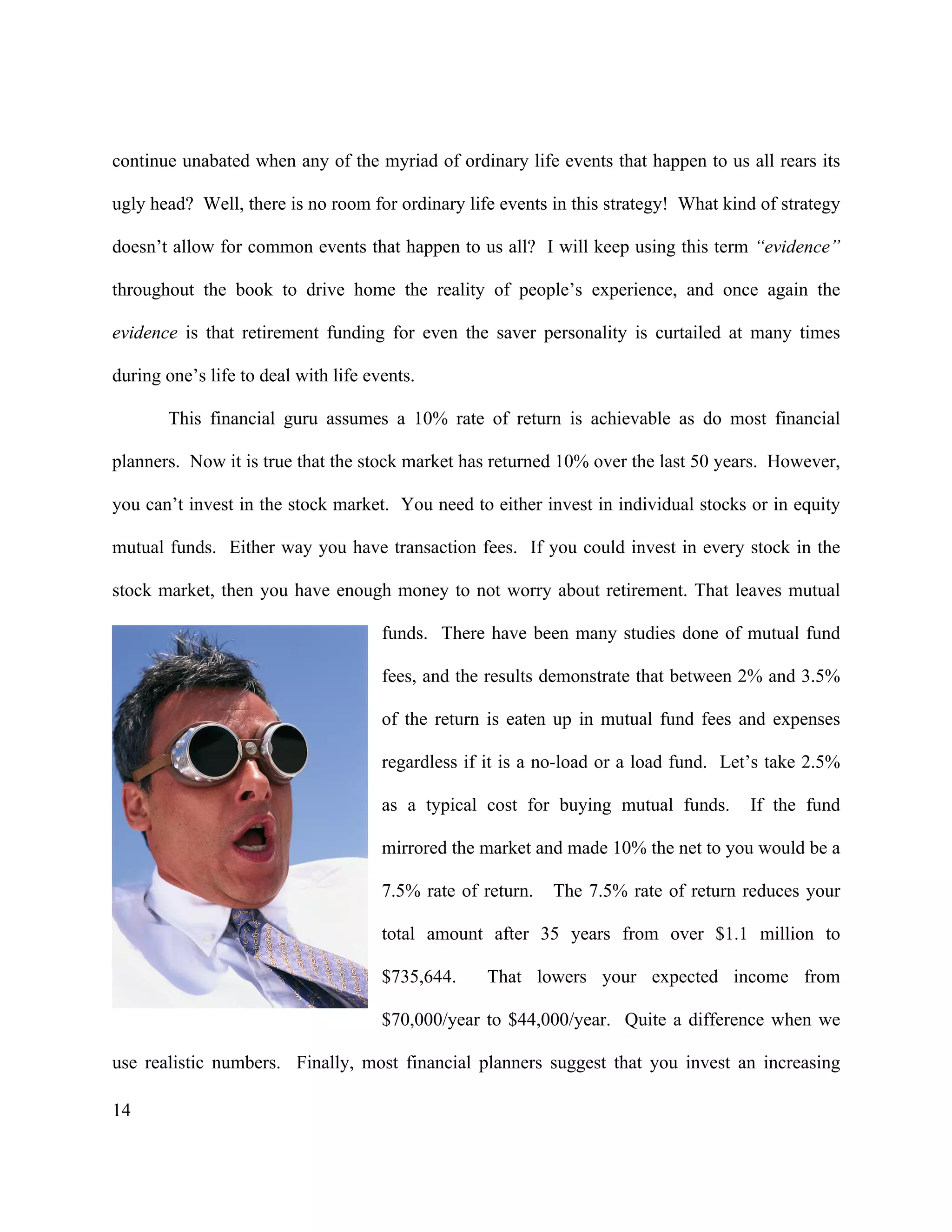
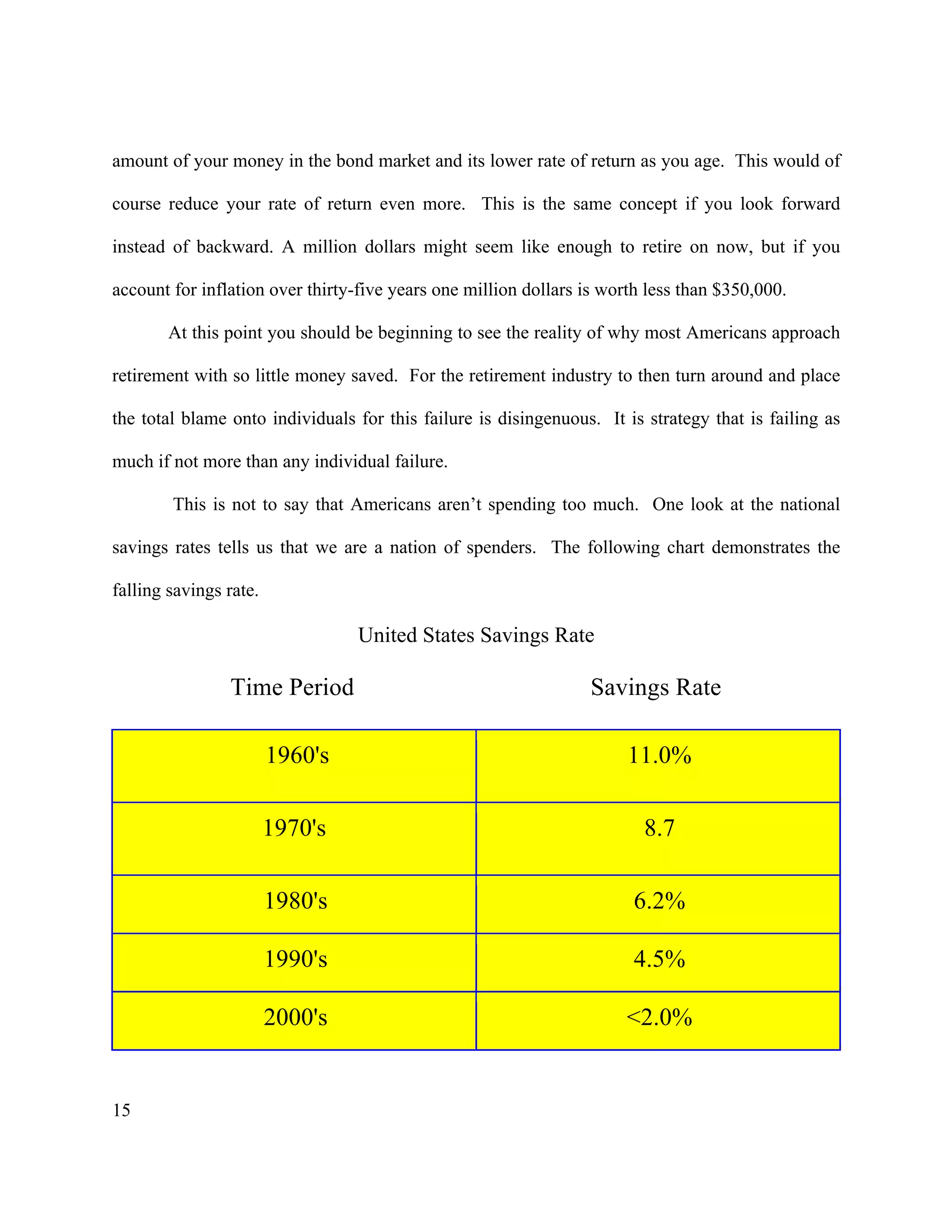
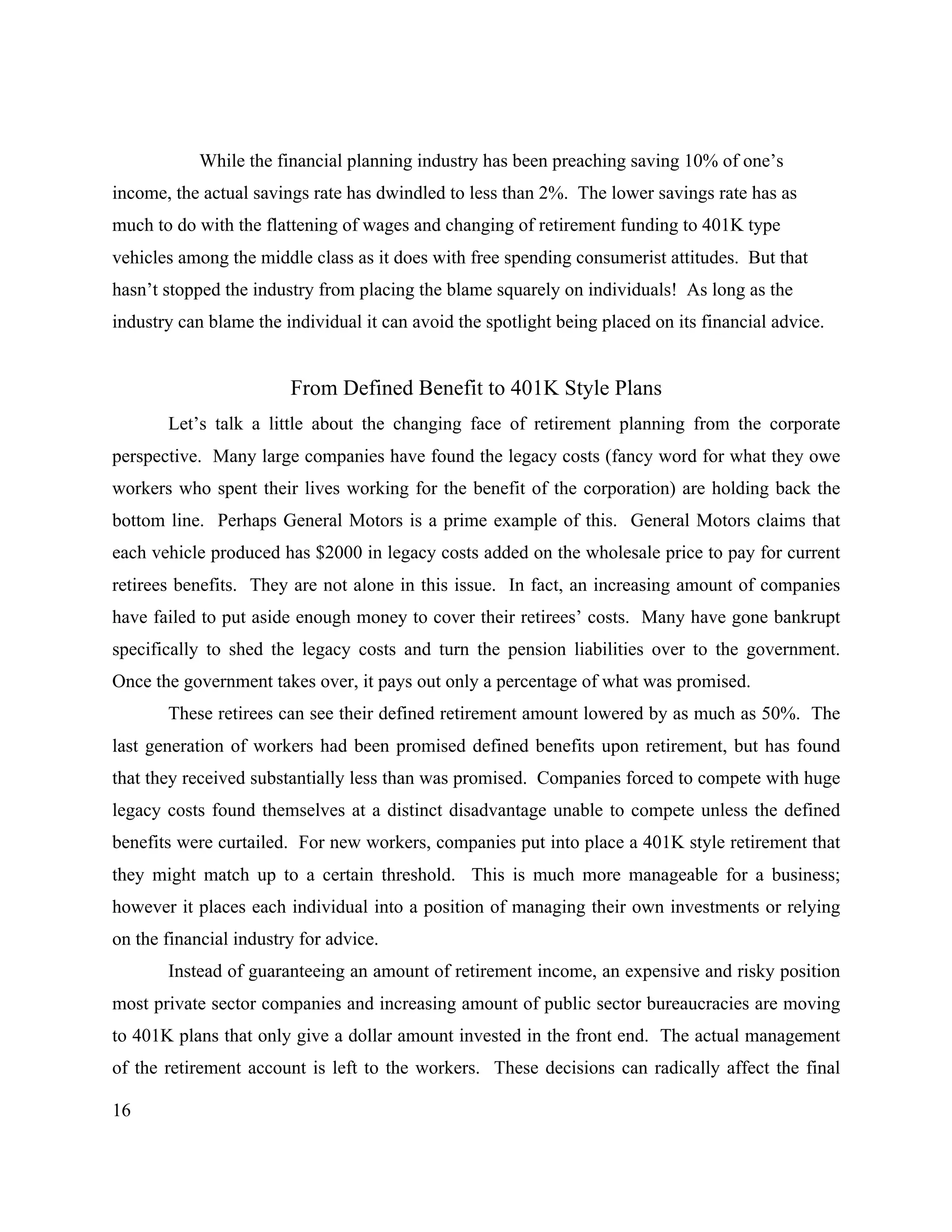
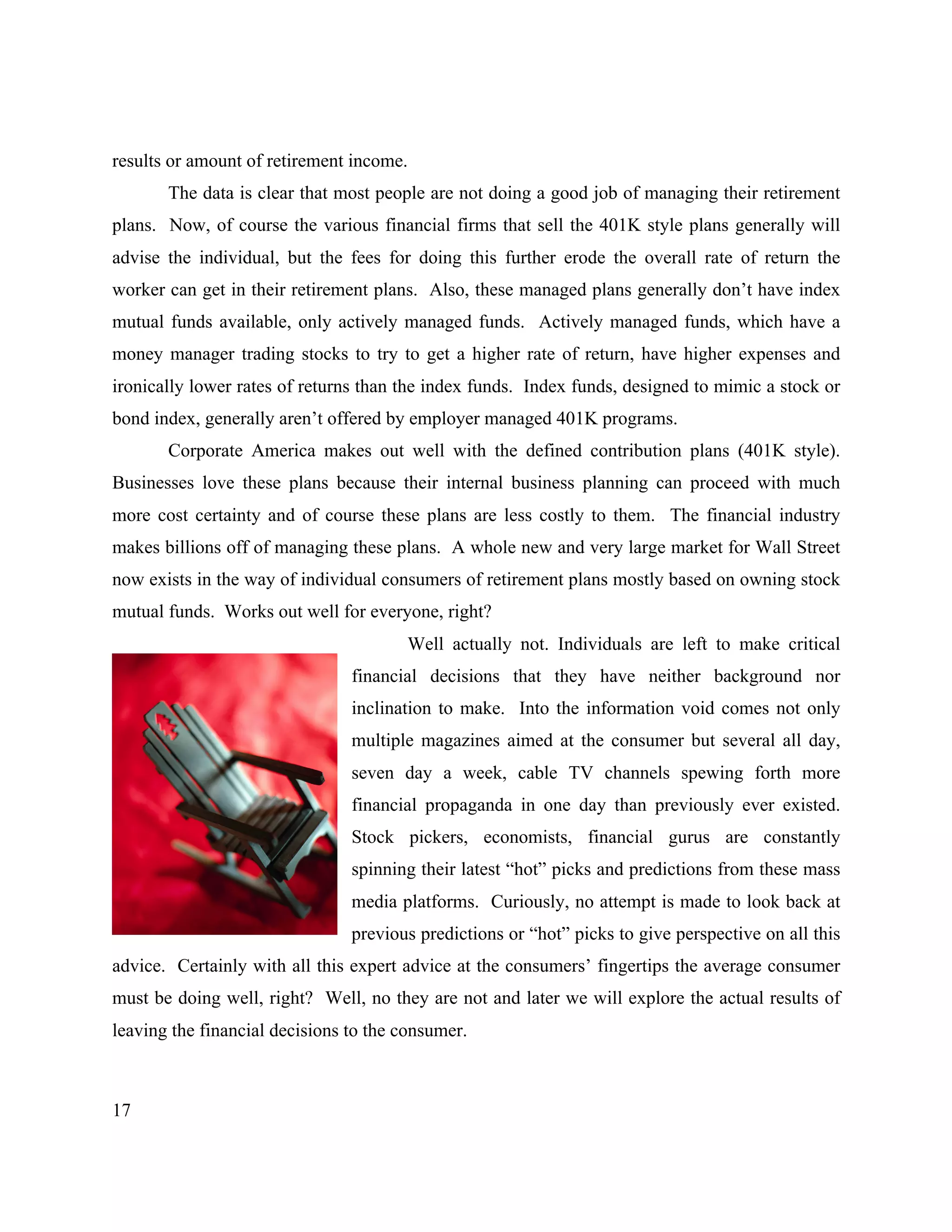

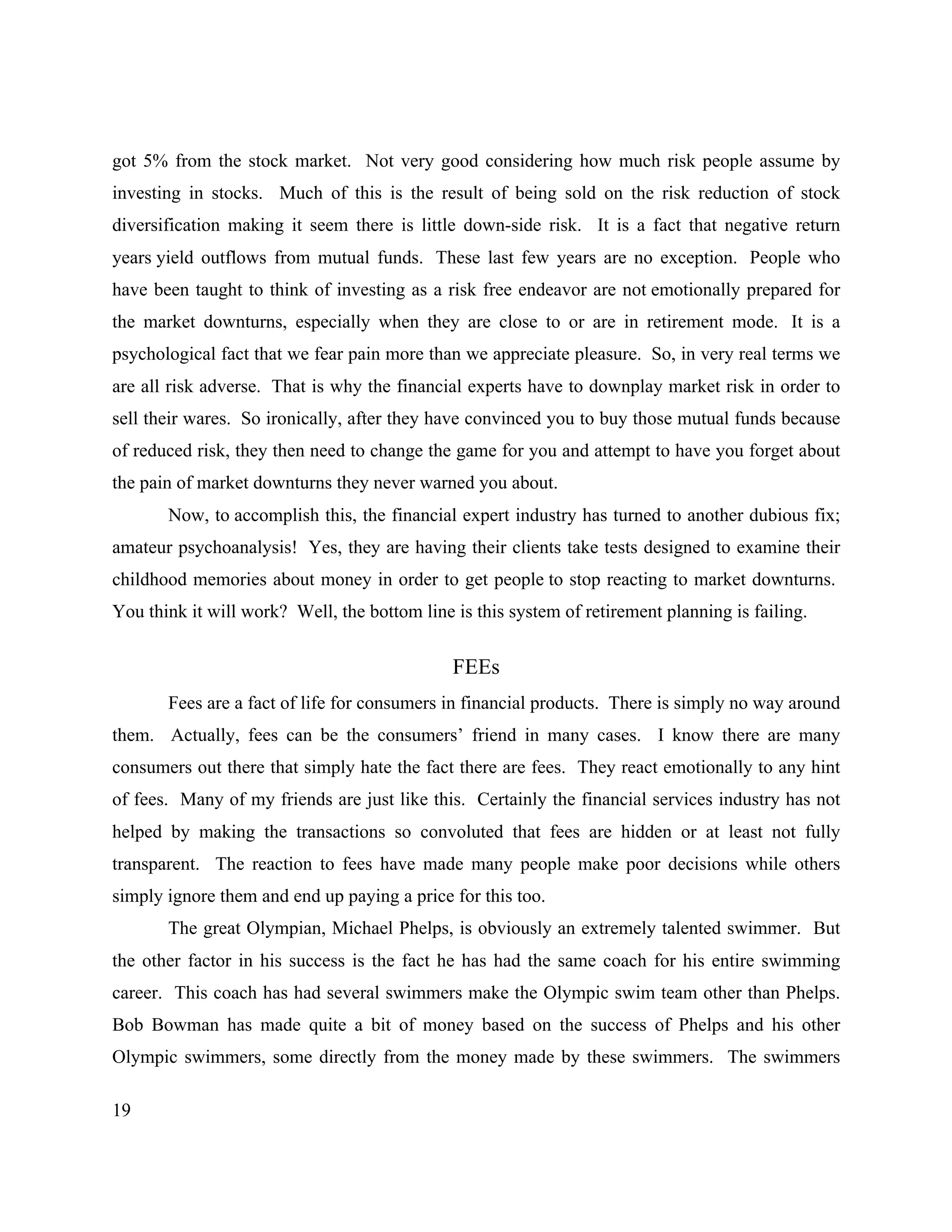
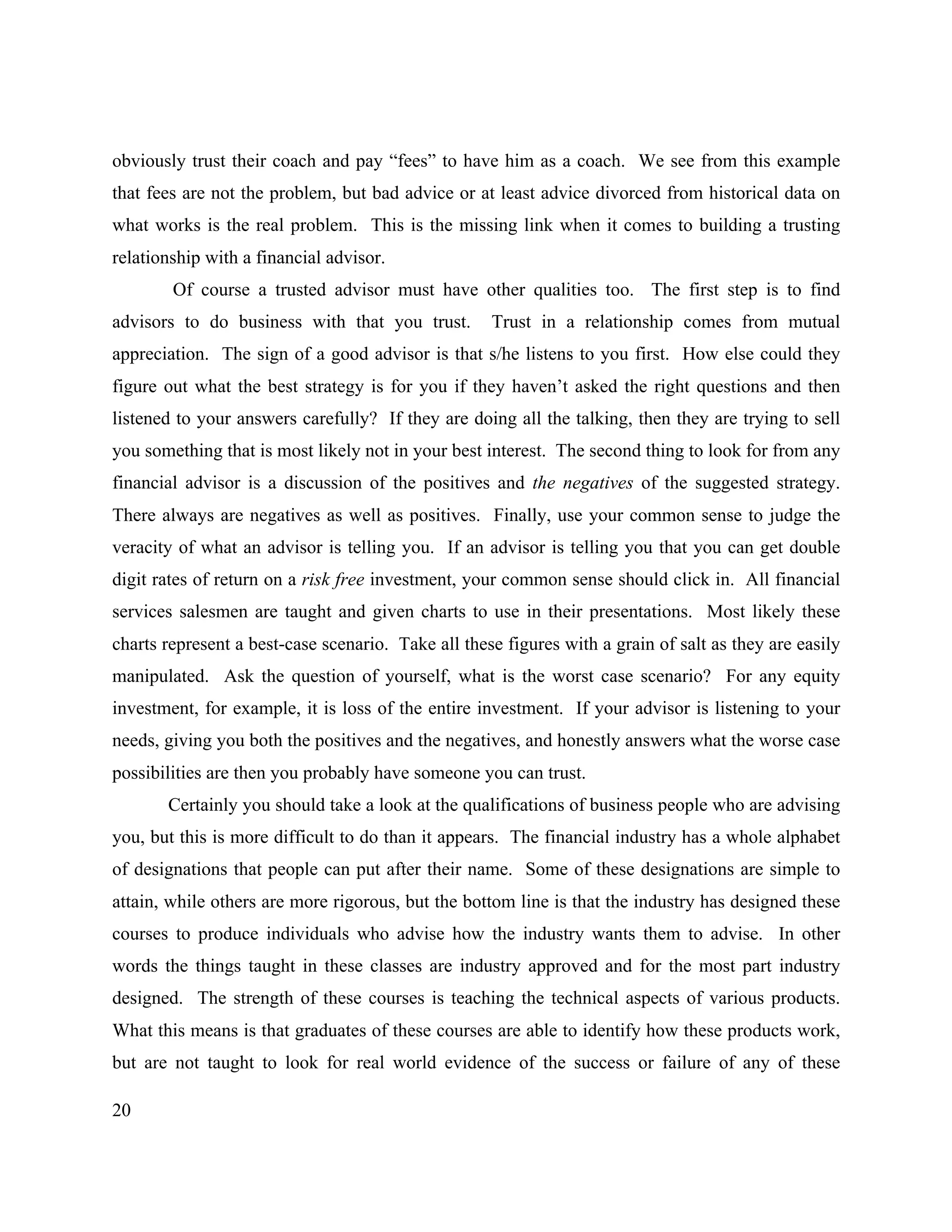
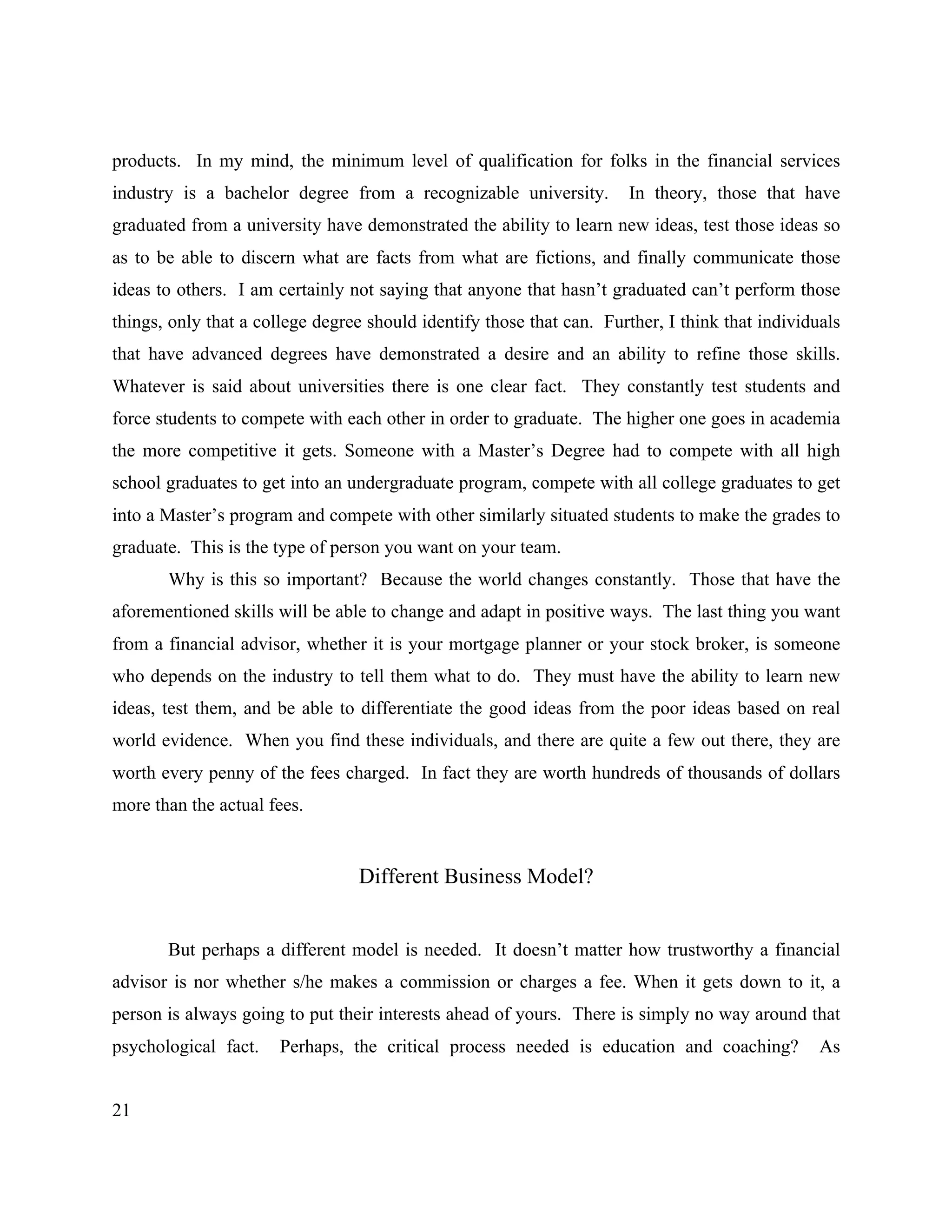
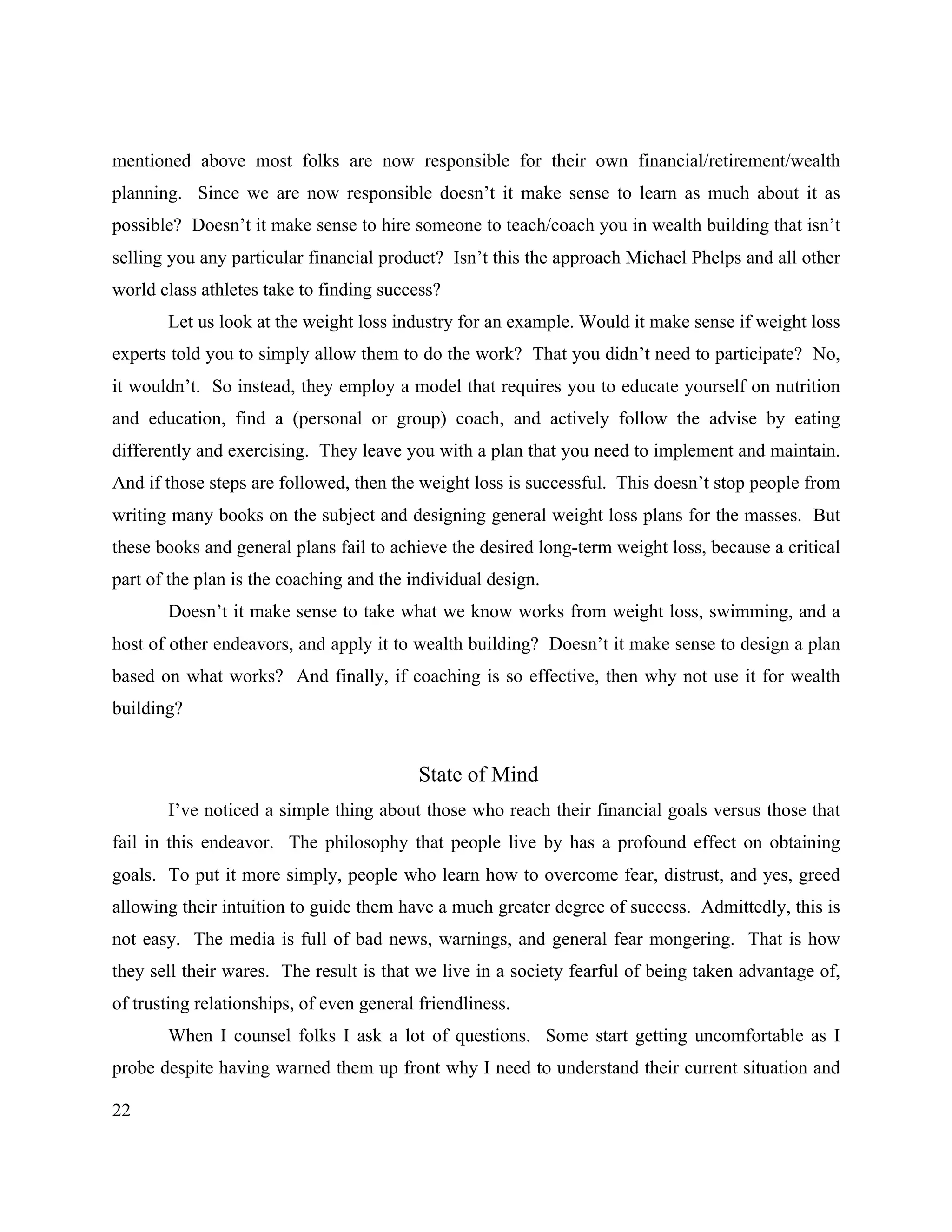
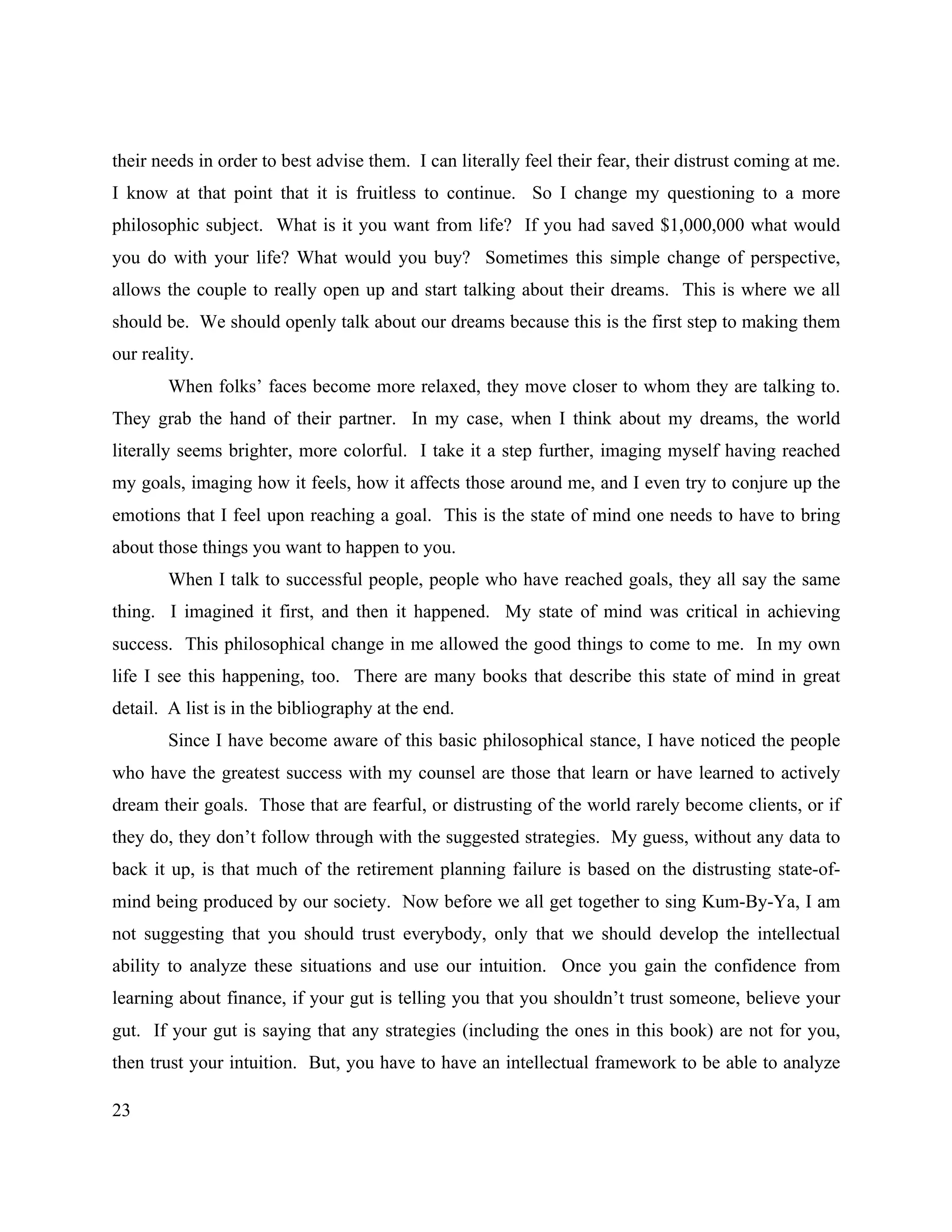
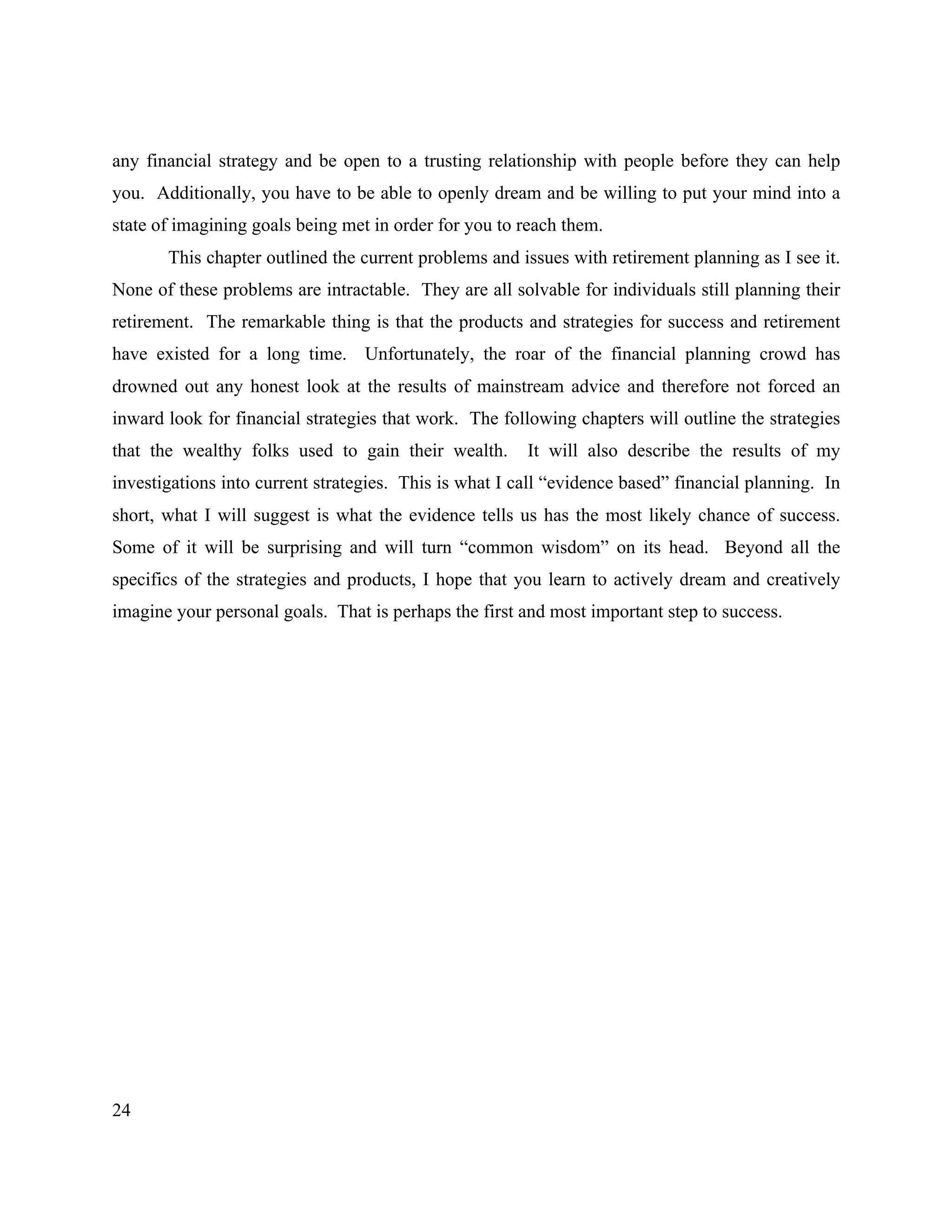
![25
Chapter 2
Five Common Money Traps
! Liquidity
! 401K/IRA
! Cost of Managed Funds
! Home Equity
! Variability/Rate of Return
Liquidity
Would if surprise you if I told you that what gets people in trouble is not lack of assets,
but lack of liquidity? I define liquidity as the ability to turn your assets into cash with the stroke
of a pen, click of a mouse, or dialing a telephone, without penalties causing your asset to be
devalued. As I write, the mass media has created large amounts of attention to what it calls the
foreclosure crisis. The real issue is that people have not created liquid assets to get them through
whatever has caused them to lose income. Had they had 6-9 months of liquid assets to get them
through the hard times, they would not be having their home foreclosed on at this time. They
could have sold the home or solved whatever was causing them to not have the income to pay the
mortgage. As it turns out the majority causes of foreclosure are temporary items like job loss or
sickness not what the mass media is telling us like variable rate loans.
However there is a small group of homeowners that bought at the peak of inflated prices
and now are experiencing being substantially underwater [owe more than the home is worth].](https://image.slidesharecdn.com/drdave20102-230209094210-28d544a4/75/Drdave2010_2-pdf-25-2048.jpg)
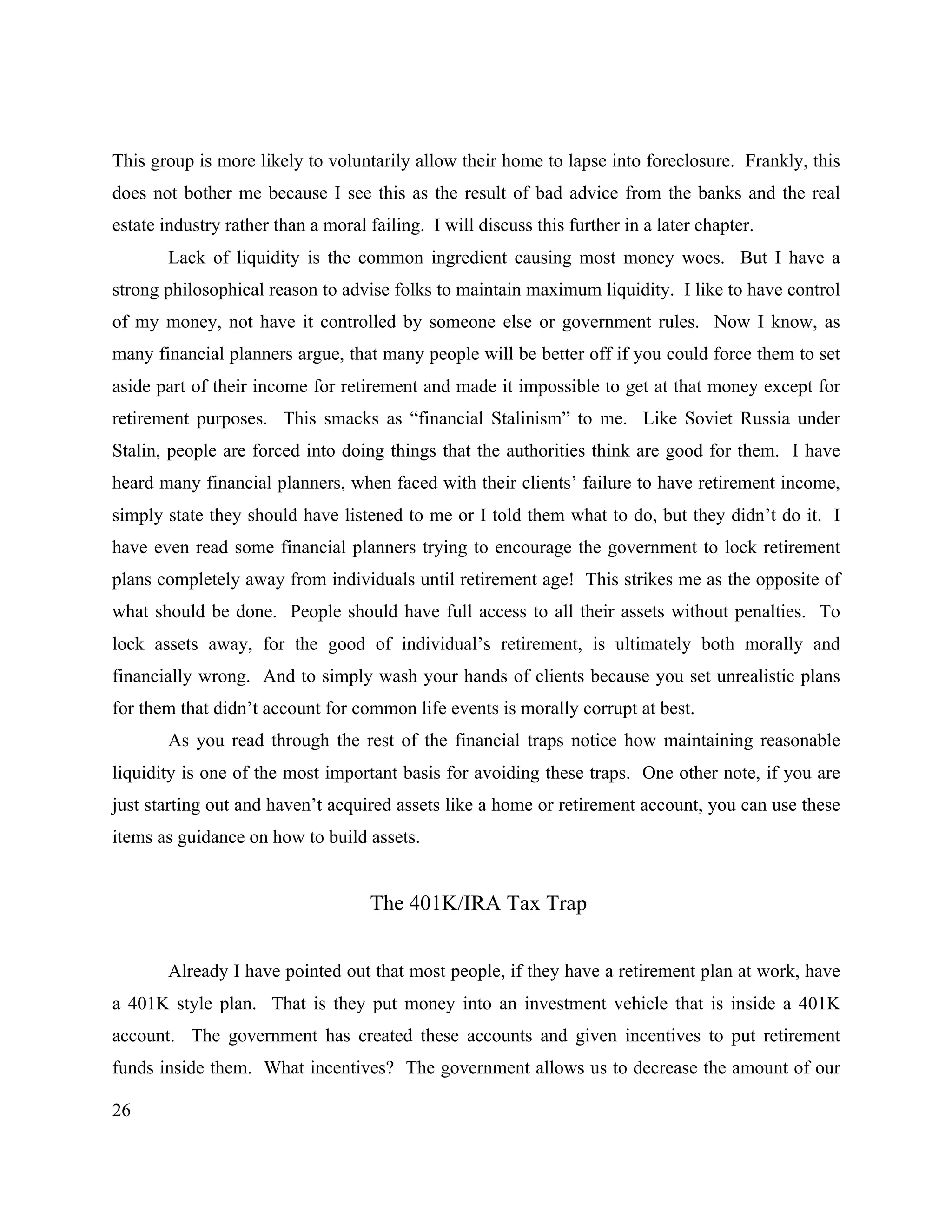
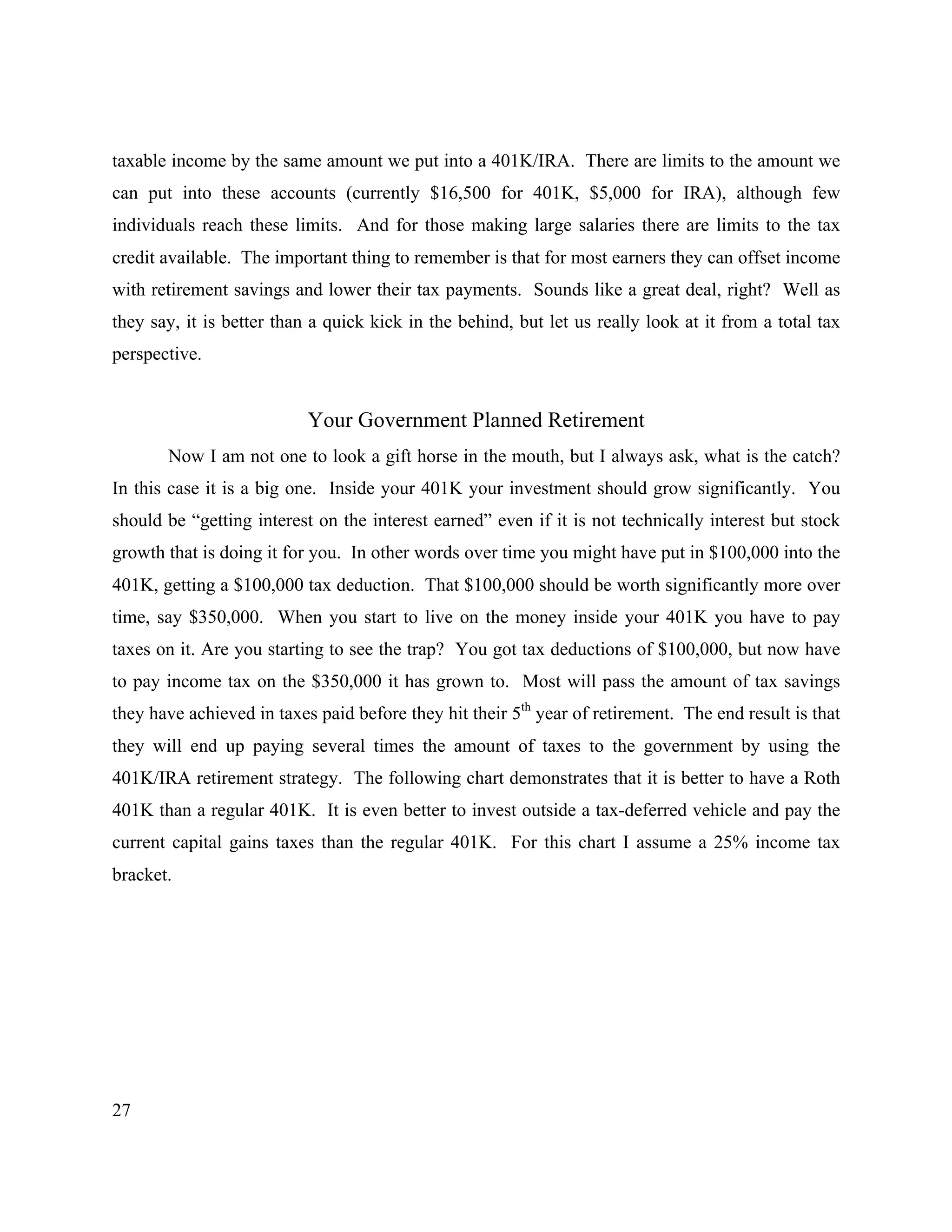
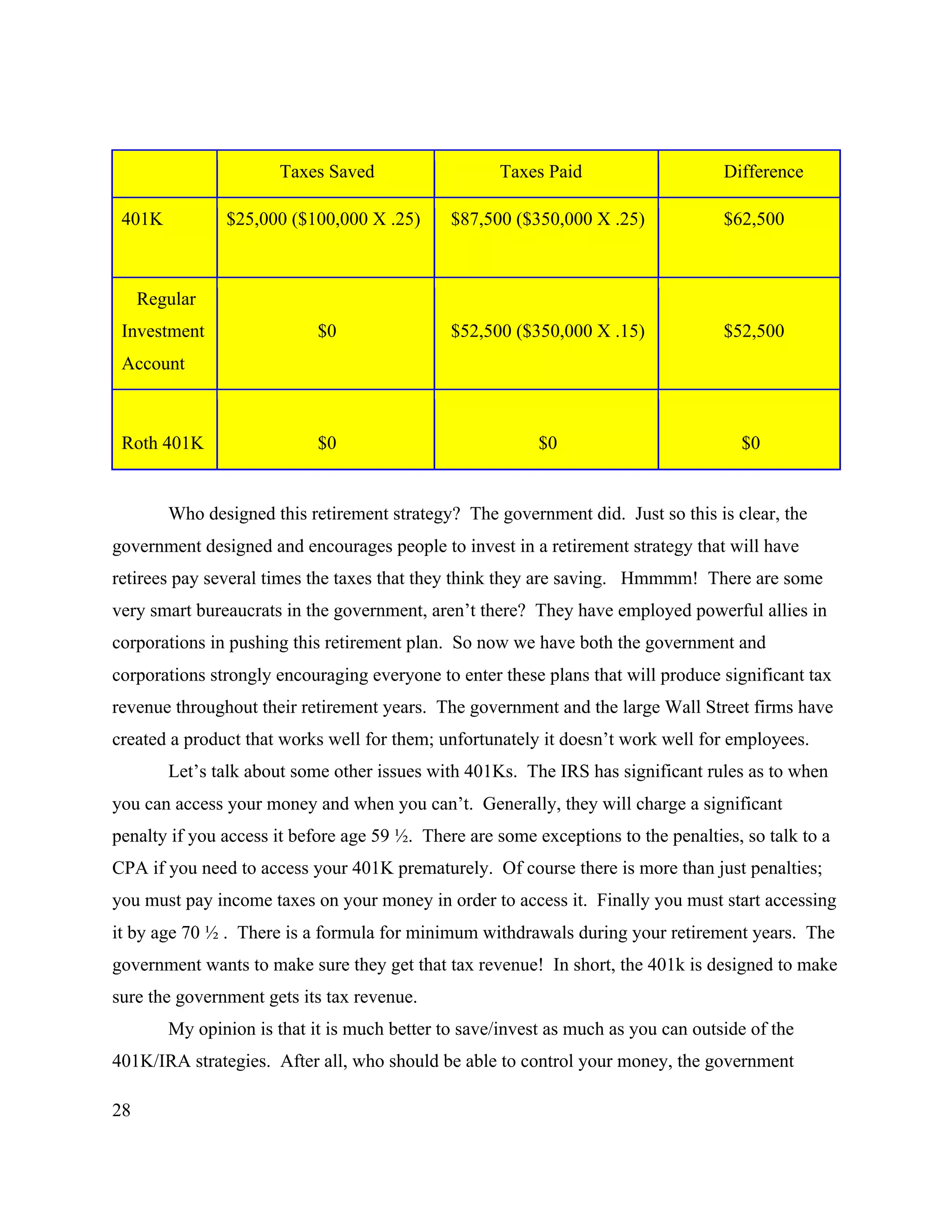

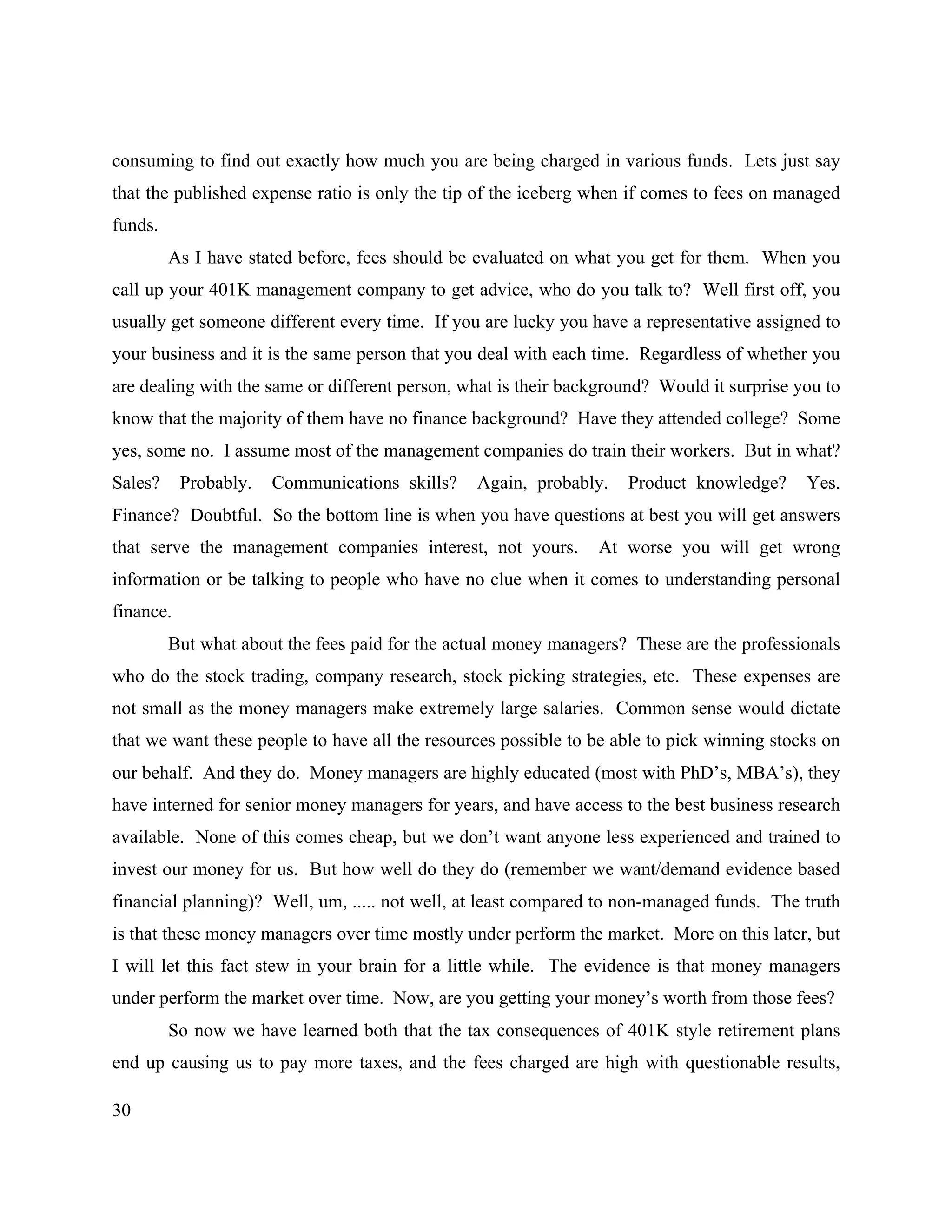

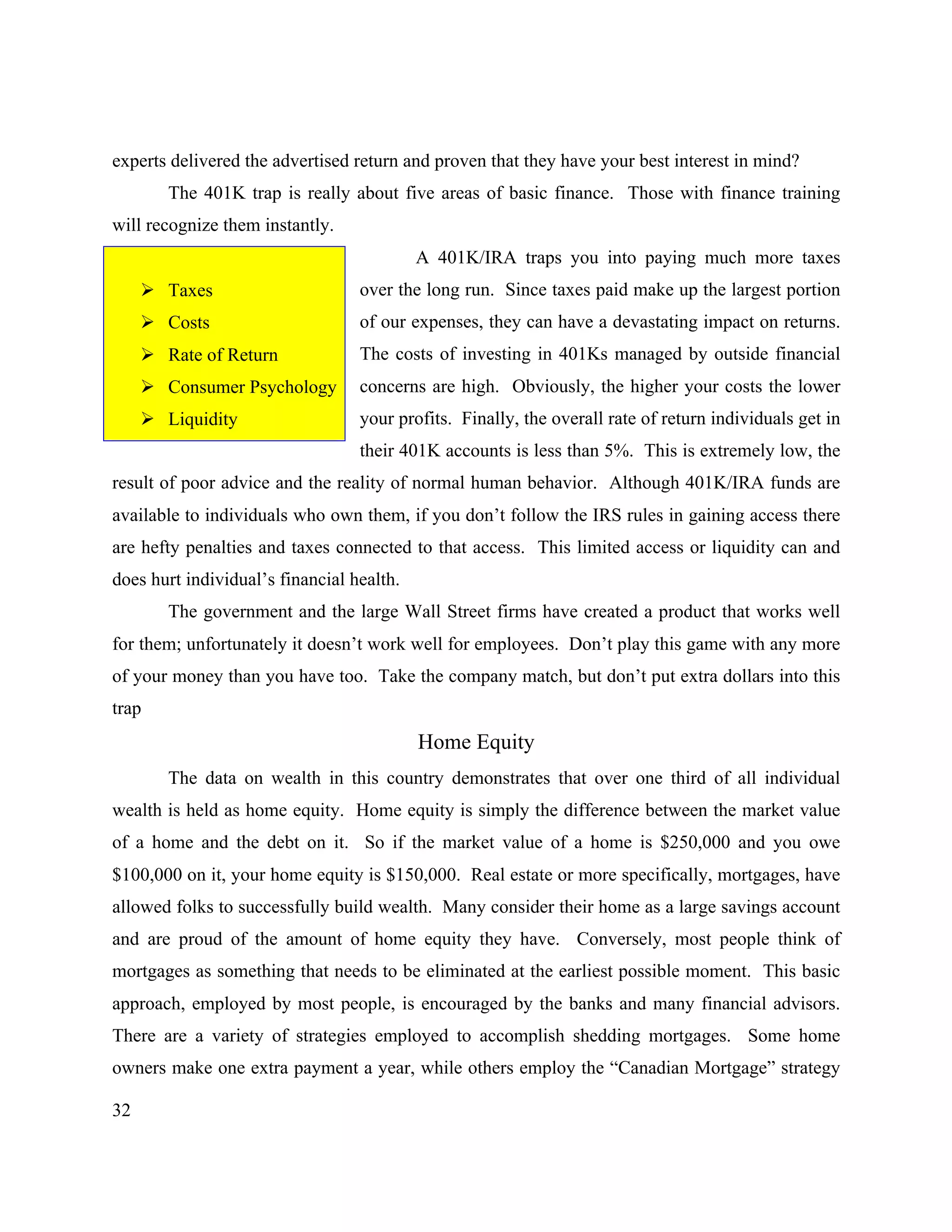
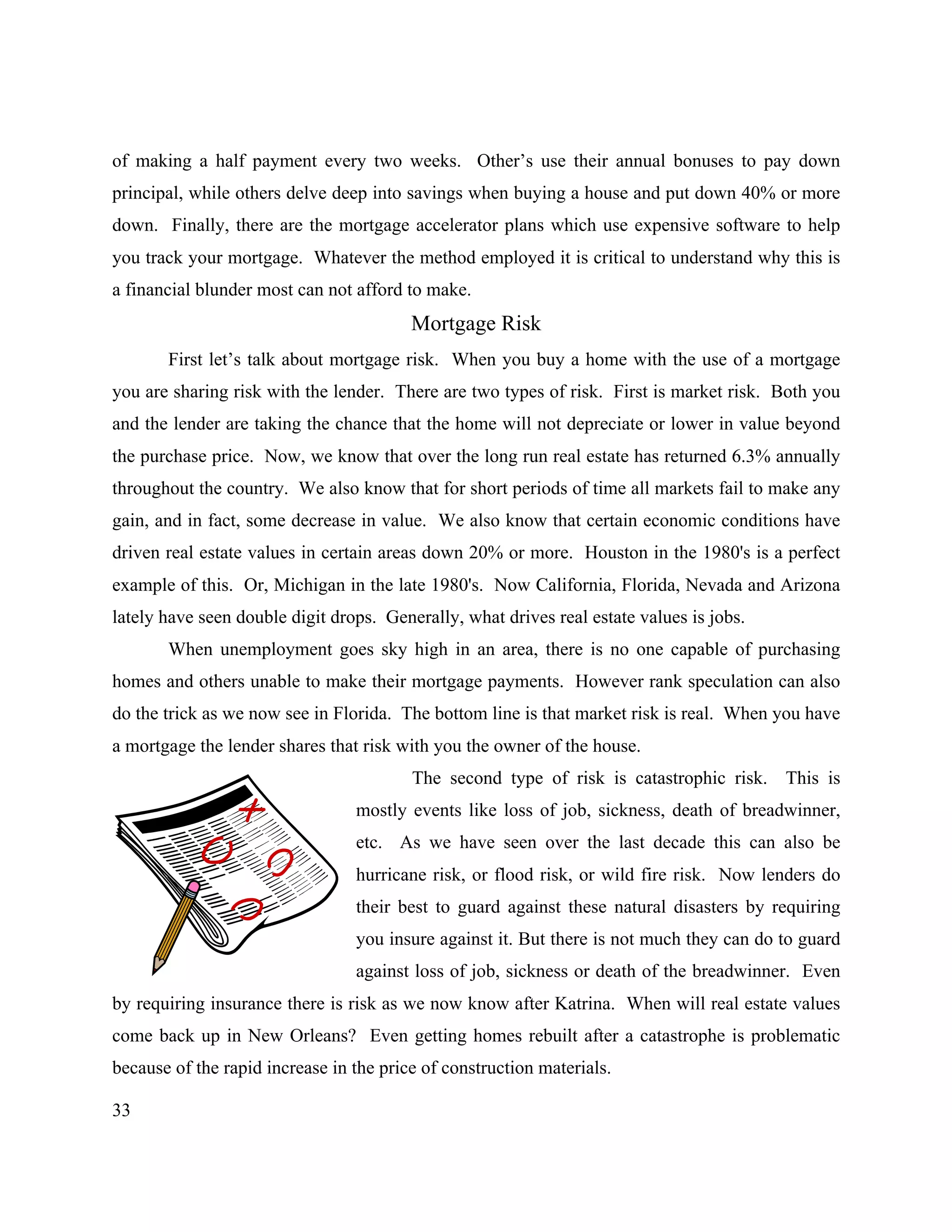
![34
So in short, there are risks shared by the lender and owner of a home. Most people
assume that they are safe from risk when they have paid off their mortgage. This is true with
regards to losing a home to foreclosure, but in effect they are getting rid of a partner who shares
the risk. Here is what is really happening when people start to pre-pay their mortgage. They are
transferring risk from the lender to themselves. That’s right. They are taking on more risk during
the time they are paying down their mortgage. Here is a little known fact. The more equity you
have in your home, the more likely the lender will foreclose on you if you miss three payments.
Yes, seems unfair, but the lender is more likely to try to work it out with those folks who have
little home equity. From their perspective, the last thing they want to do is to foreclose on a
home and not get their money back. So they will work with home owners who have little equity
rather than foreclose, while they are unlikely to worry about getting their money back from a
home owner with 40% of value in home equity. They could easily sell that home and get back
their money.
Since the recent mortgage foreclosure crisis, the government has moved to help some
homeowners [and banks] by modifying mortgages. But even this program is reticent to lower
principal. So all those homeowners and banks are still on the hook for that lost real estate value.
It would seem the rational behavior would be to walk away from homes that are severely
underwater and let the lenders take the financial hit, while the owners take the credit score hit.
Despite all the moral pandering, this is how the system was designed to work in the first place.
But if you have made your home your place of savings by paying down the mortgage then you
are left to take the losses alone.
Leaving that aside, let’s say you have been making extra payments for years and have
paid down much of your mortgage. You get sick and are unable to make your mortgage
payments (which have remained the same despite your early pay down). Is the lender going to
give you a break because of your pre-payment history? No! Can you refinance? No! You are
stuck. The lender is going to foreclose and you will lose that home equity you have been
working so hard to build up. If a natural disaster occurs, resulting in property values plummeting
and construction costs skyrocketing what happens to your home equity that you worked so hard
to build? It evaporates. You have taken on the risk, relieving the lender of its risk. No wonder](https://image.slidesharecdn.com/drdave20102-230209094210-28d544a4/75/Drdave2010_2-pdf-34-2048.jpg)

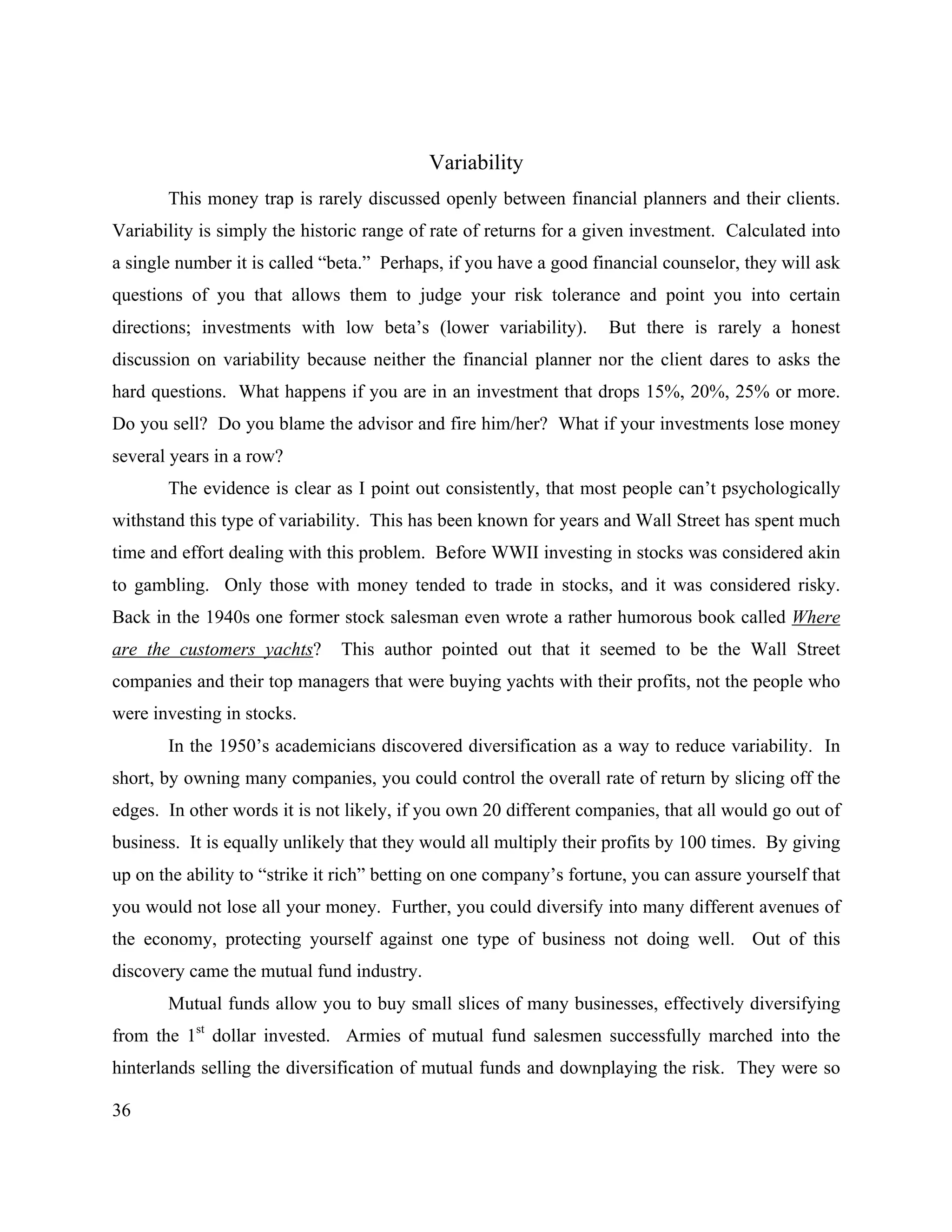
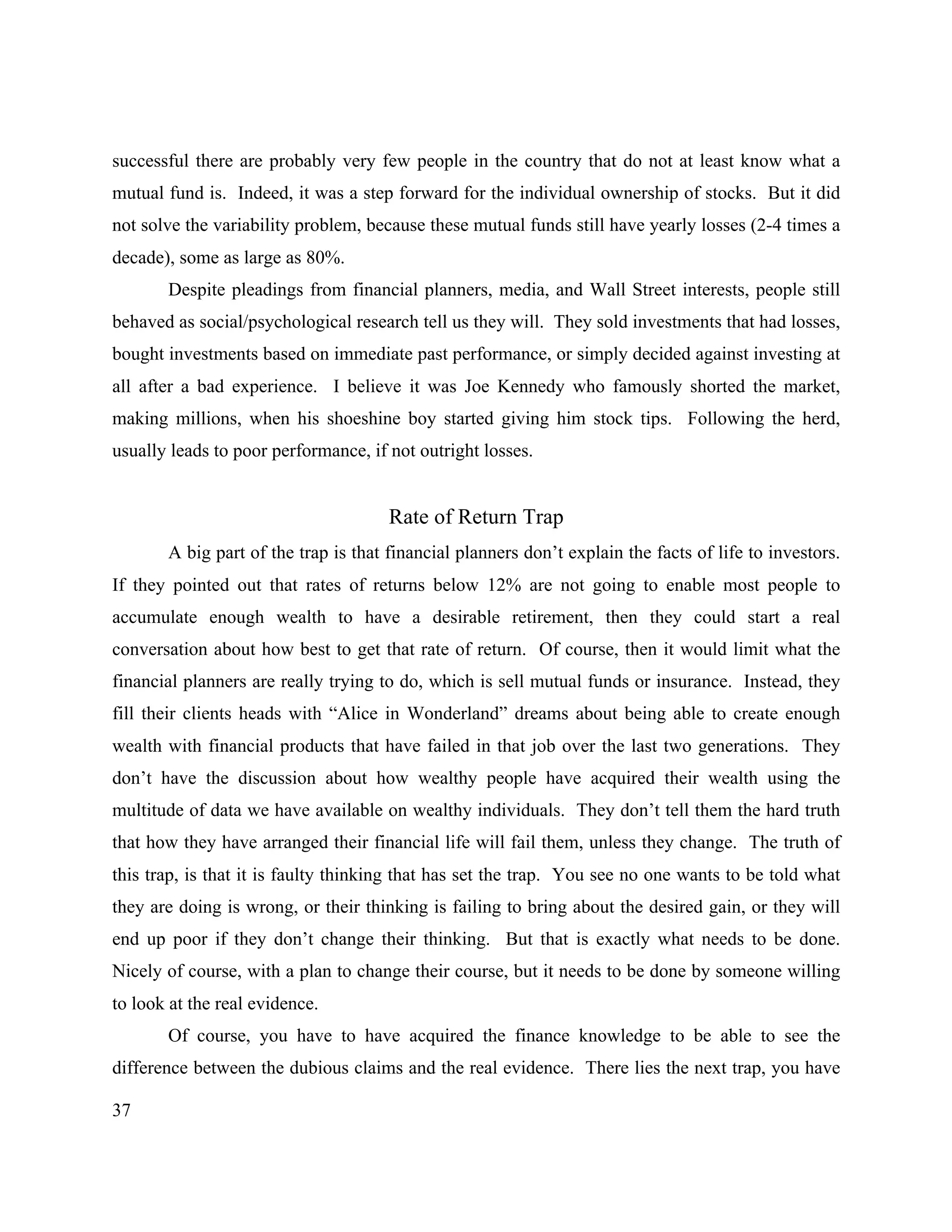
![38
to learn to do it for yourself first. Too many people think they can simply hire someone that will
look out for their money. Well, let me be the first to tell you that you will never be able to hire
someone to look out for your interests above their own. The only person that will look out for
your interests first is you! Take a good look in the mirror because the person you are looking at
is responsible and capable of creating wealth and a happy comfortable retirement. But you have
to get away from the scarcity thinking that inhabits your brain. You have to think like an
investor or employer, not an employee. You have to recognize the risk of not having enough
money for your retirement as real and likely. You have to recognize that average thinking will
get you nowhere in this environment.
Sequence of Return Risk
Notice I have put this in large print and red! That is because this is critically important to
understand. So what is the sequence of return problem? Probably best to demonstrate this risk.
Two brothers, John and Joe, were approaching retirement. As it turned out they both had
$800,000 in funds at retirement to last the rest of their lives. John was 3 year older than Joe and
retired in 2000. Joe retired in 2003. They both were very concerned with having their money
last and found the research that told them they could safely take out 4% of their original nest egg
per year and have a better than 90% chance of not running out of money if they lived to 90.
Interestingly, there were some planners that said they could go as high as 8% and not have that
problem if they stayed in the stock market. But they were conservative and stayed with the 4%
withdrawal rate.
Let’s assume both retirees get the return of the S & P 500.
John retires on Jan 1. pulls out $32,000; 4% of $800,000). At the end of 2000 he has $759,552
in his account. He pulls out his $32,000 again and has $641,046 left in his account at the end of
the year. For 2002, he pulls out $33,000 [increasing his draw accounting for the inflation] and
by the end of the year he has $473,667. For 2003 he pulls out $33,000 again and has $567,051
[market started back up here. In four years his account has gone down 29%.
Now let's look at his brother Joe. Joe is three years younger so he starts his retirement on Jan. 1,](https://image.slidesharecdn.com/drdave20102-230209094210-28d544a4/75/Drdave2010_2-pdf-38-2048.jpg)
![39
2003 with his $800,000. He pulls out his $32,000 and at the end of the year has $987,494.
Again he pulls out his $32,000 and at the end of year 2 of his retirement has $1,059,453. Now he
pulls out $33,000 to account for inflation and at the end of year 3 he has $1,076,850. After year
4 he has an account with $1,208,675!
Two brothers, same account size, same strategy, one has over twice as much as the other 4 years
into retirement!
That is what sequence of returns is all about. The first few years of retirement are critical and if
you pull money out and have significant drawdowns it cripples your future. If you get lucky and
have significant upward movements, it allows you to float through troubled times much easier.
Let's finish this example and take them through the beginning of 2009.
John:
2005: Account value $592,155
2006: Account value $ 586,610
2007: Account value [increase withdrawal to $34,000] $639,867
2008: Account value $639,129
2009: Account value $367,011
Nine years and a loss of over half the account.
Brother Joe:
Jan 1 2008: Account value $1,275,031
Jan 1 2009: $753,291
Now who do you bet on having his money last his lifetime?
Do you feel lucky???? Because that is the question following the standard retirement strategies
is asking you!!!](https://image.slidesharecdn.com/drdave20102-230209094210-28d544a4/75/Drdave2010_2-pdf-39-2048.jpg)
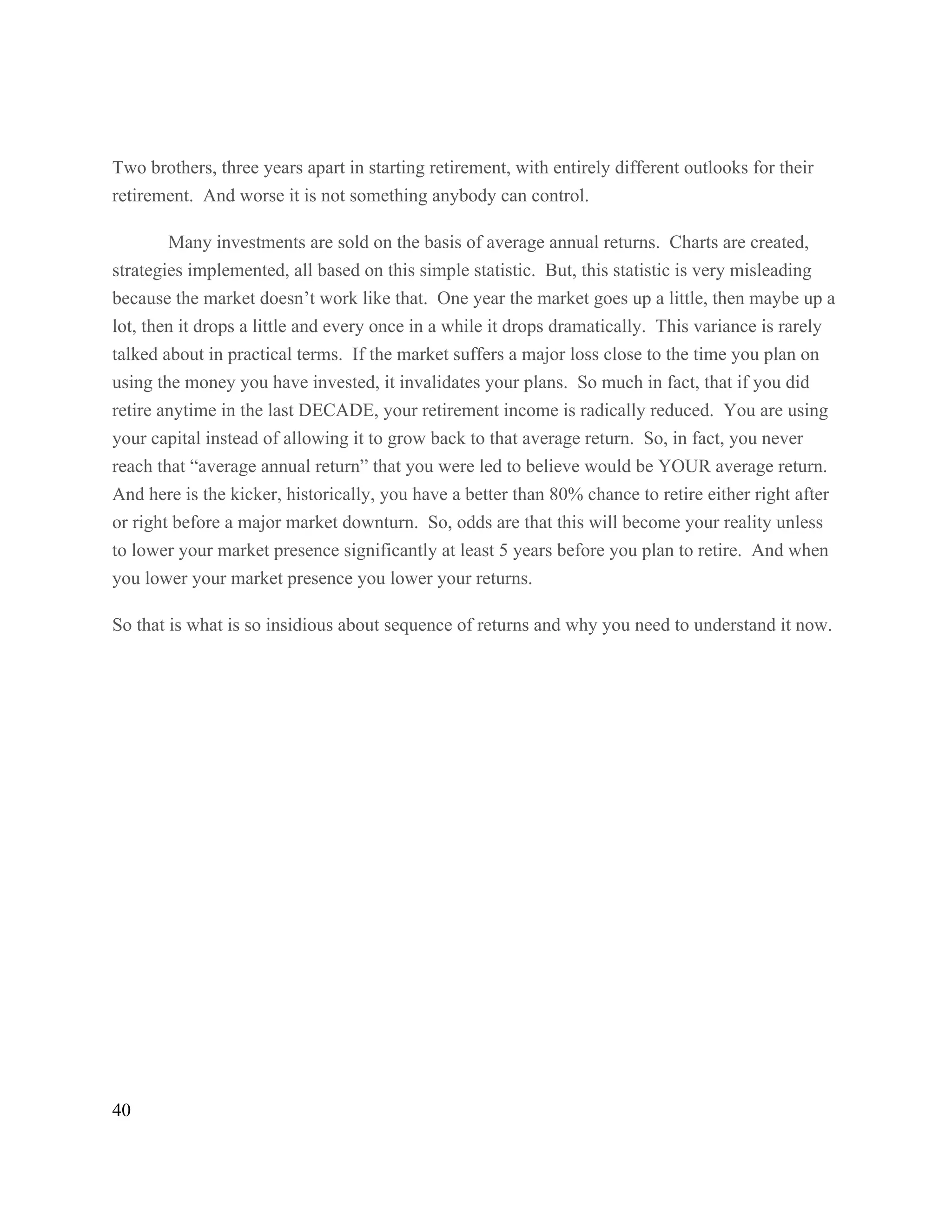
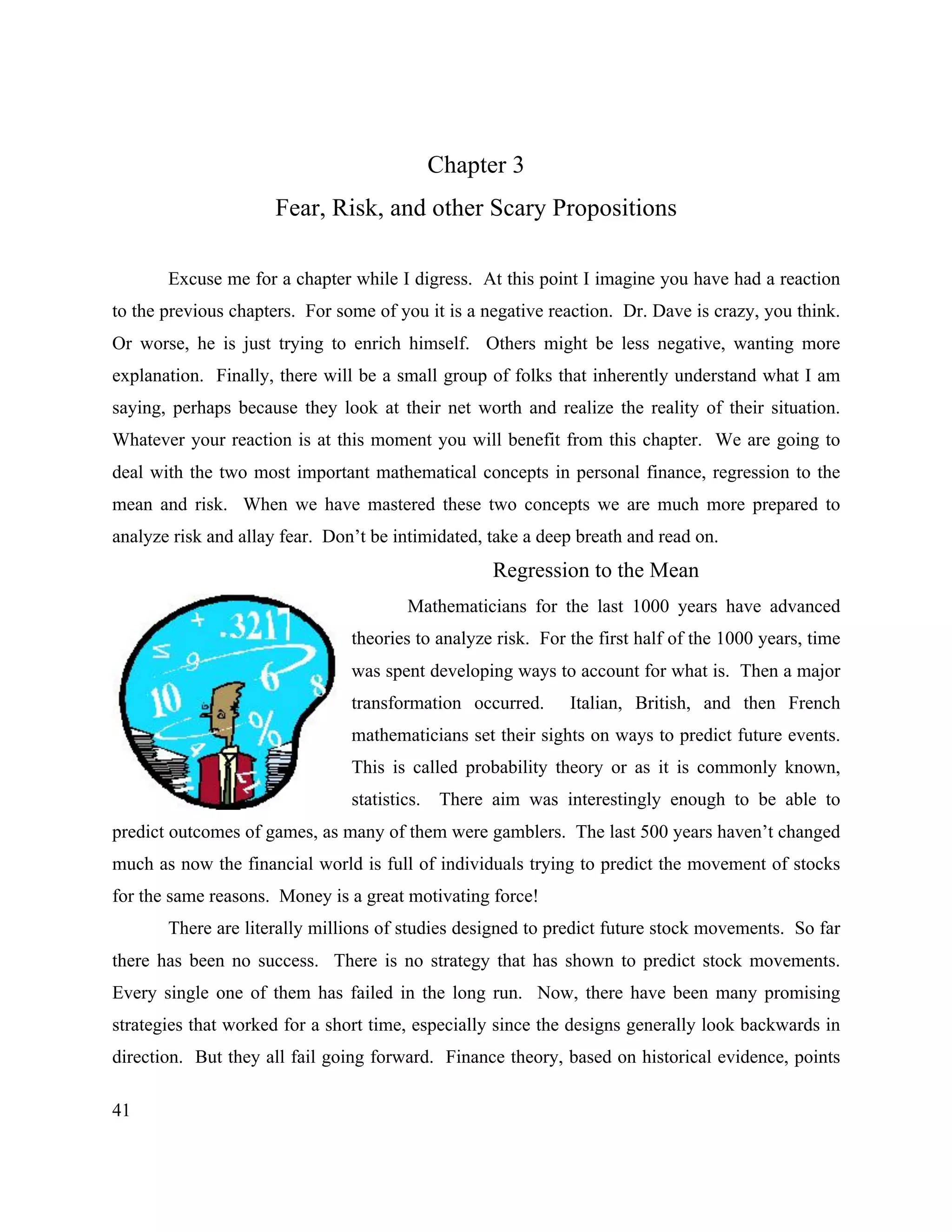
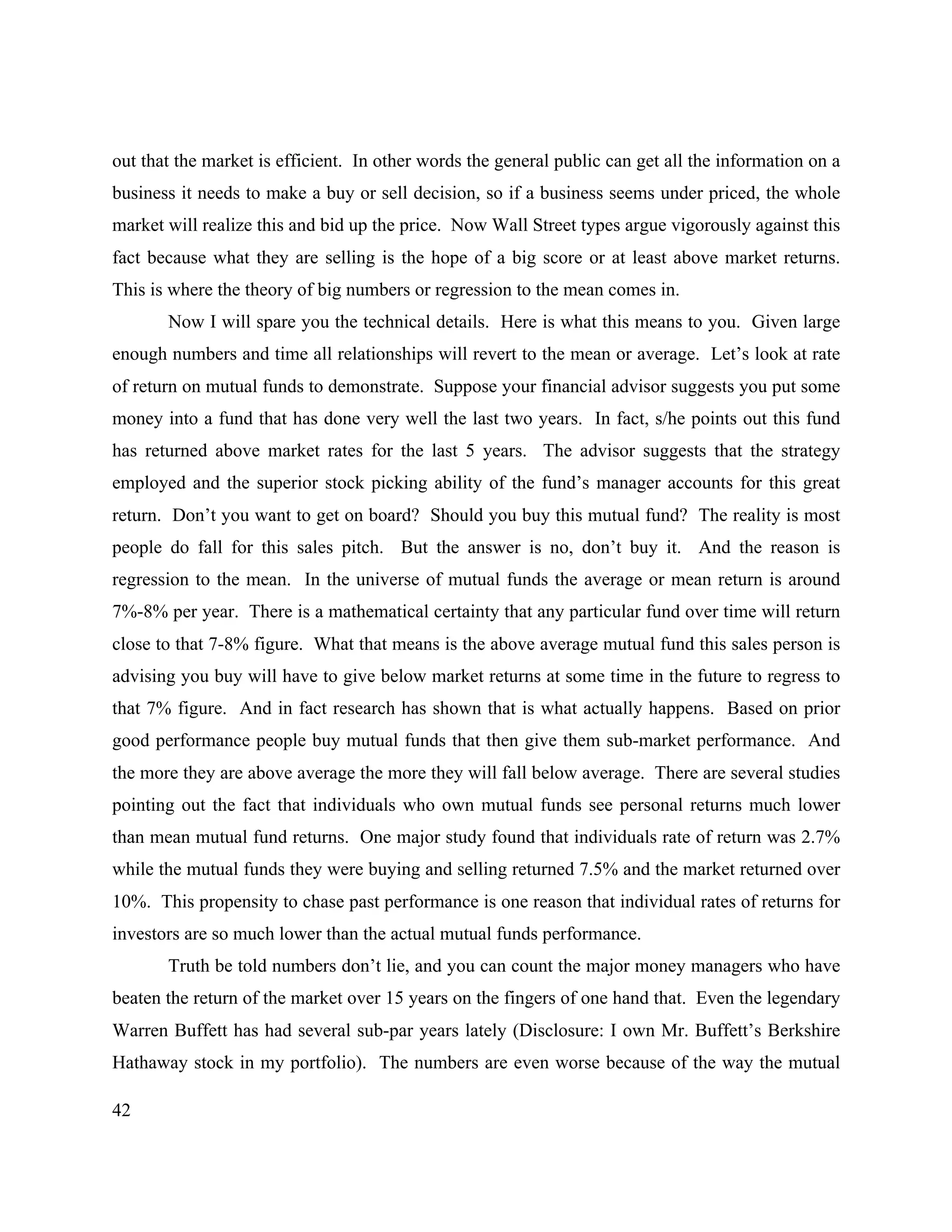

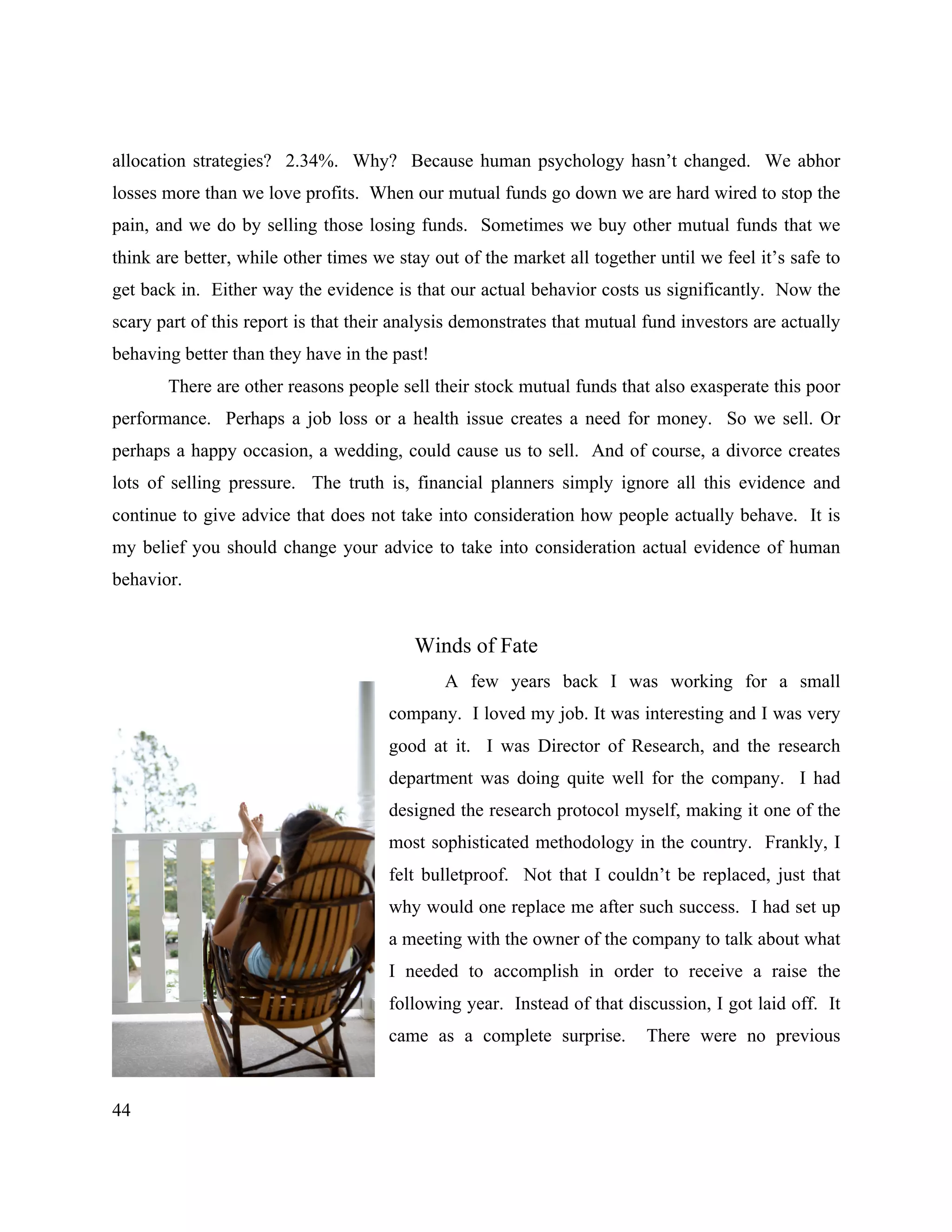
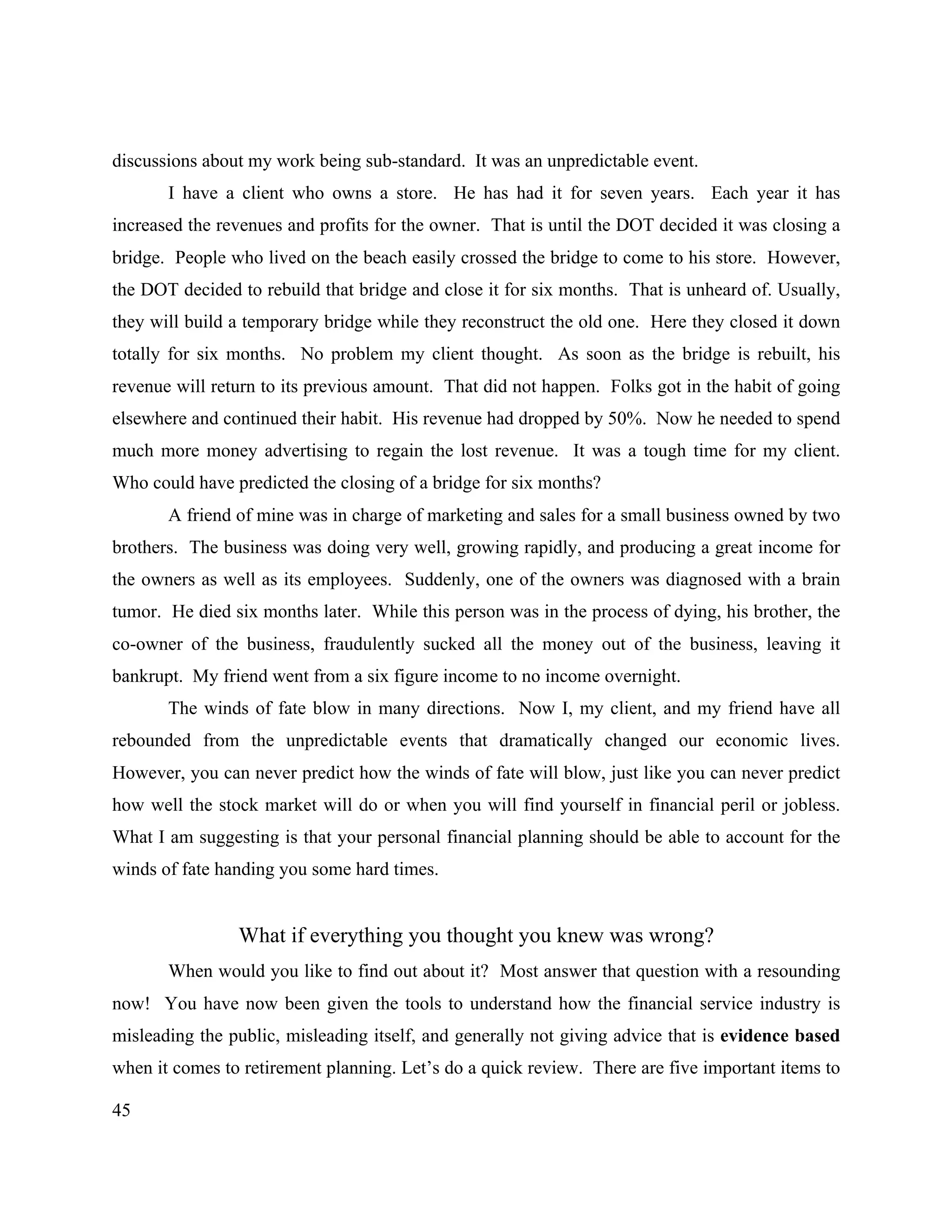


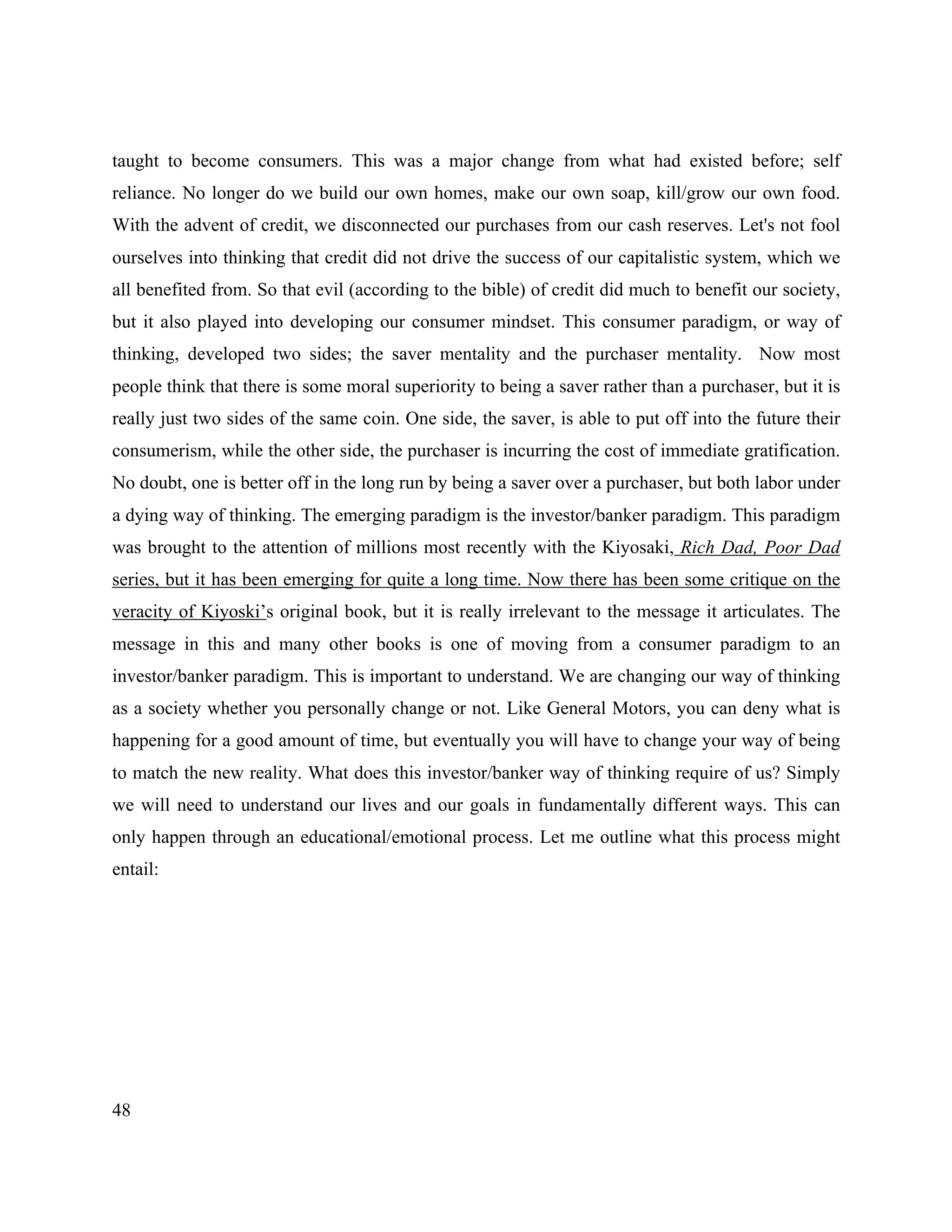
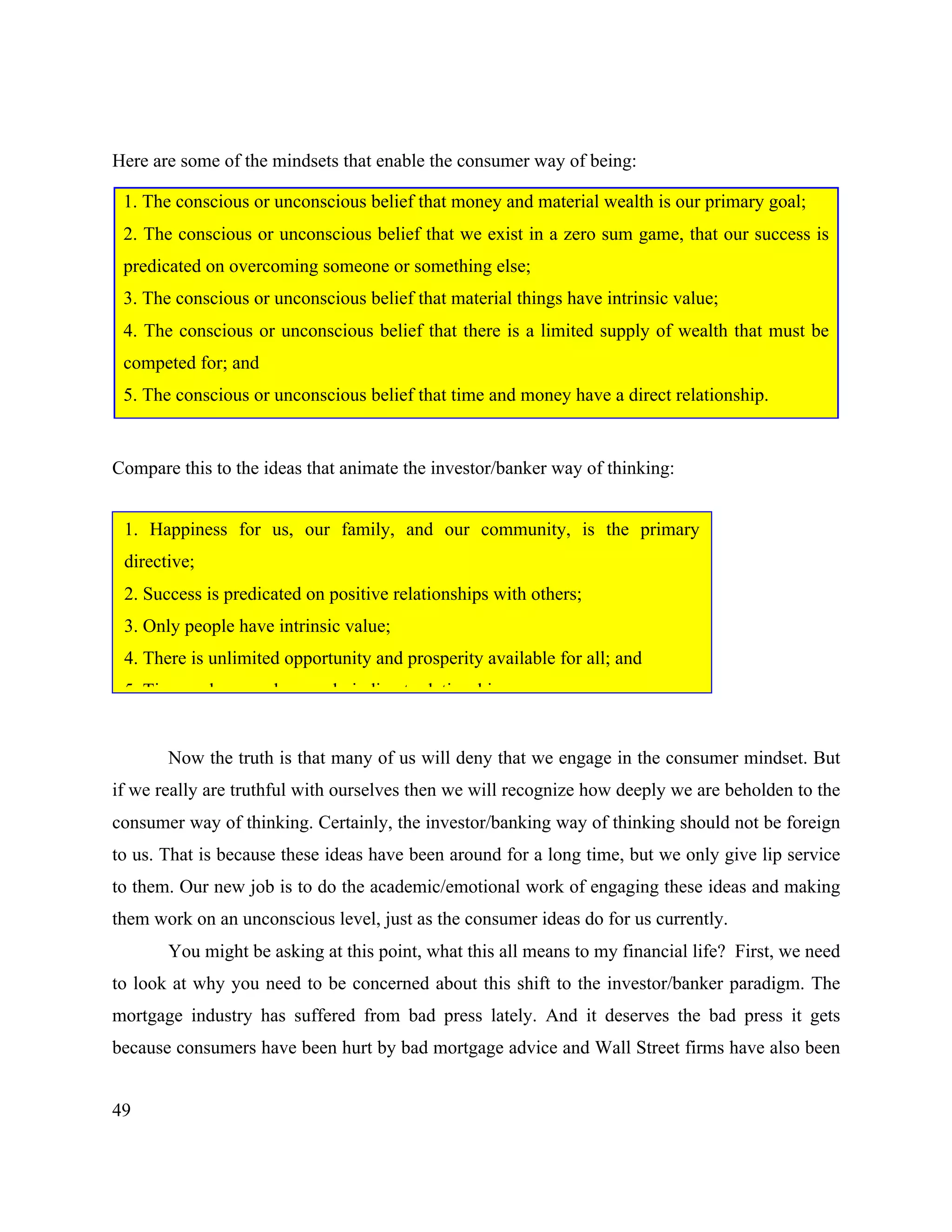
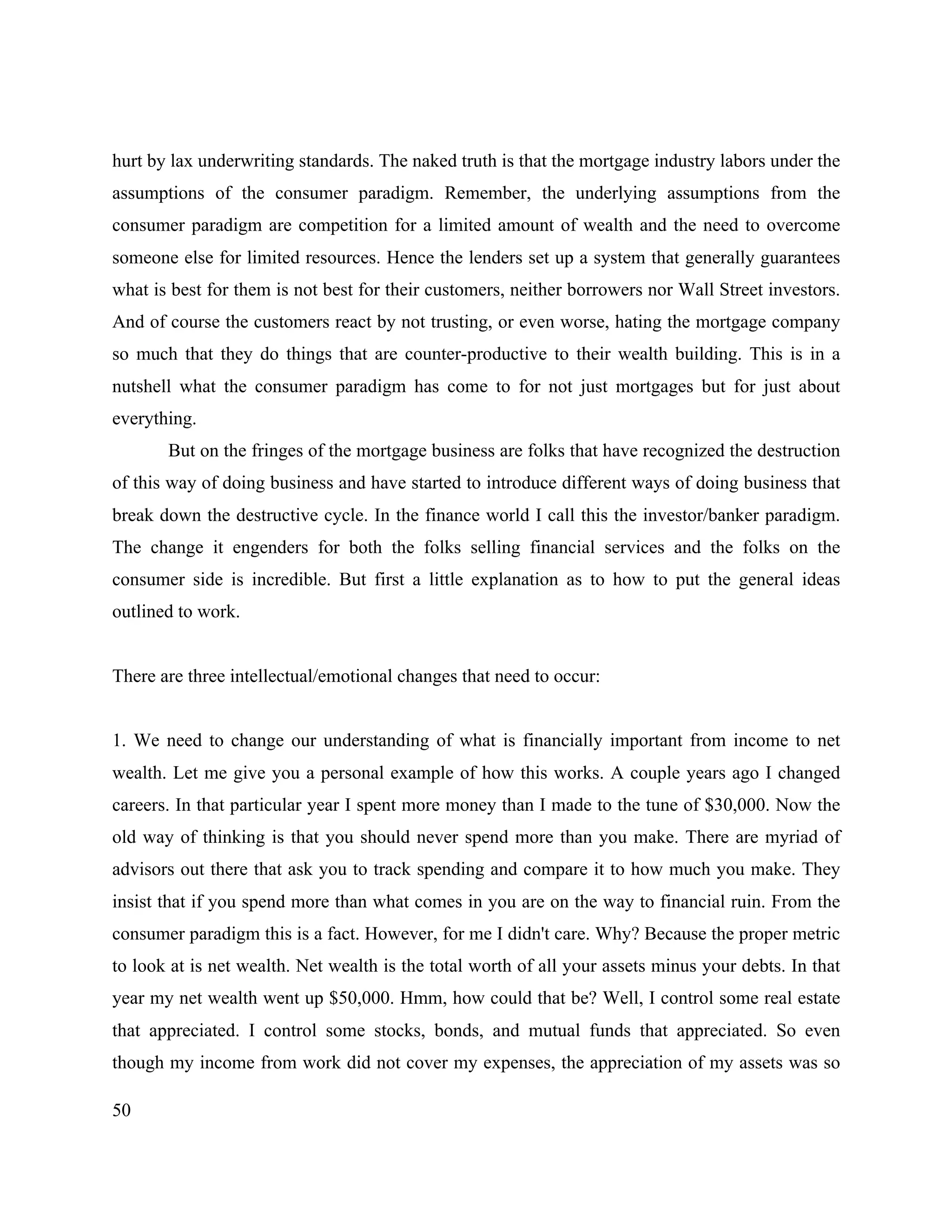
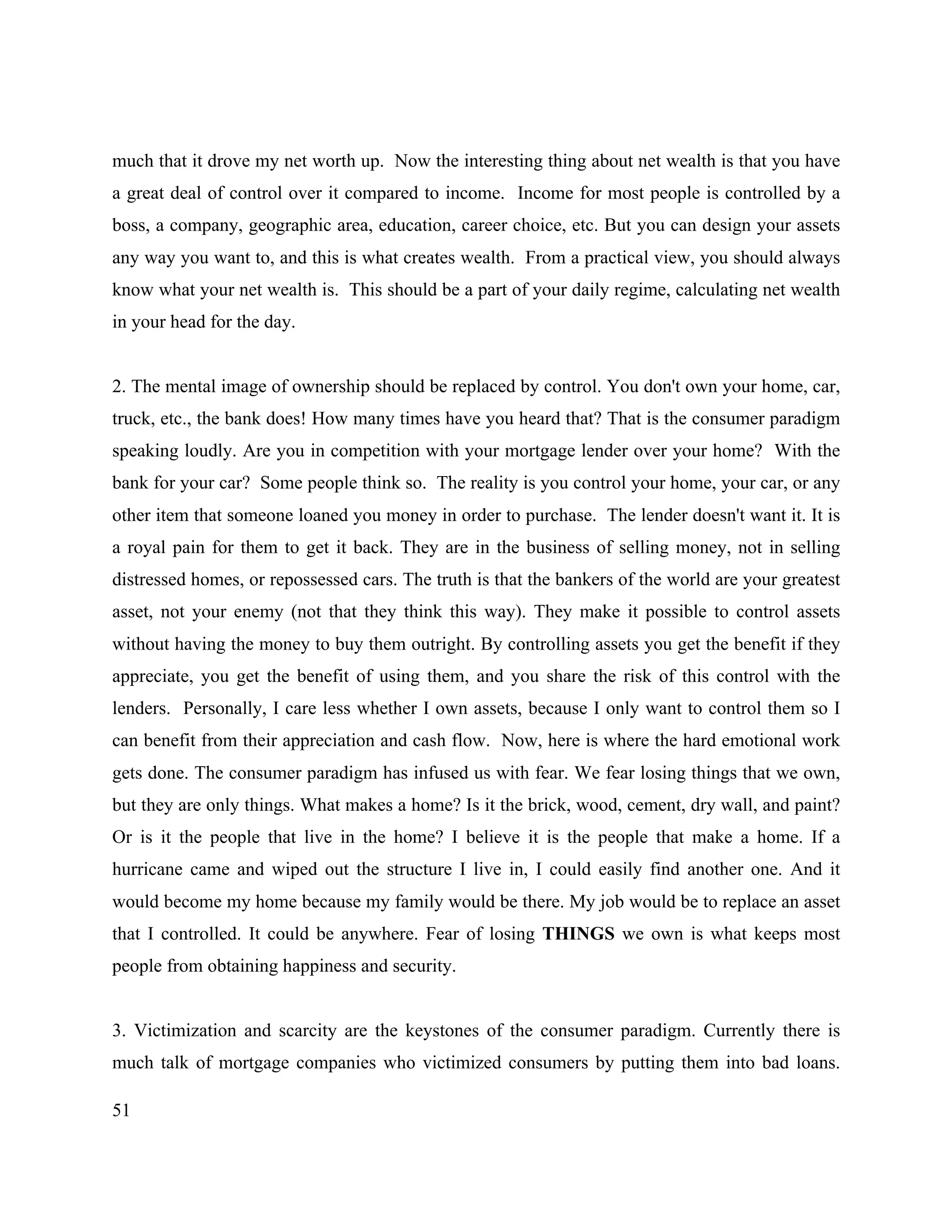
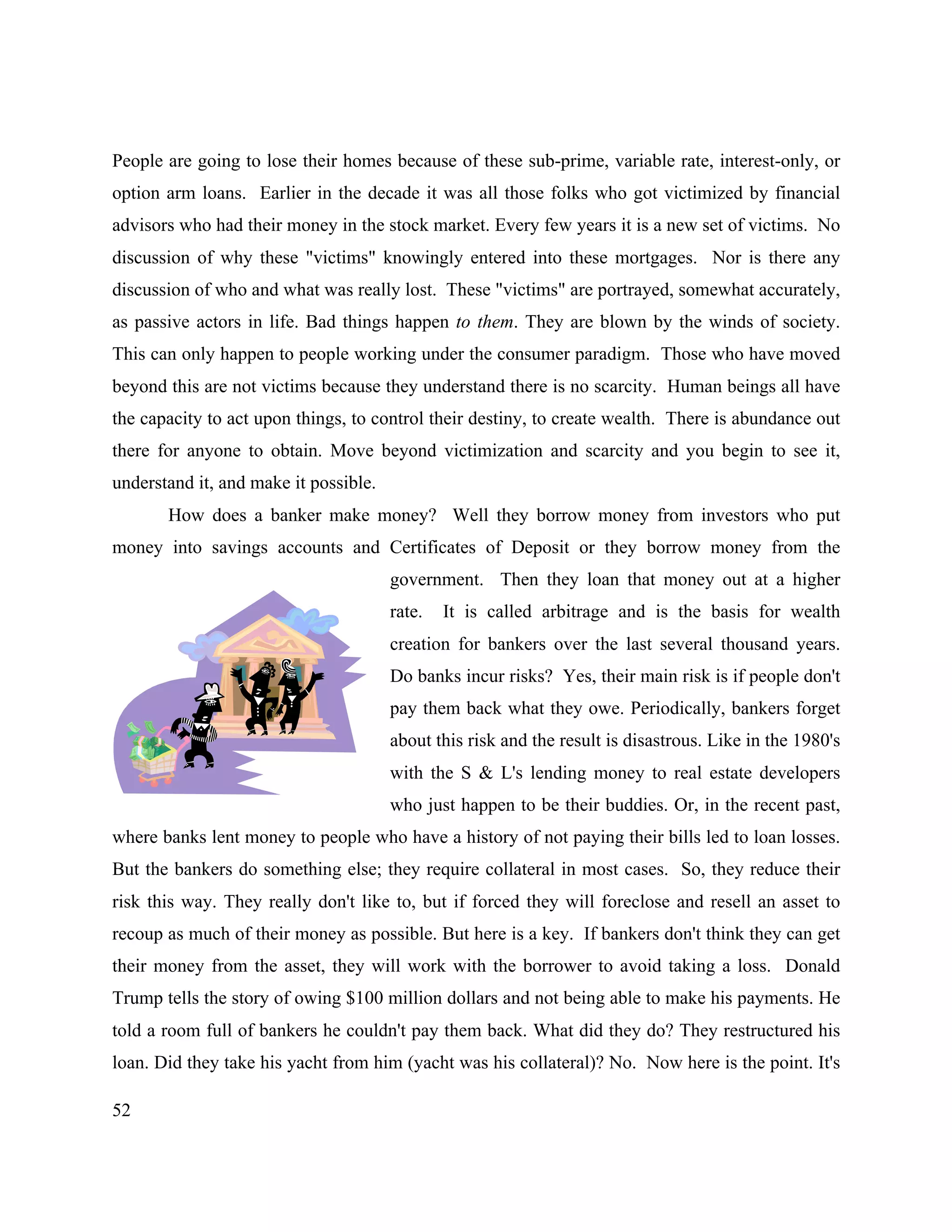
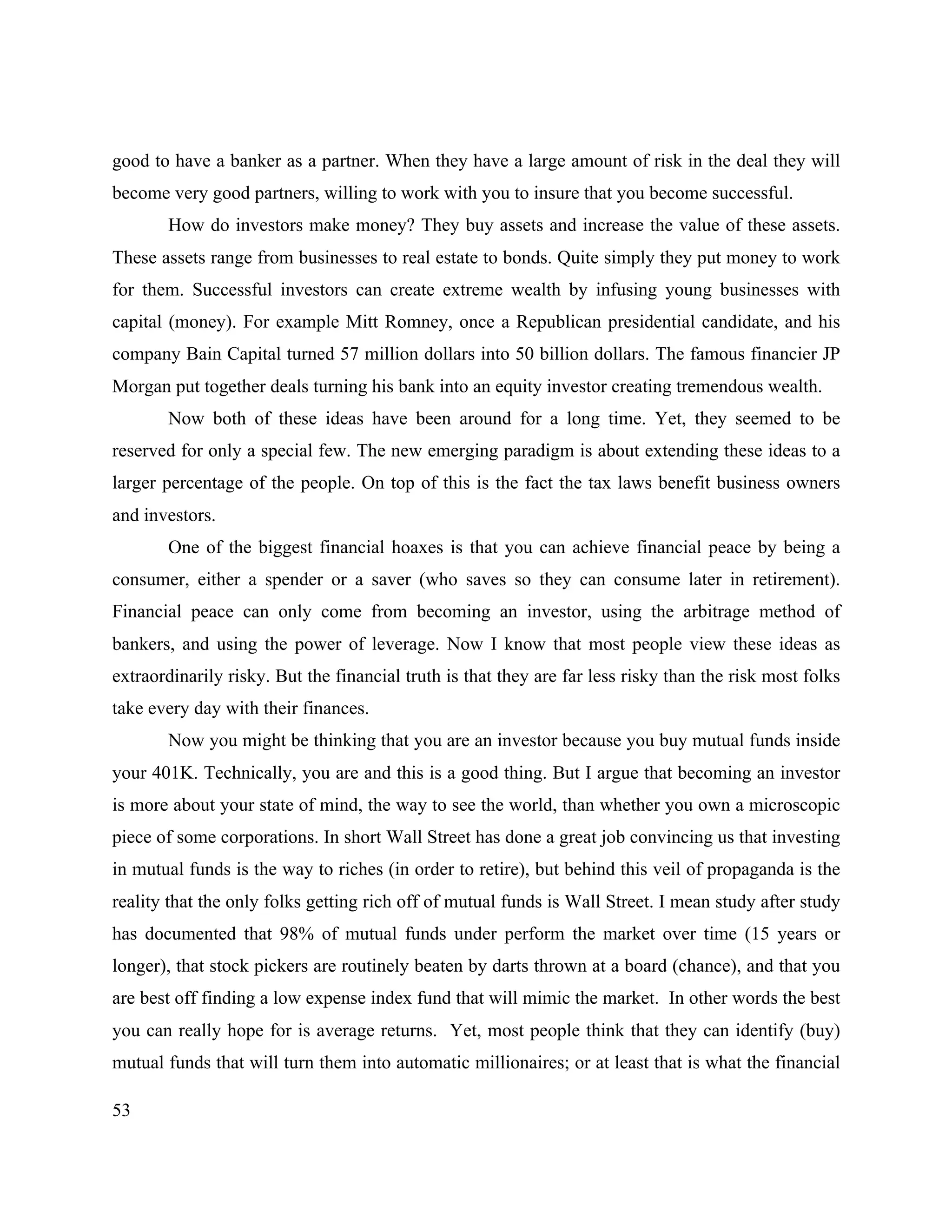
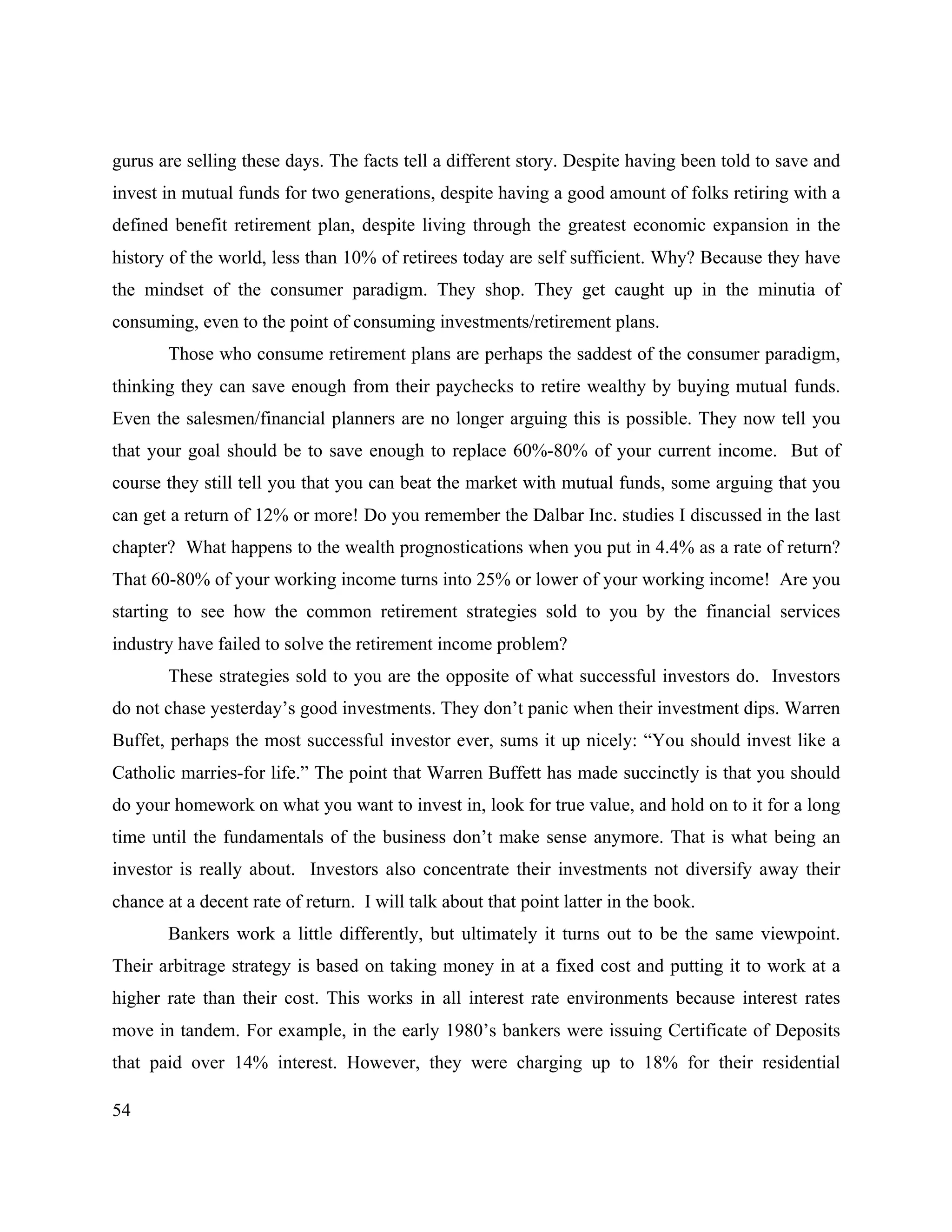
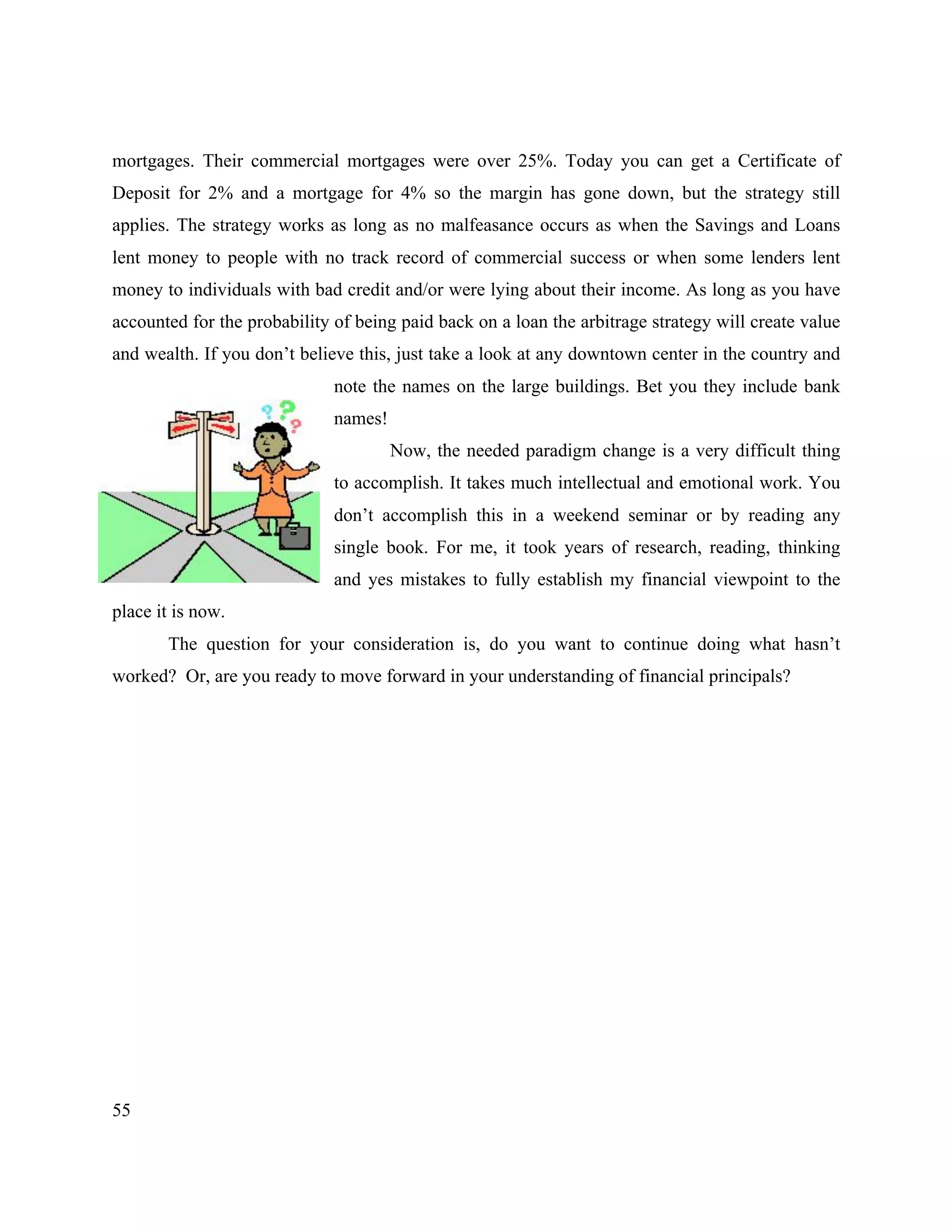
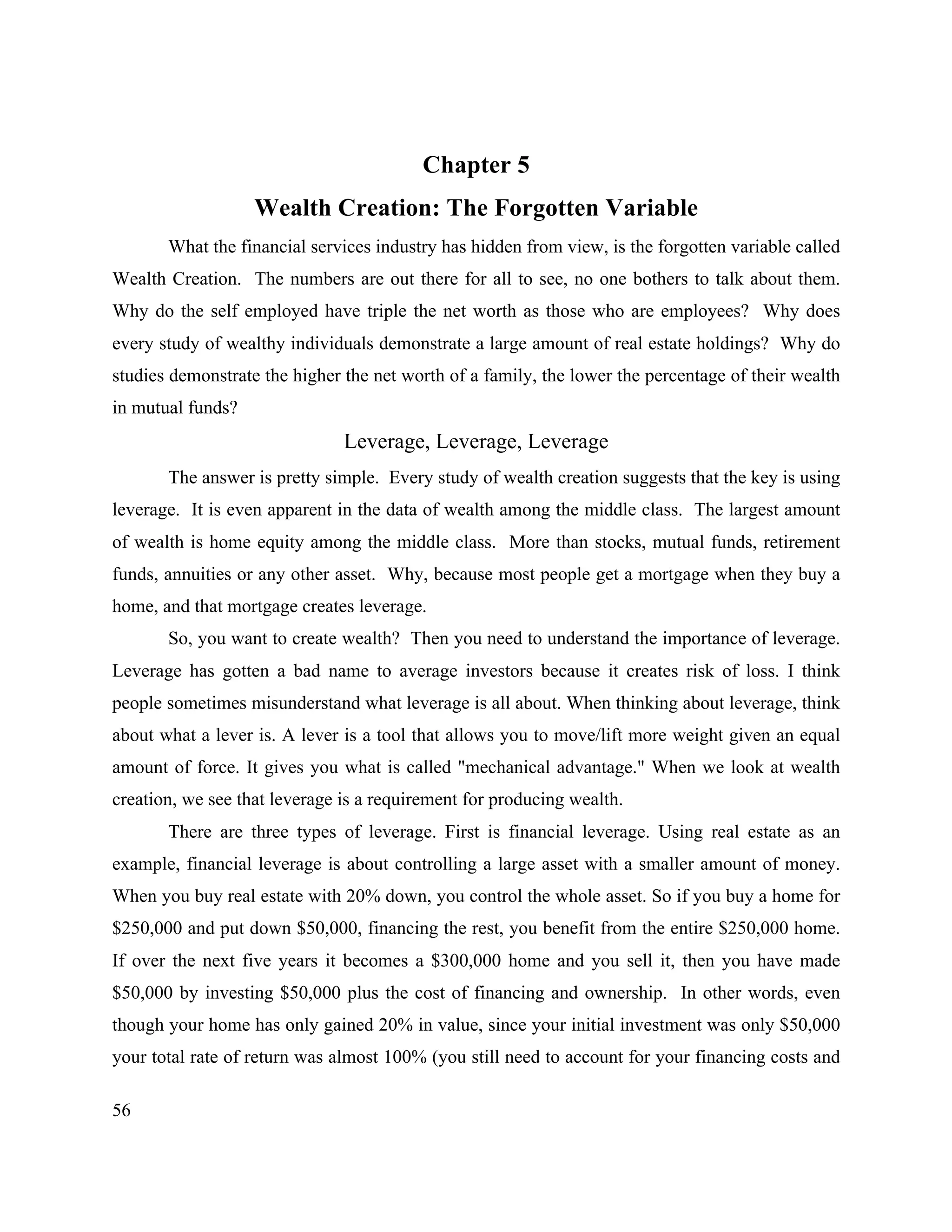
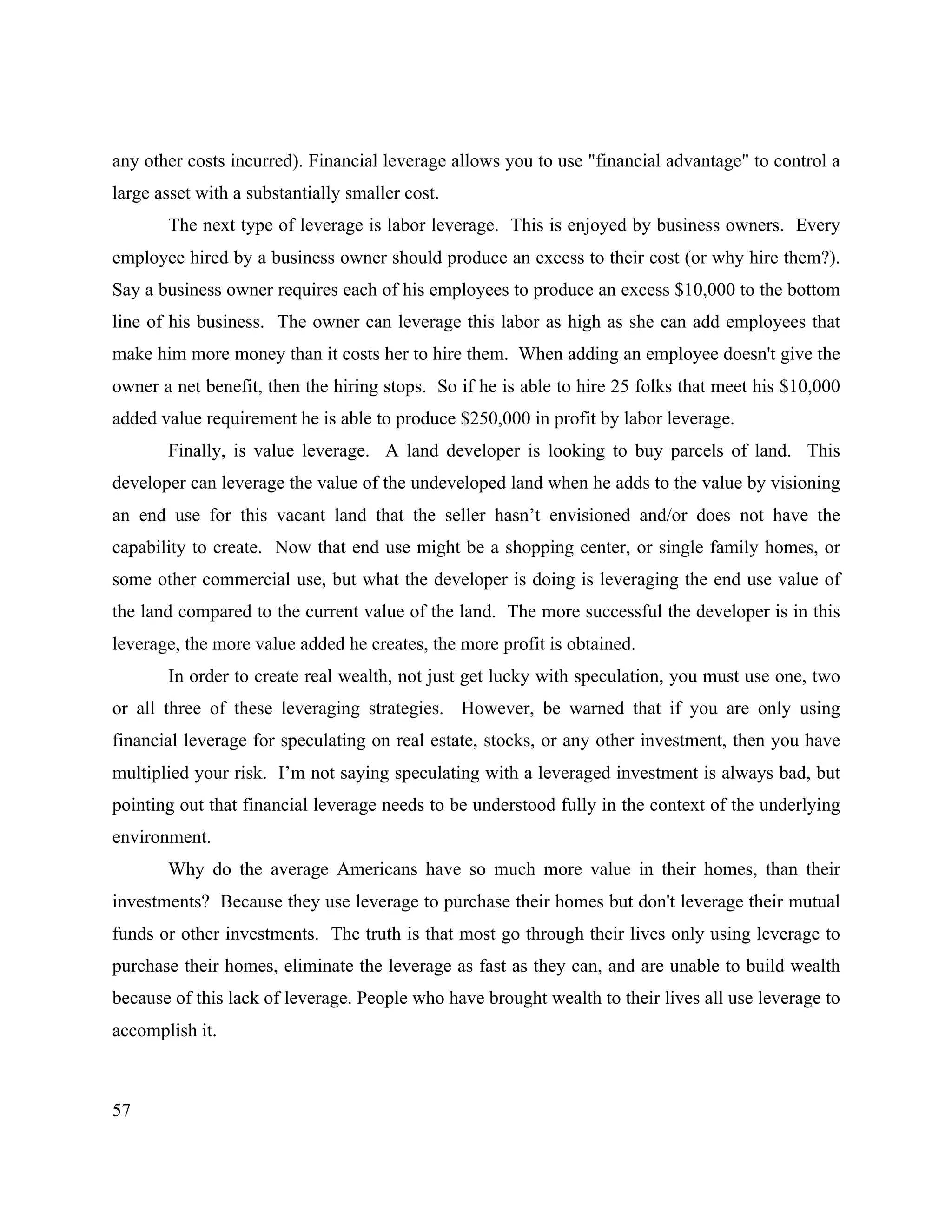

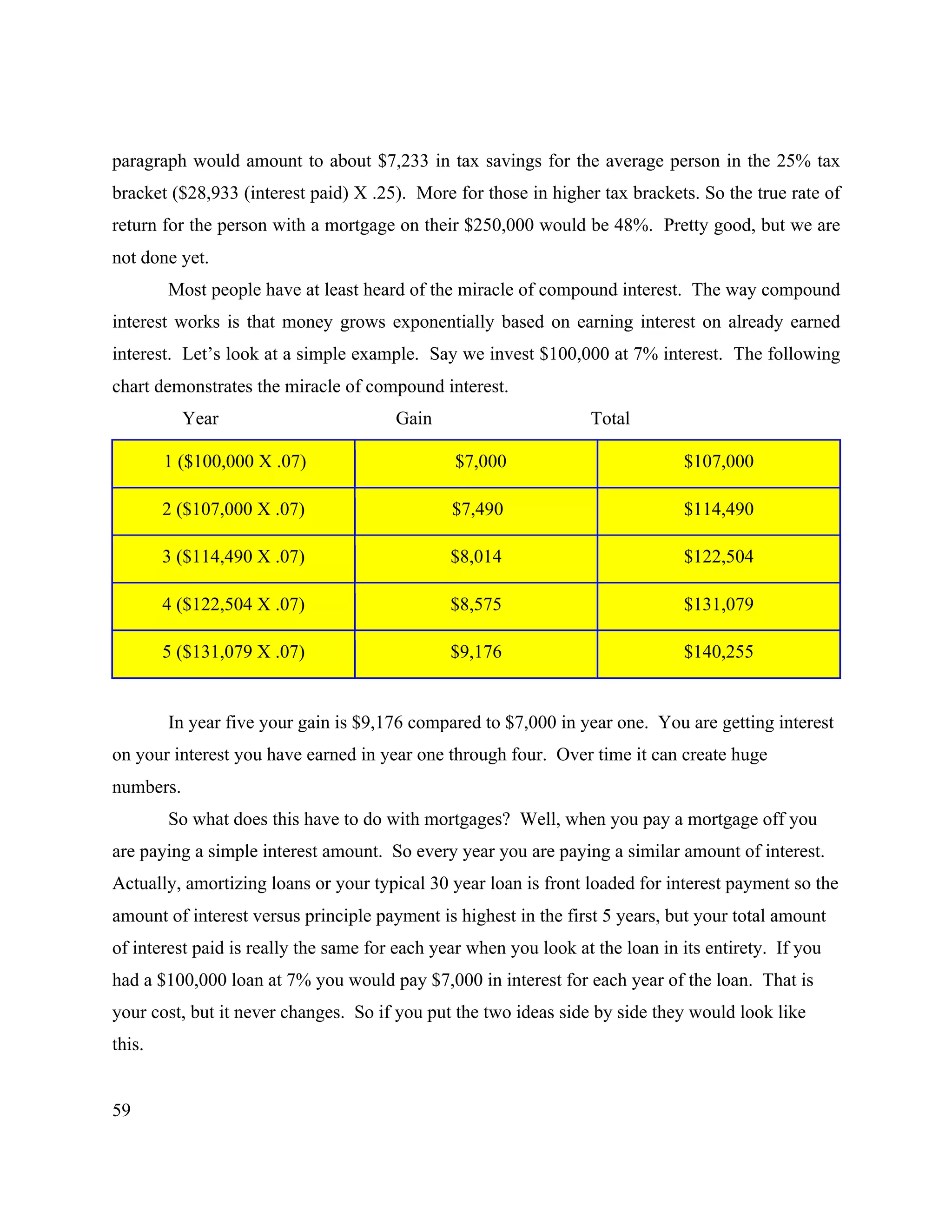
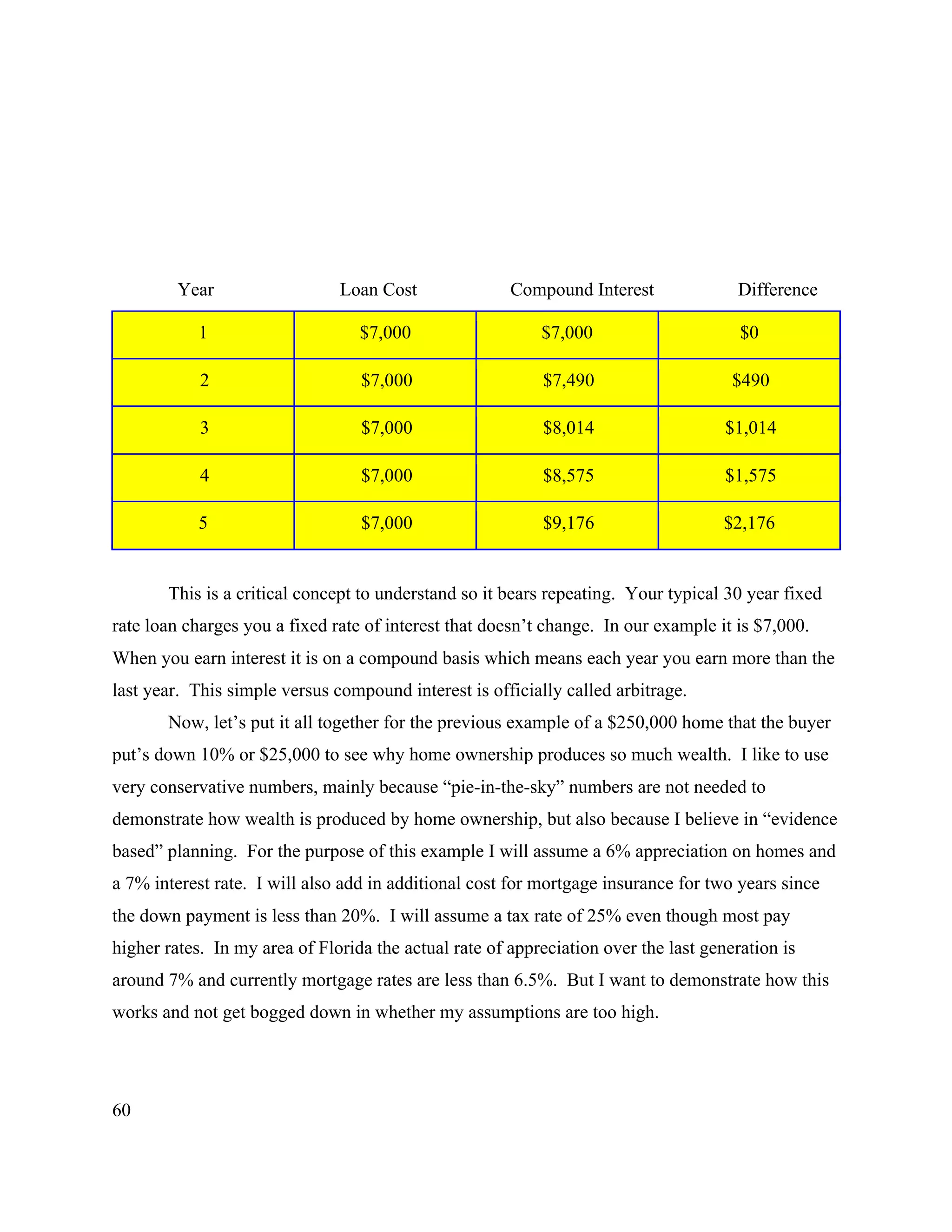
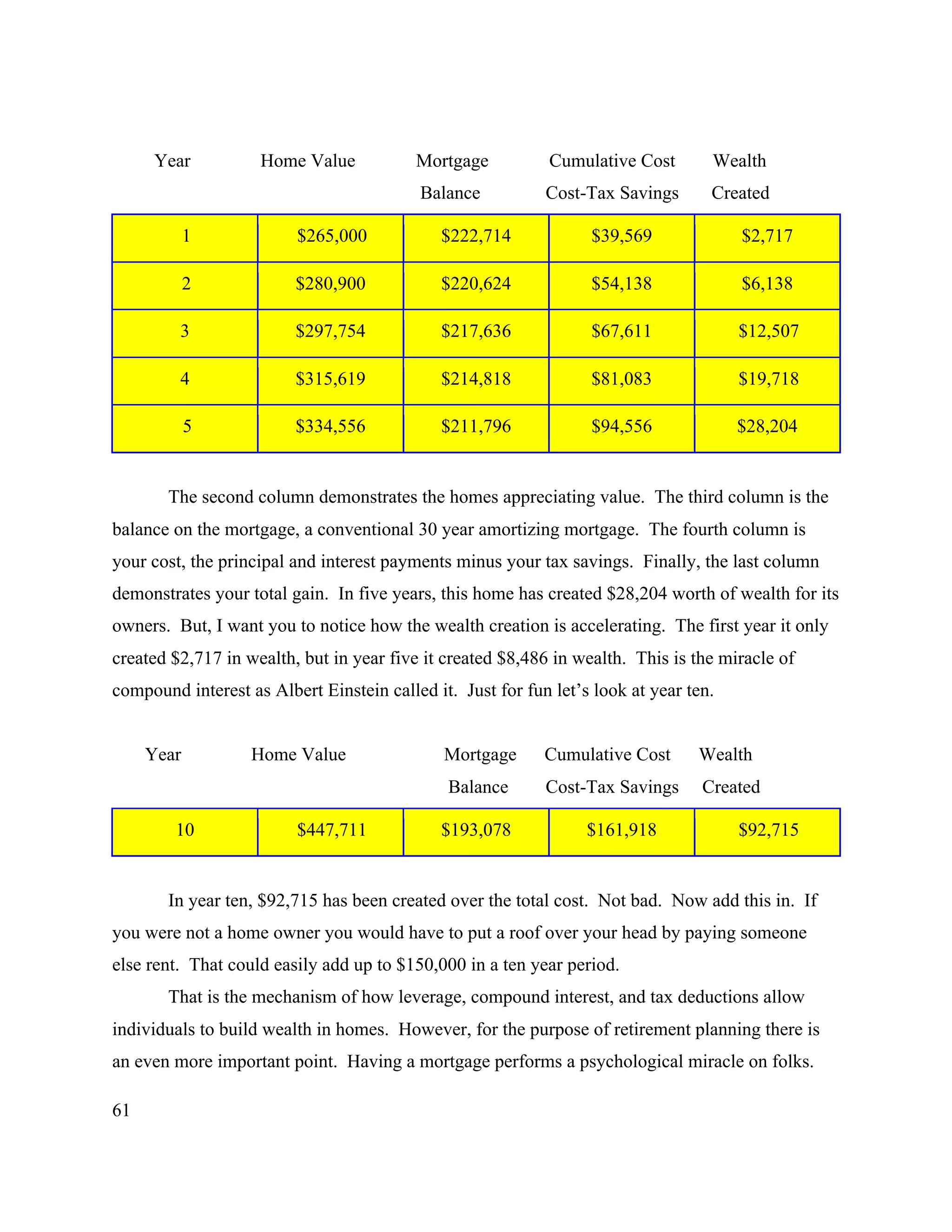
![62
People who can’t or won’t save money make sure that they pay their mortgage no matter what
else is going on in their life. In other words a mortgage creates compliant savers. It is a forced
savings account. Financial planners know that a vast majority of people, even the most
motivated savers, fail at some point in saving money. Maybe it is a job loss, a private school for
junior, or a new car, but in everyday reality there are times that we aren’t able to save.
We have data on mortgage foreclosure rates that tells us that 99% of people make their
mortgage payments. That’s right Americans have a 99% compliance rate with this mortgage
savings program. Even that number is really misleading. We, by and large, are much more
compliant than that. Over the last twenty years, until 2006, the foreclosure rate for “prime”
mortgages, those with individuals who have a good credit history, has ranged from .4% to 1.3%.
For sub-prime borrowers it has ranged from 3.3% to 18%, but these borrowers are sub-prime
because they have a history of failing to pay their bills. The vast majority of us pay our bills, and
when we look at them, 99.5% make those mortgage payments. This is really the key idea. This
is the secret of how mortgages create wealth better than stock/mutual fund investing, bond
investing, or even simple savings accounts. Now the foreclosure rate has skyrocketed since
2006. The reasons are well discussed in the mass media. Let’s suffice it to say that we are going
through unprecedented times. But this too will pass. And with the passing of the new financial
services laws, those that attempt to behave recklessly [no liquidity, not enough income to cover
loans, etc.] will not find it so easy to get into trouble. We will get back to the time where 99% of
us make our mortgage payments.
This is the “evidence” that leads us to successful wealth creation. Take an appreciating
asset and combine it with 99% compliance, and you have the first step to wealth creation. This is
why I started this section, rather cheekily, telling you that you should start every morning trying
to figure out how to have larger and more mortgages. However, in order to put this wealth to
work for you and turn it into retirement savings home equity must be managed properly.
Risk
The second and equally important concept to understand is what constitutes risk. Risk is
variance. Simply, the more the price a given investment varies from year to year is defined as its
risk. Let’s look at a single stock for example. The downside risk is that the company can go out](https://image.slidesharecdn.com/drdave20102-230209094210-28d544a4/75/Drdave2010_2-pdf-62-2048.jpg)

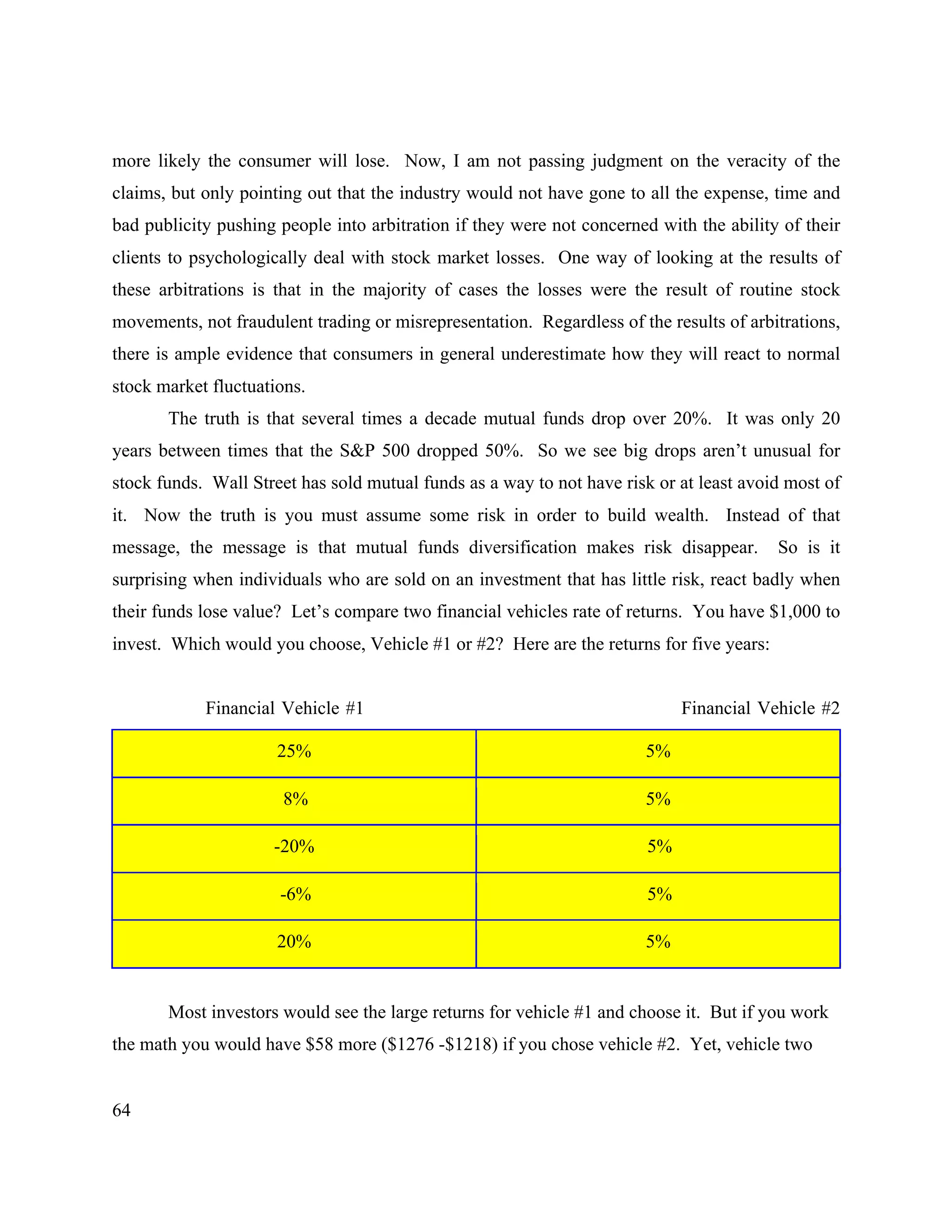
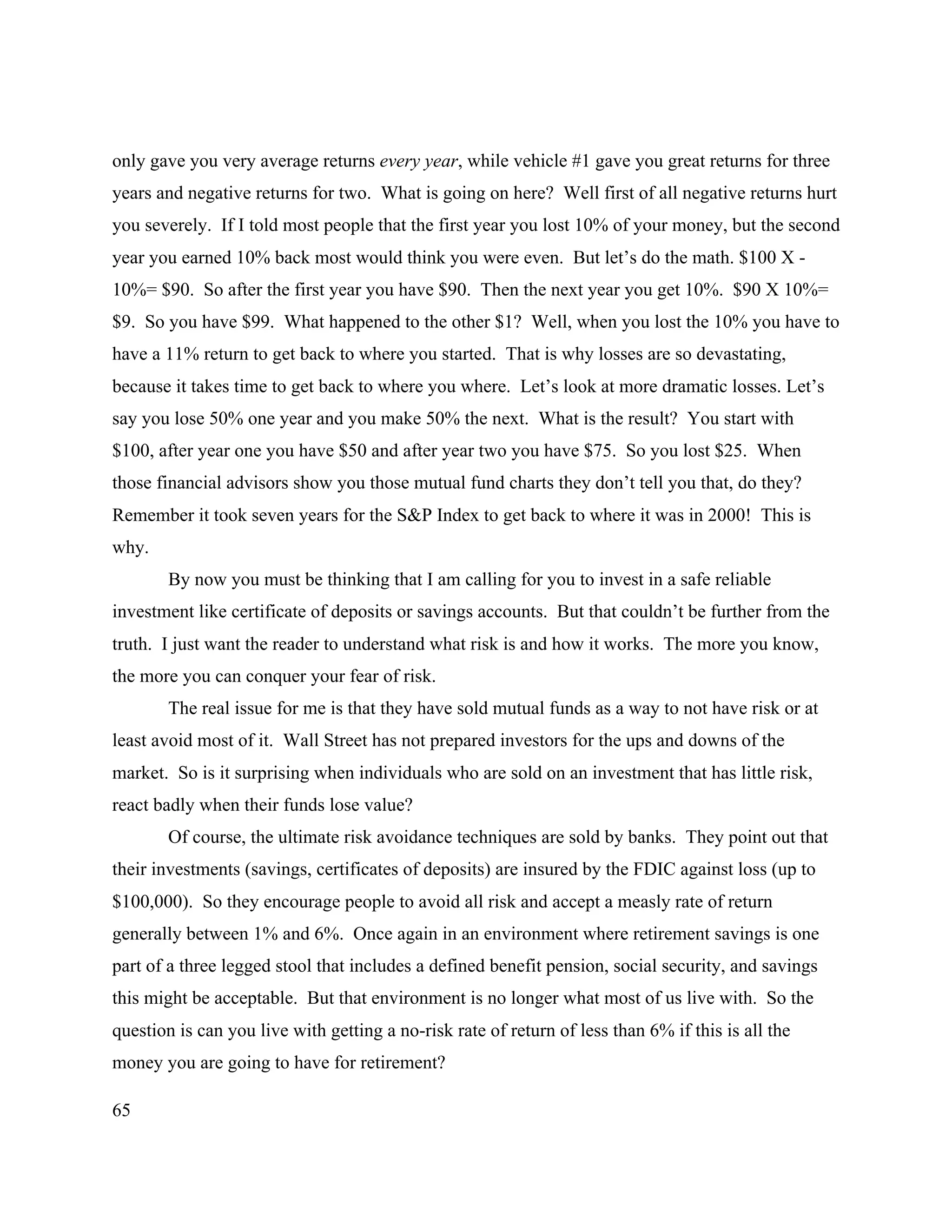
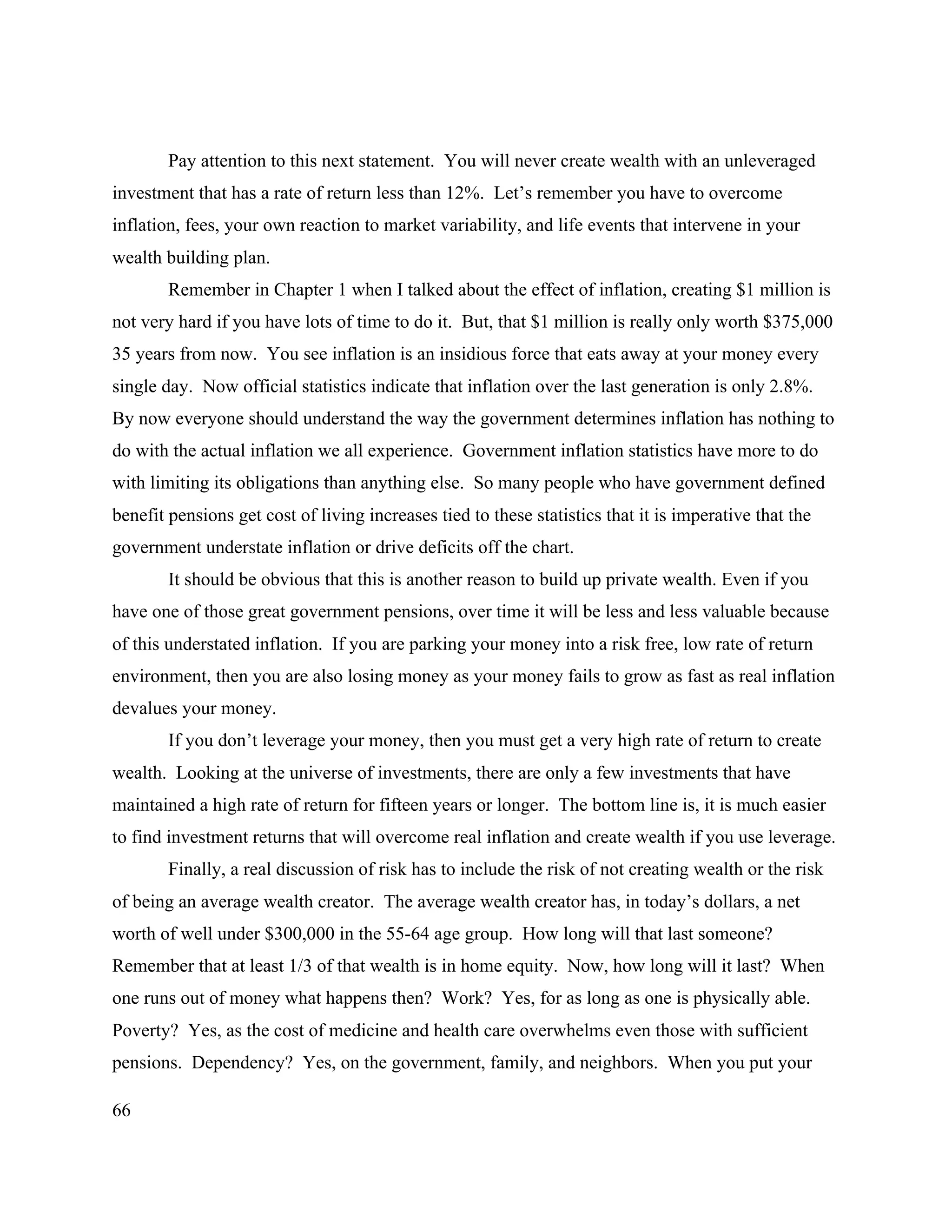

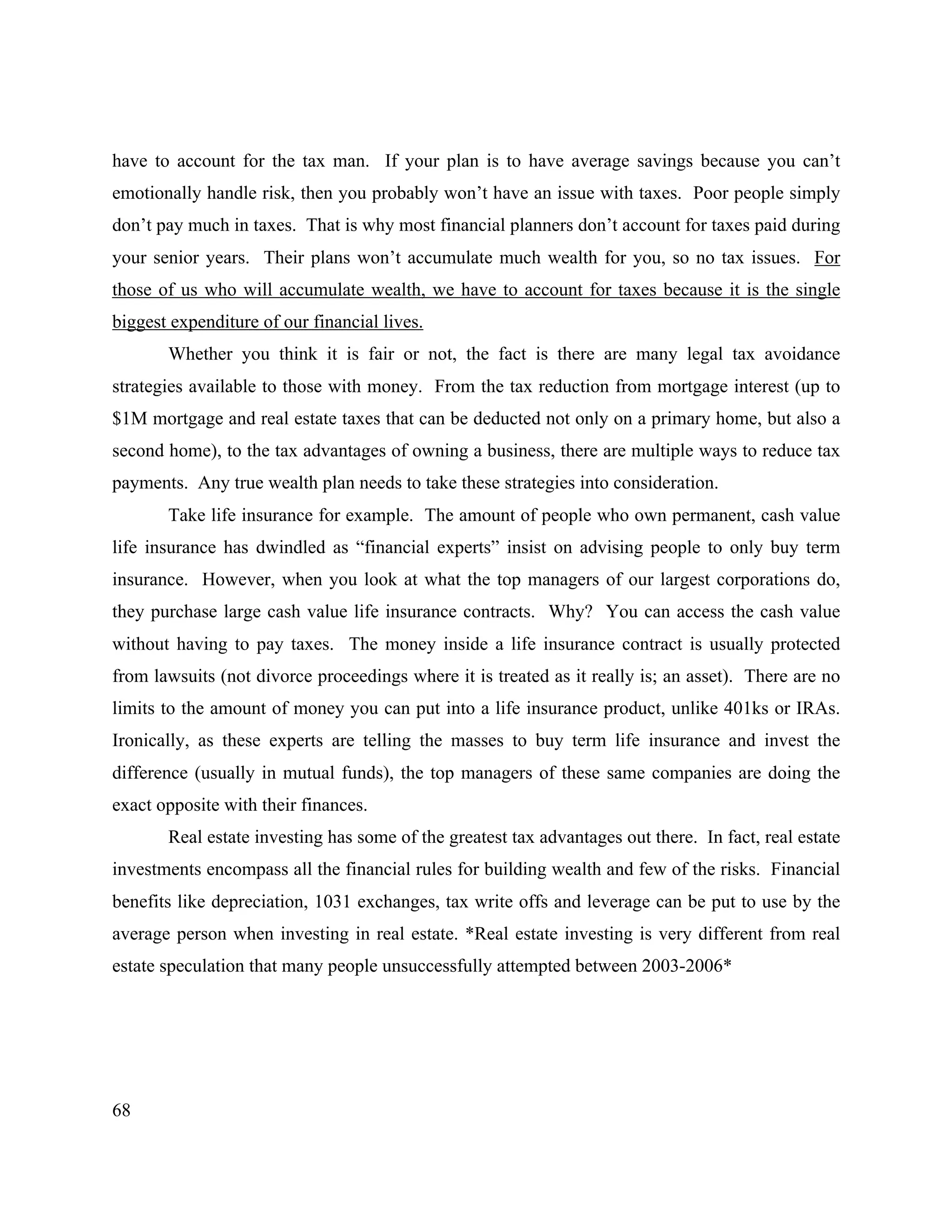
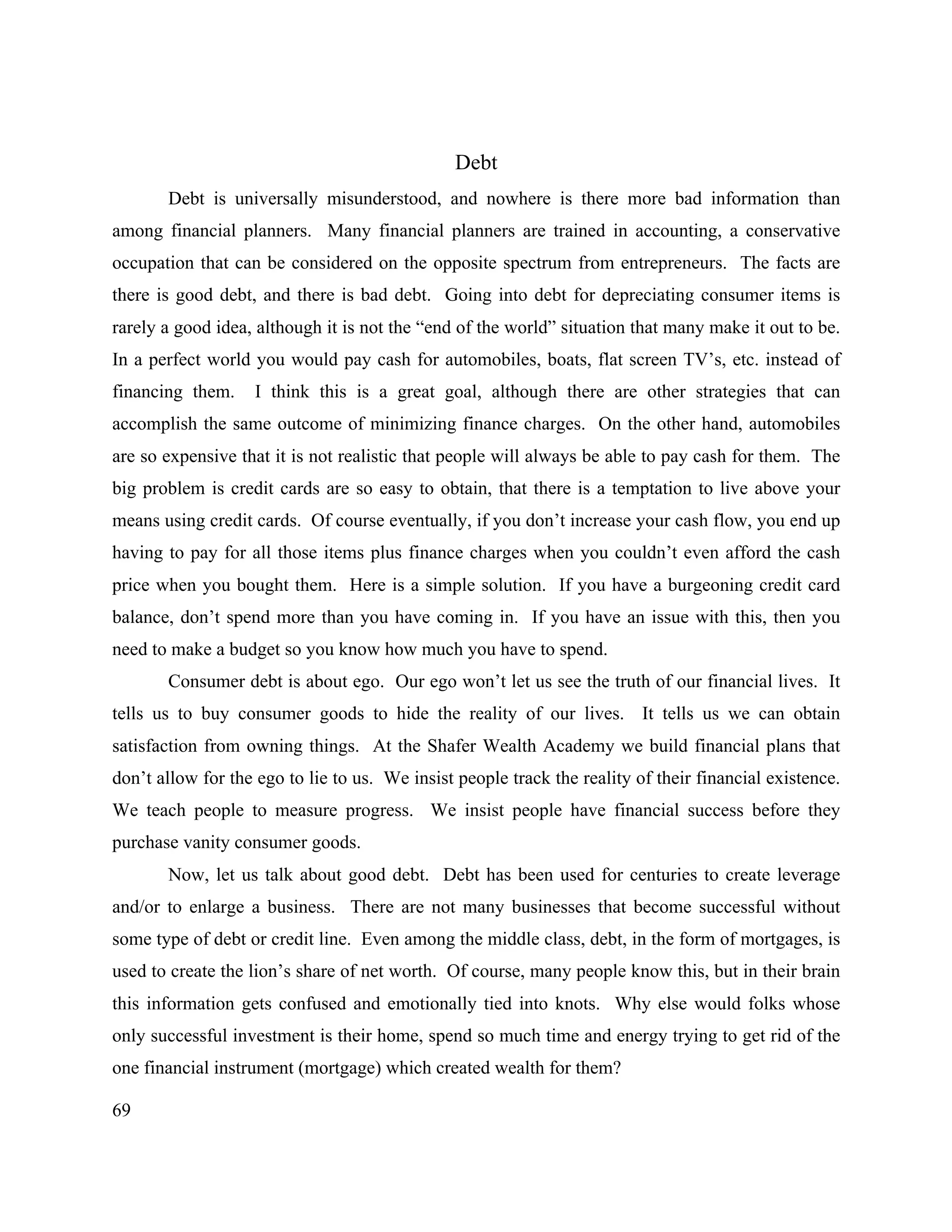
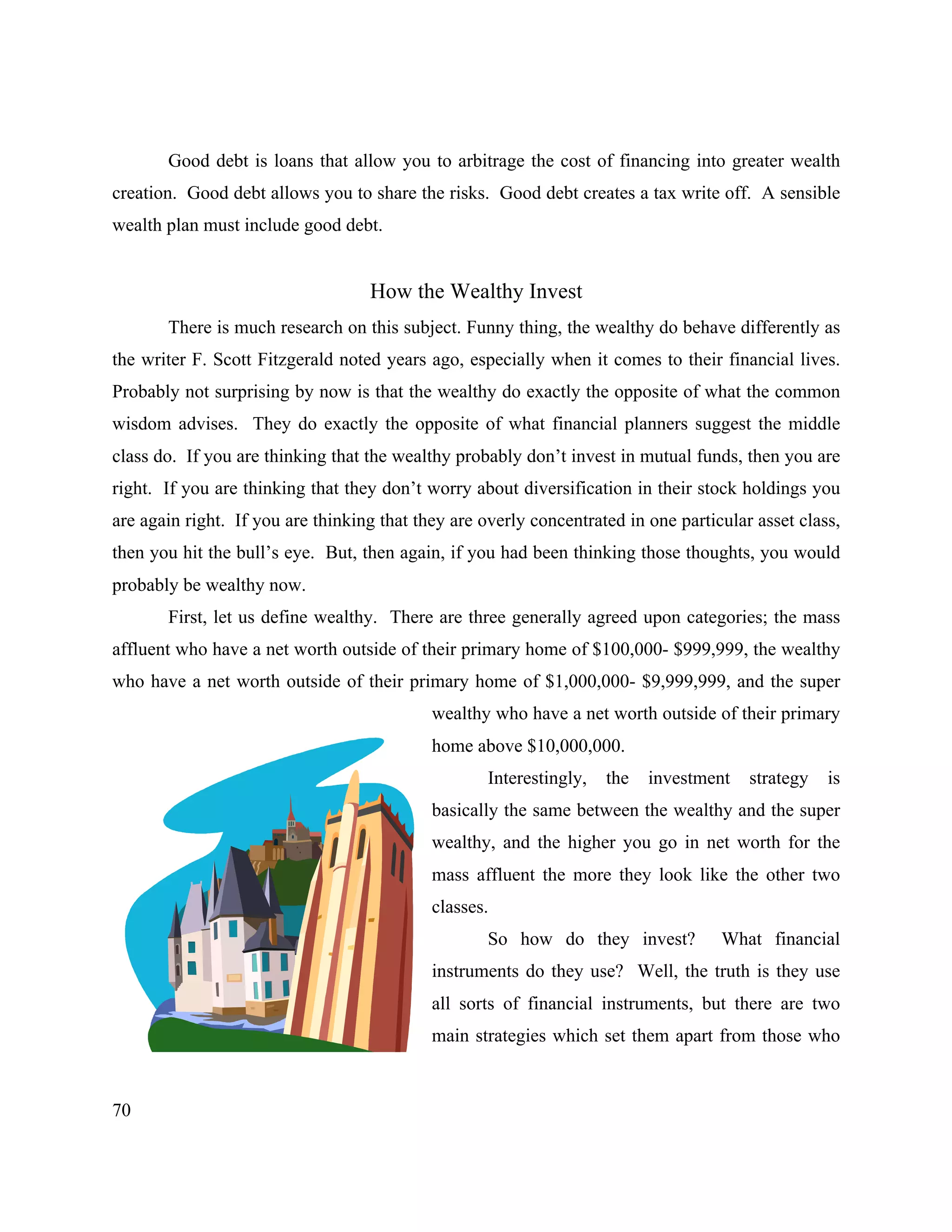
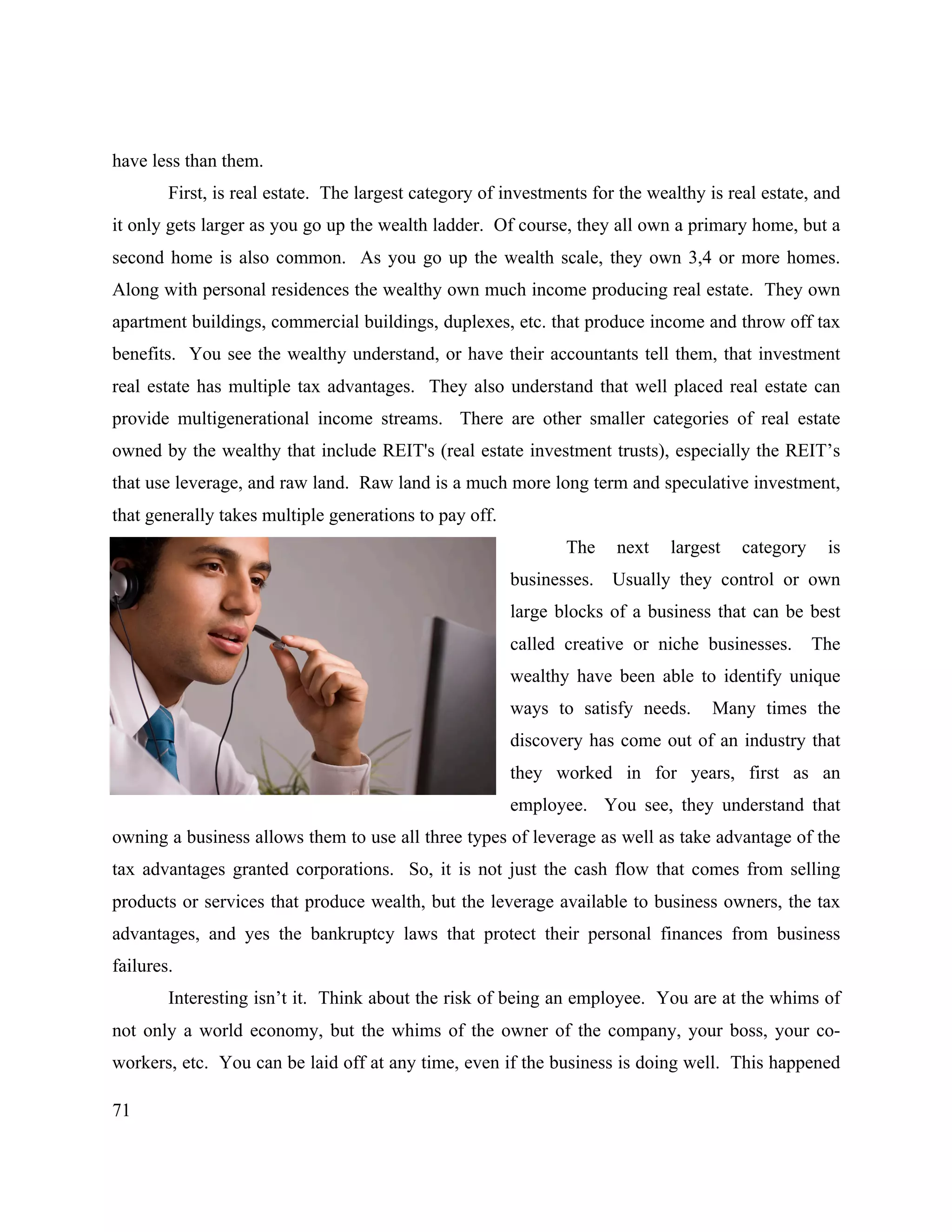
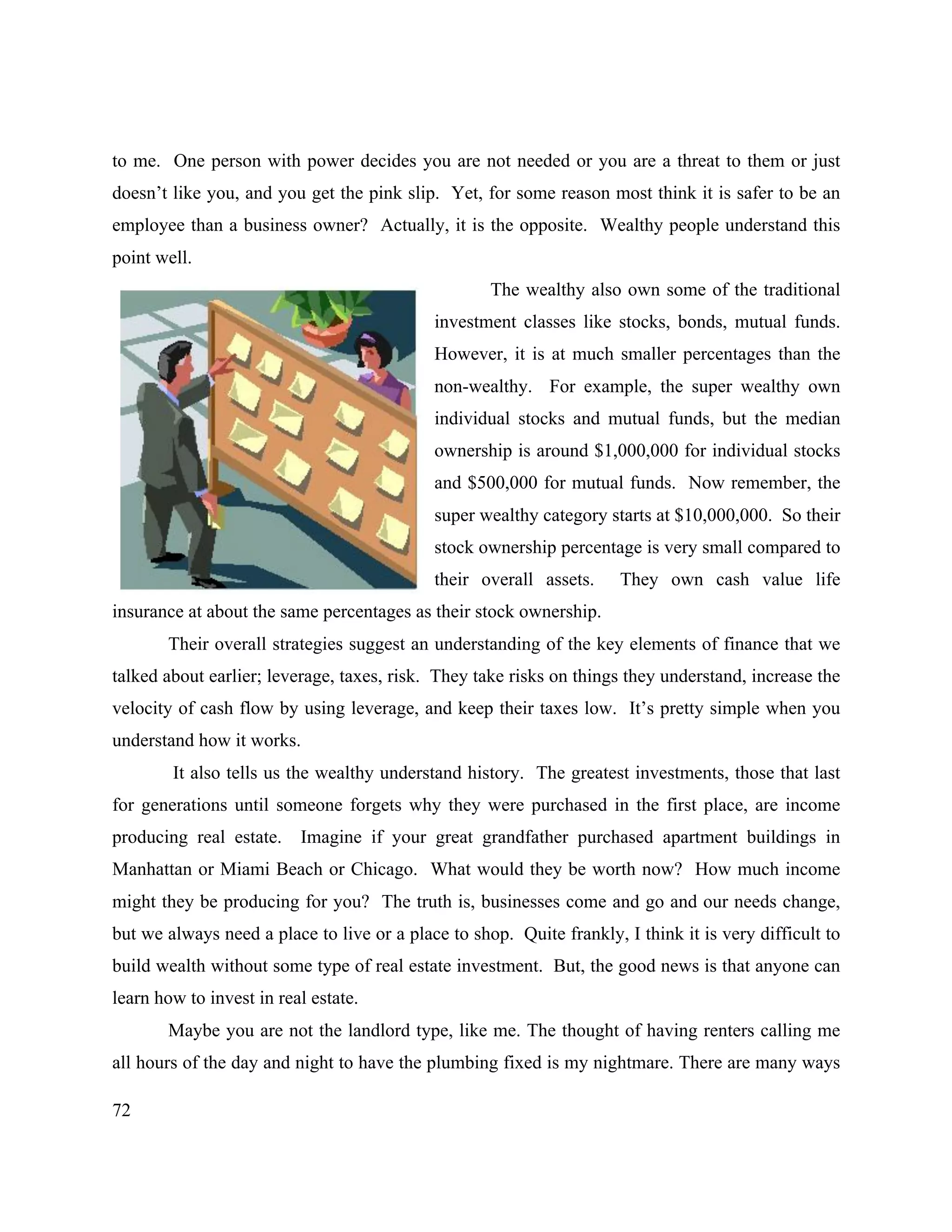
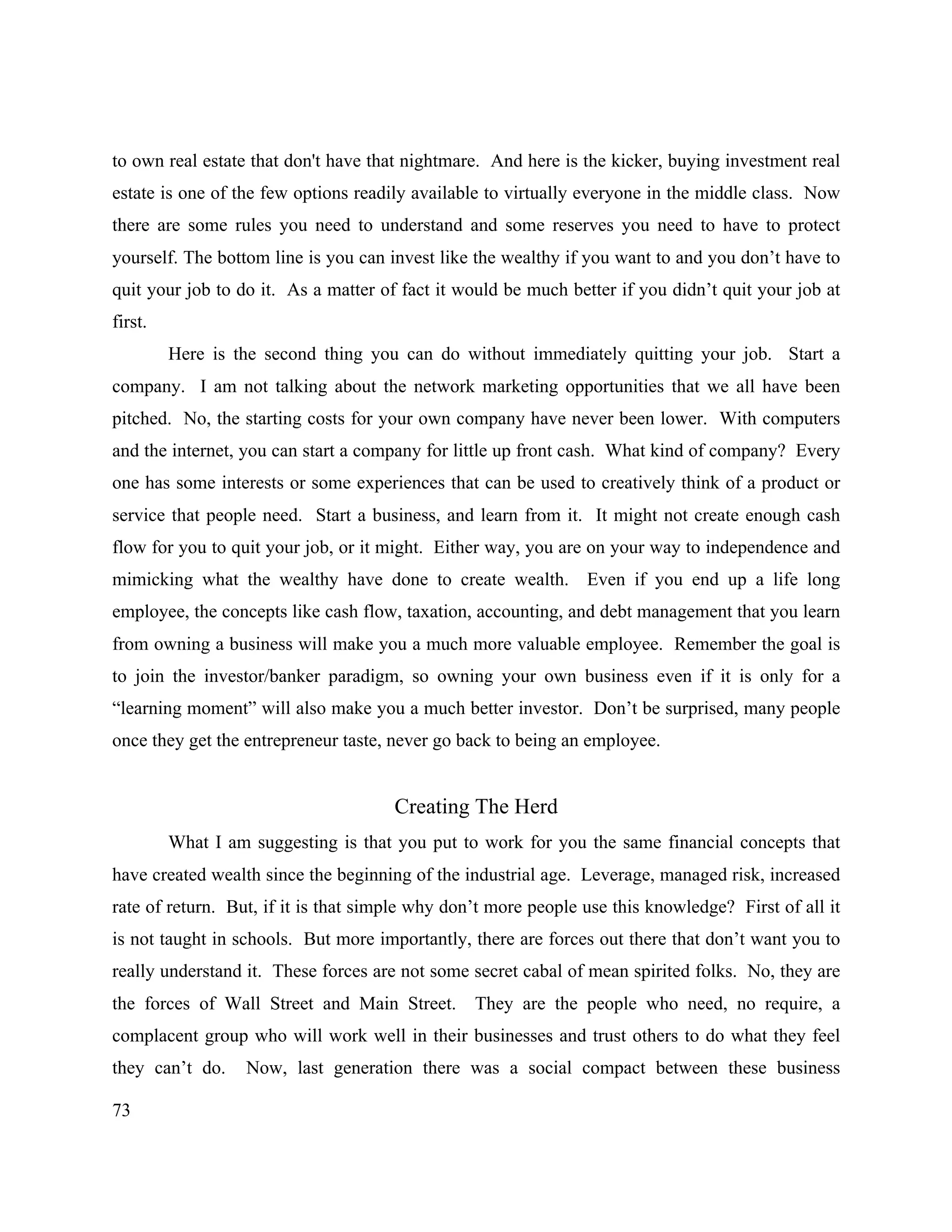
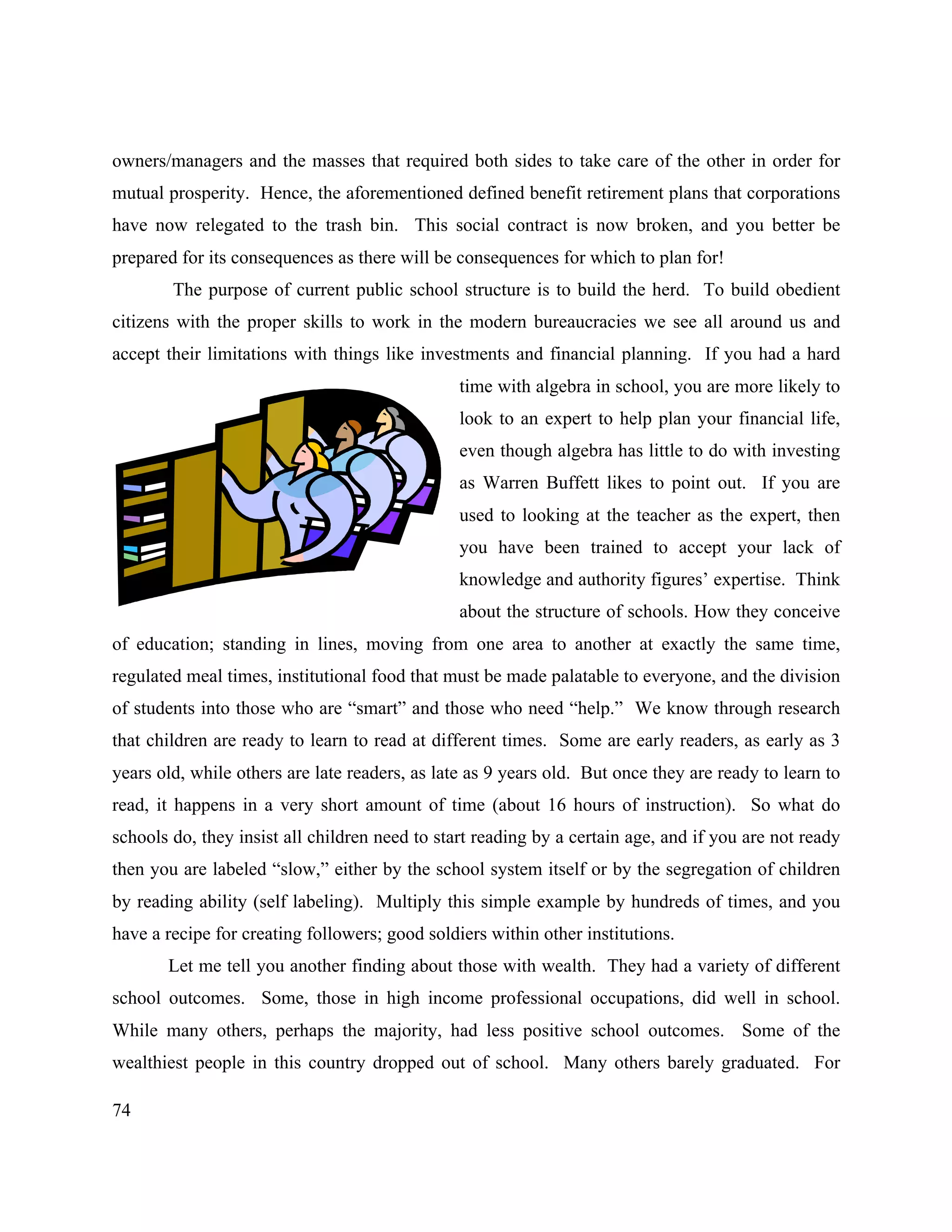
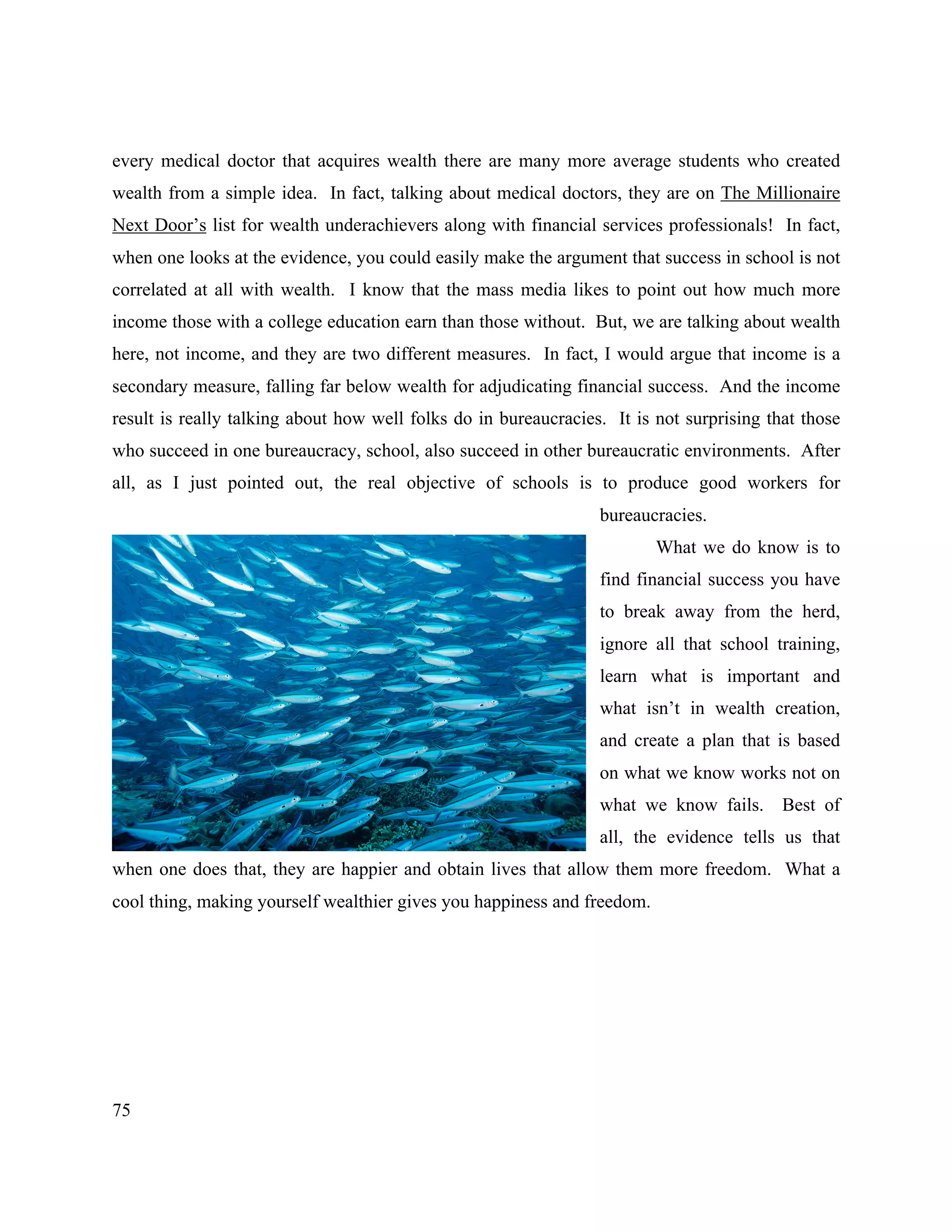
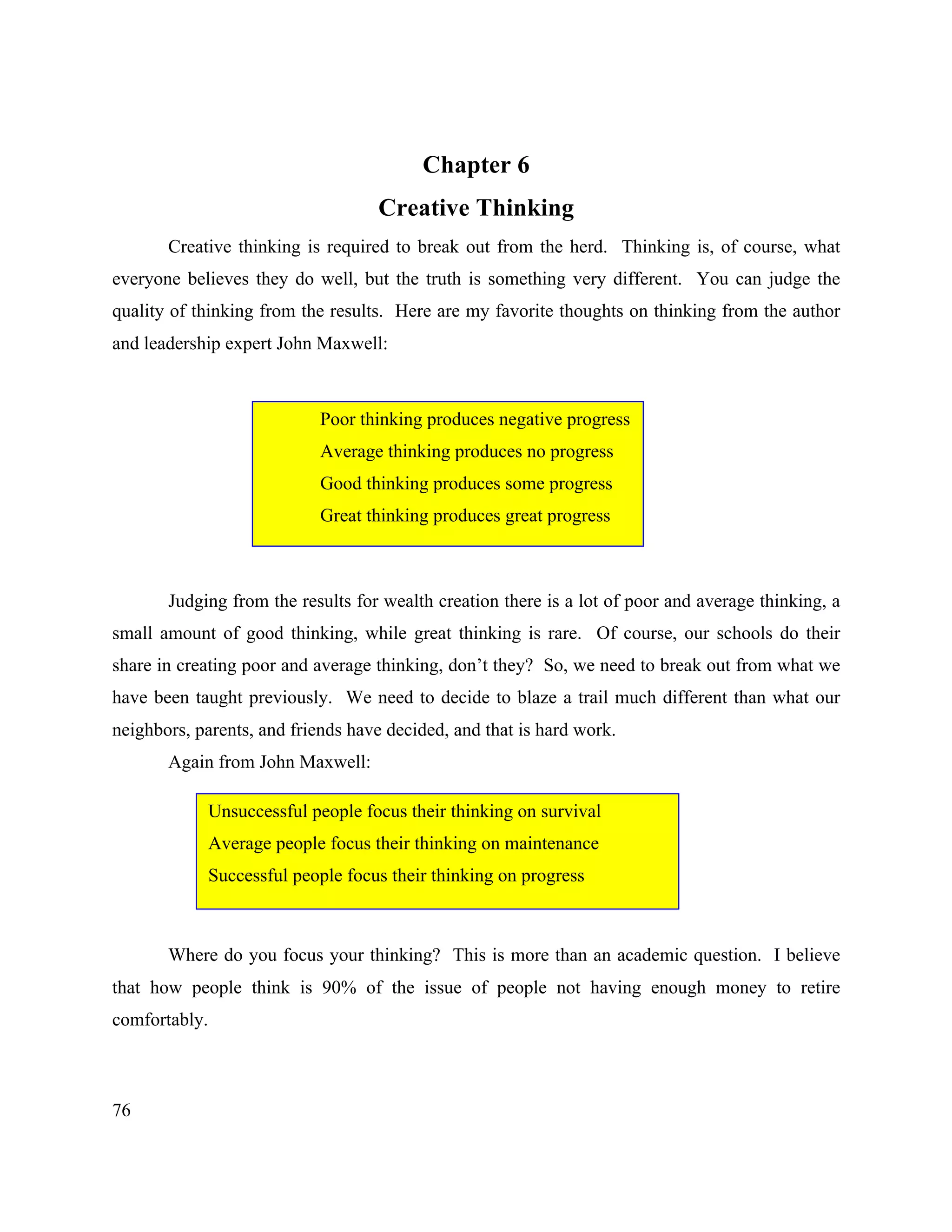

![78
puts it all out there honestly and forthrightly. So in a sense, if you have made it this far, you
have started your path to wealth. But, additionally you must make taking control of your
financial life something you enjoy and want to learn how to do well.
Let us look to Albert Einstein, one pretty creative guy, to help us grasp how we need to
become creative thinkers. There is much written about Albert Einstein as should be of a man of
such great intellect and I want to share with you a little of what I believe we should learn from
Einstein. First, let us put to bed that falsehood that he failed in school. He didn't. What he did
was rebel against the harsh realities of German schooling (a system we copied for our school
model). In fact, if you were to ask about one prominent characteristic of Albert Einstein, it would
be his rebellious nature. It led him to hate school orthodoxy and the military mobilization of
German society of the time.
Our society has much in common with the Germany he grew up with and rebelled
against. So what can we learn from Einstein? Allow me to share some Einstein quotes to animate
the discussion:
"Imagination is more important than knowledge"
This is classic Einstein. Not only is it the basis for his thinking, but it was the basis for his
dislike of schools. While he was imagining and writing the basics of what would become his
great theoretical breakthroughs (at age 16), his teachers were more concerned with him
memorizing facts resulting in one of his teachers famous quips, "it doesn't matter what he
[Einstein] does, he will never amount to anything." He wore the scars of this educational model
for his life. Later he would say:
"Great spirits have always found violent opposition from
mediocrities. The latter cannot understand it when a man does not
thoughtlessly submit to hereditary prejudices but honestly and
courageously uses his intelligence."](https://image.slidesharecdn.com/drdave20102-230209094210-28d544a4/75/Drdave2010_2-pdf-78-2048.jpg)
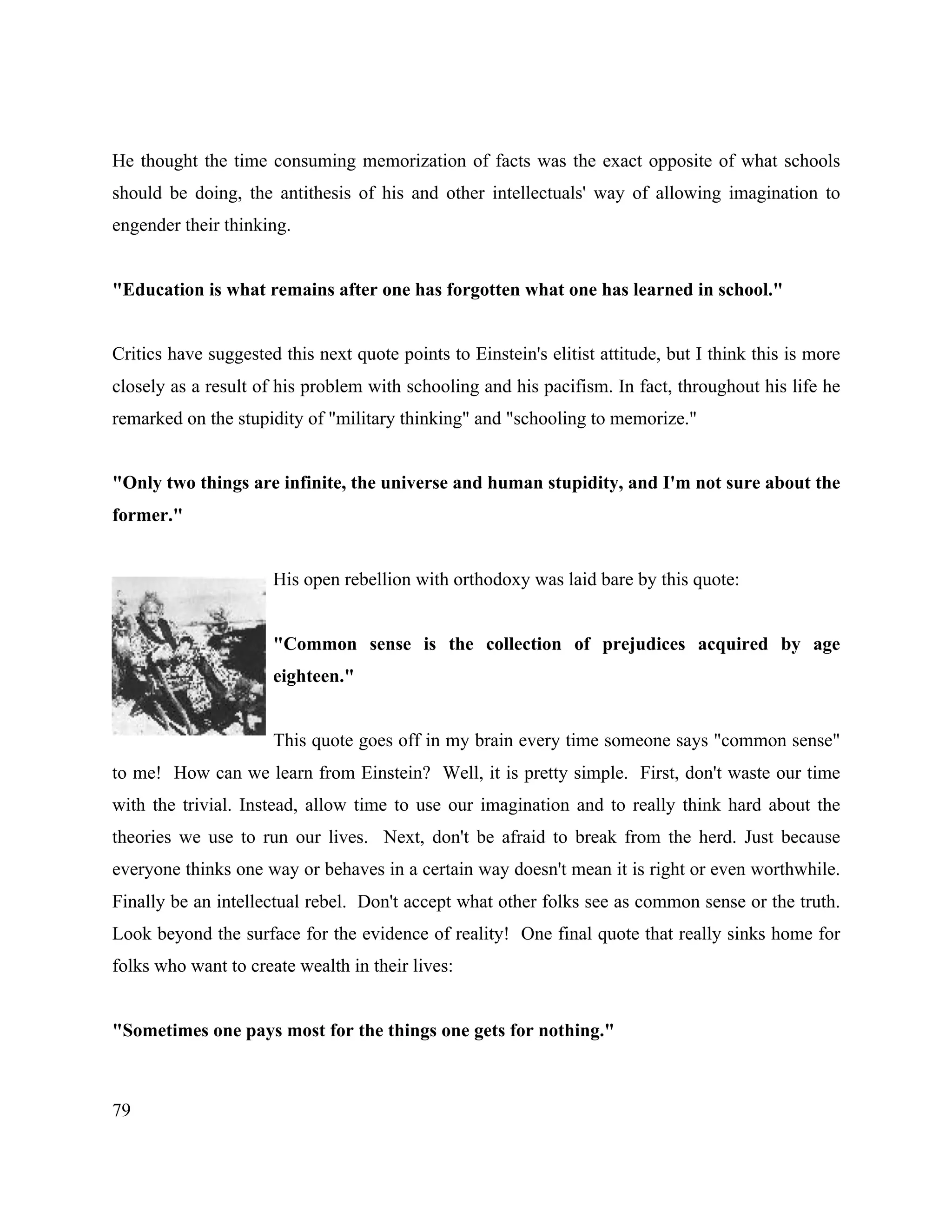
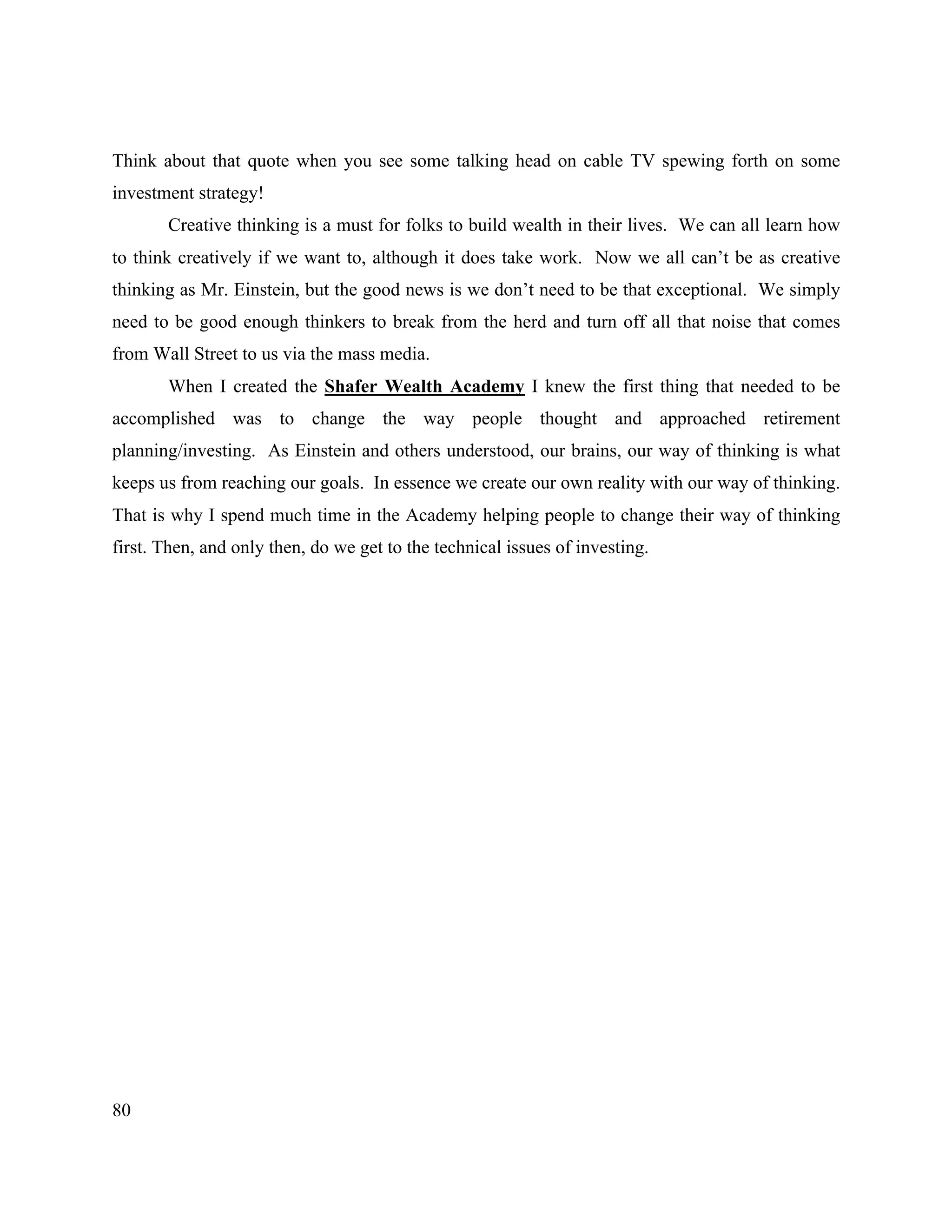
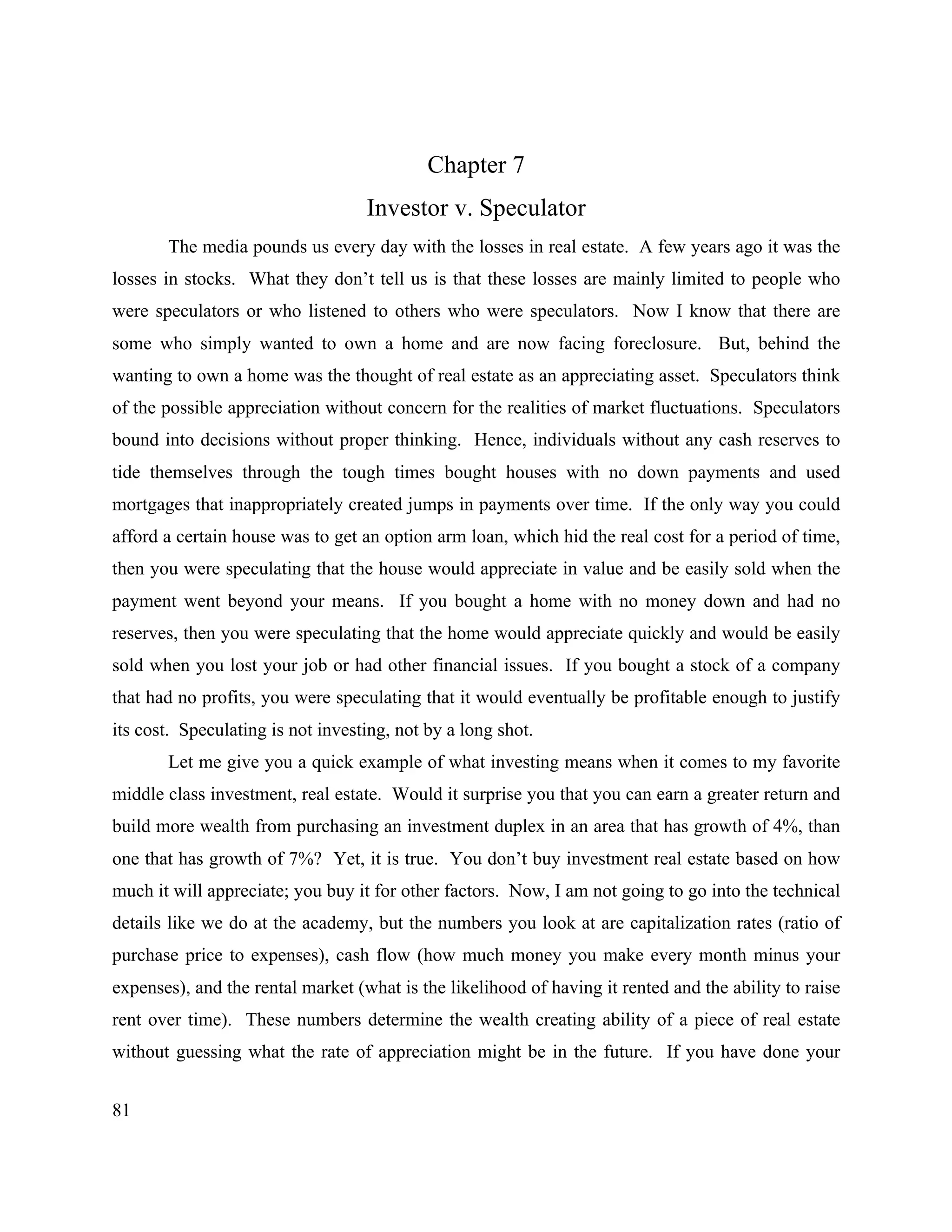
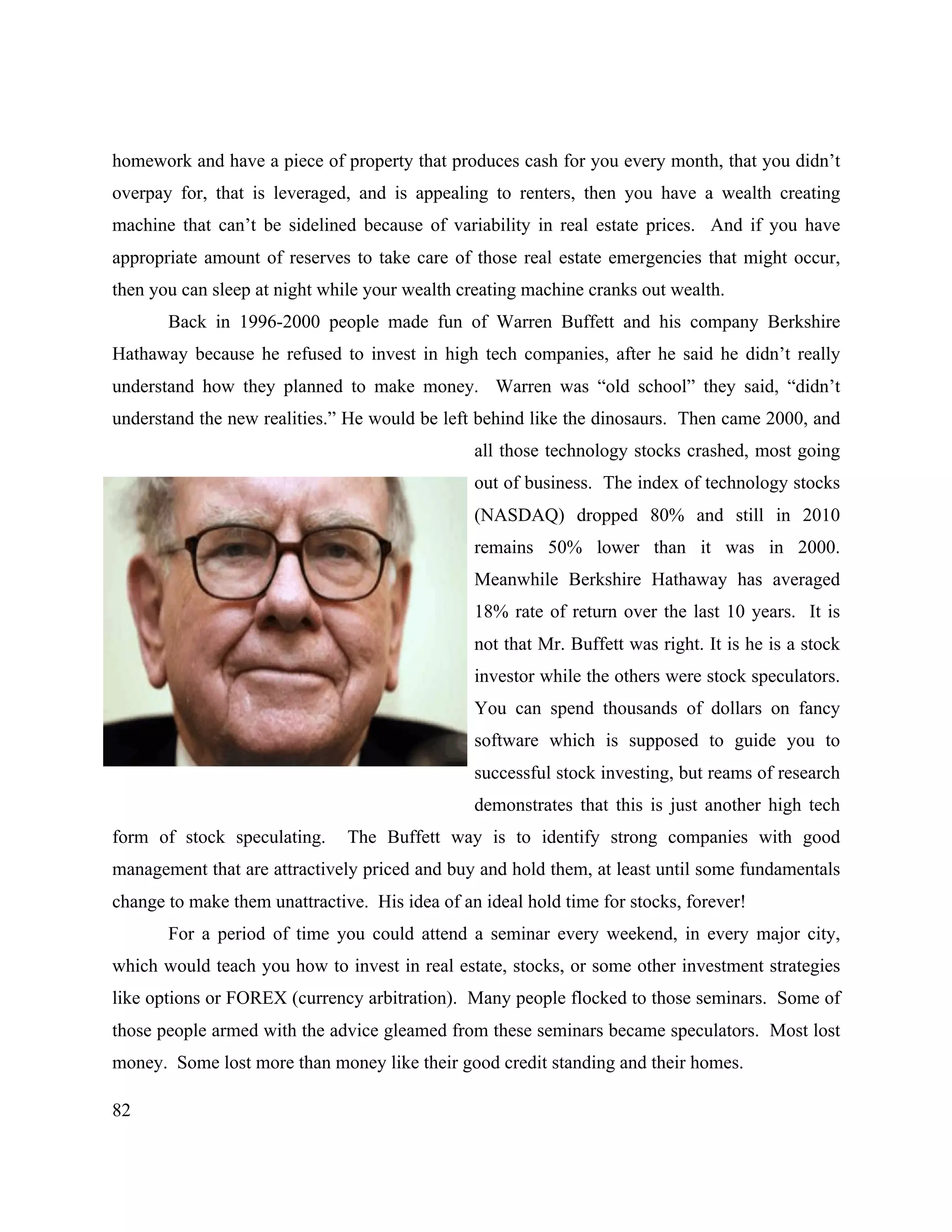
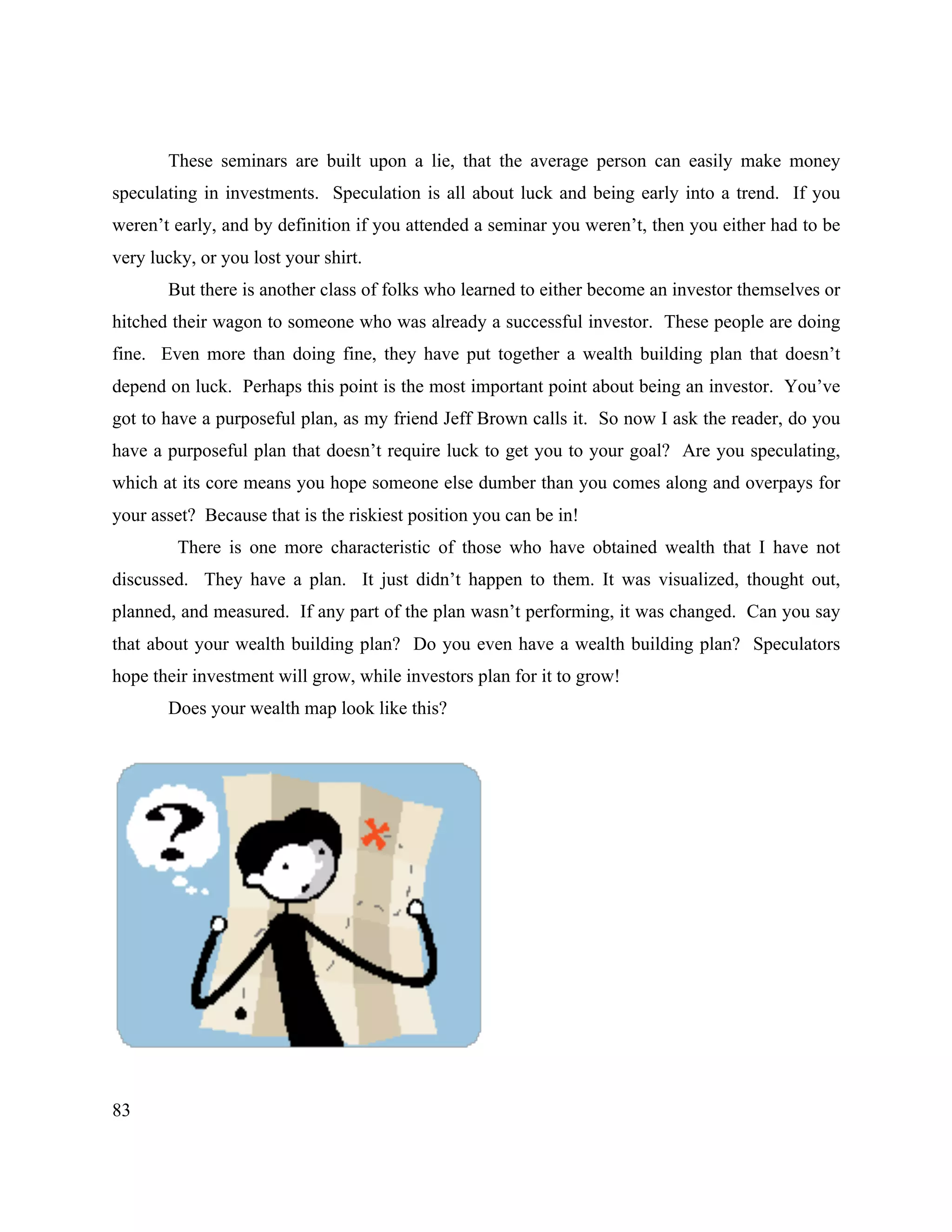

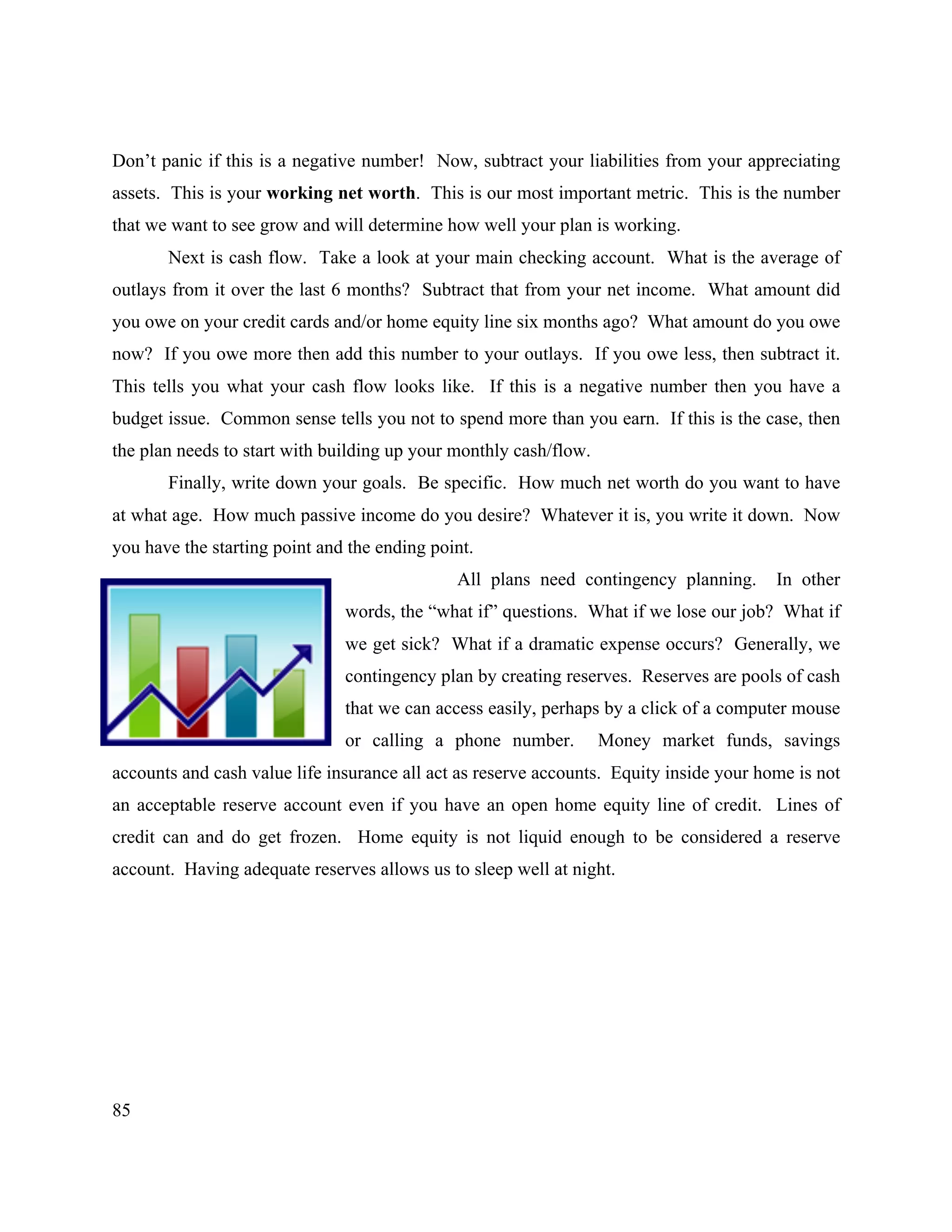
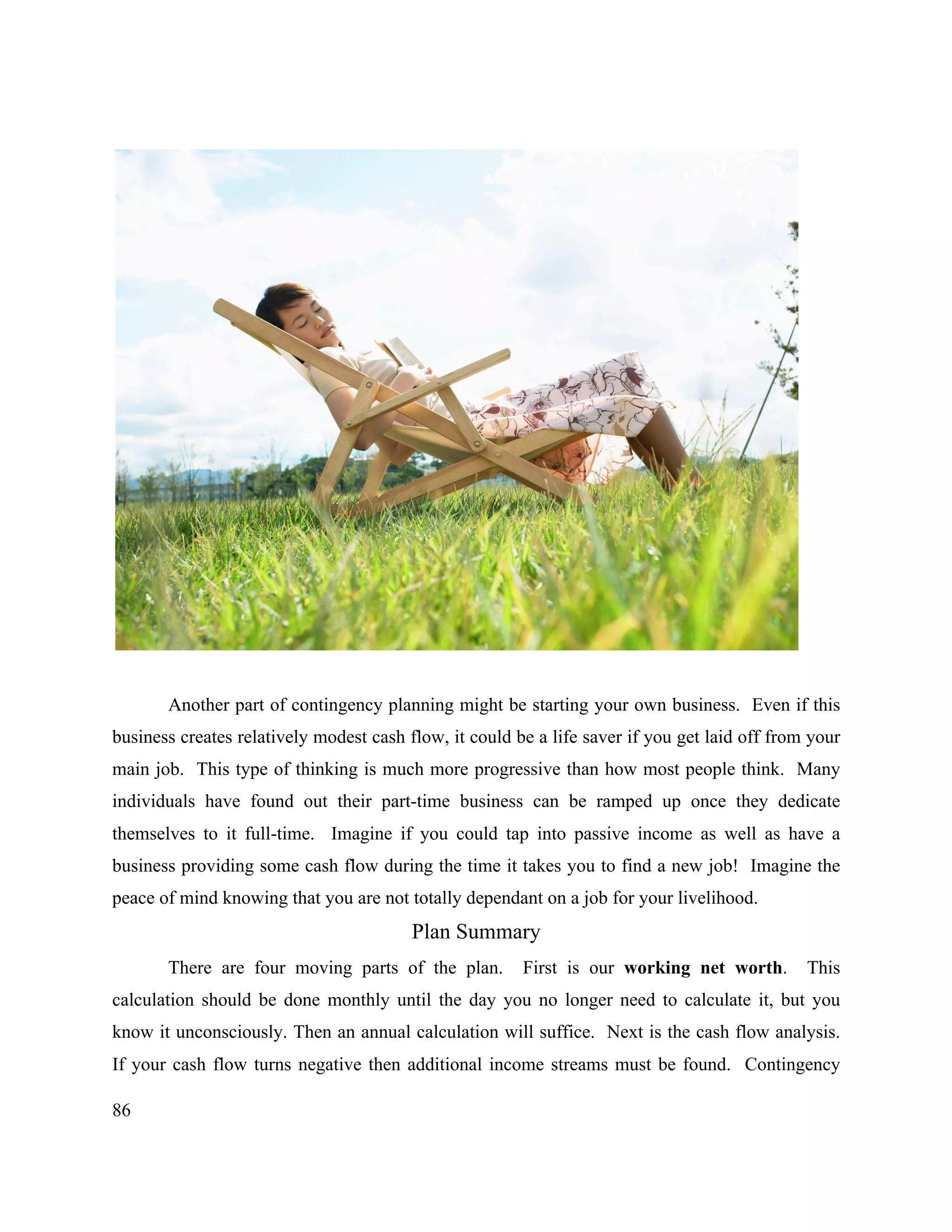
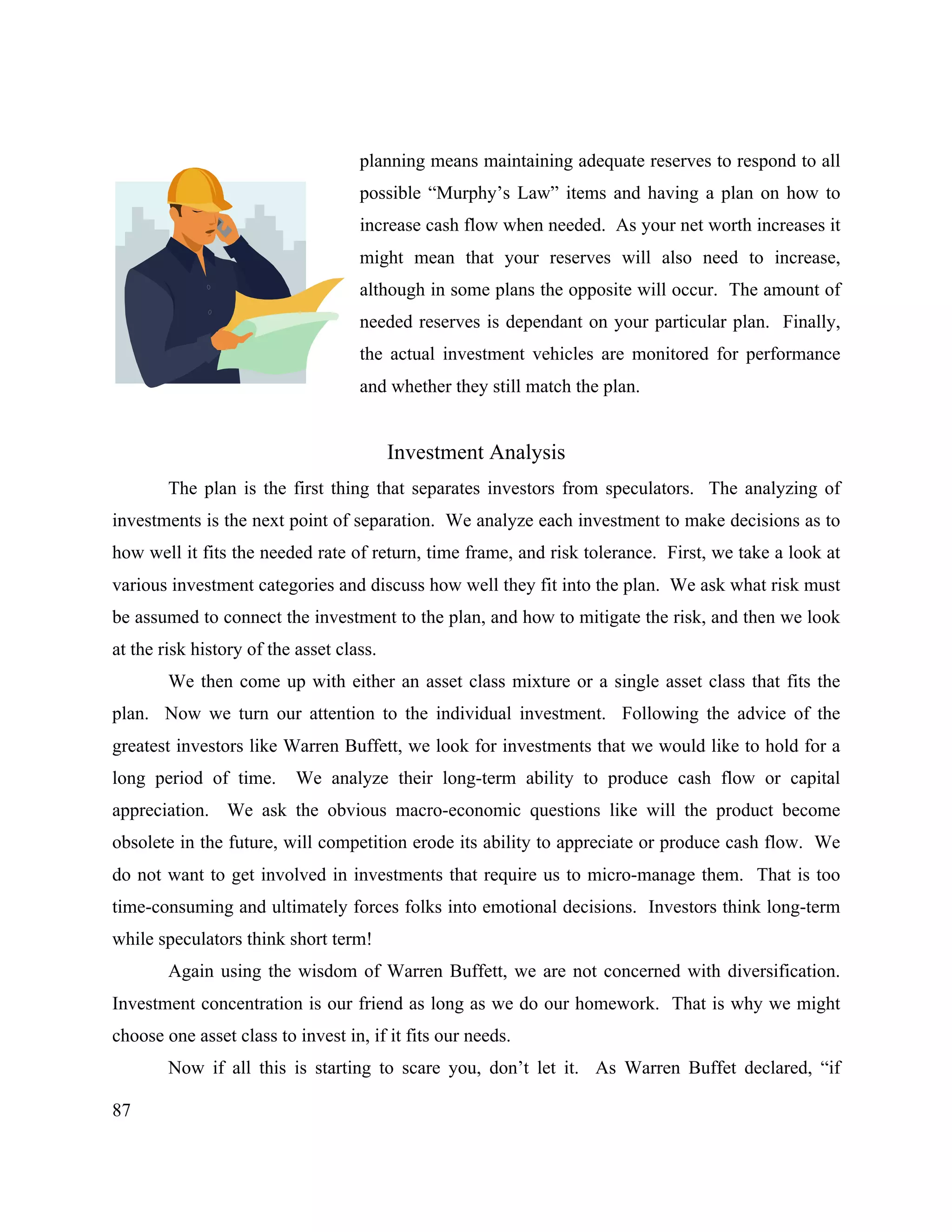


![90
Chapter 8
Putting It All Together
You now have waded through all these chapters and have a good feel for my philosophy
and the important concepts you should understand about personal investing. Now lets put it all
together. Fortunately, you are now armed with the knowledge to appreciate these suggestions.
The scope of the book is not to sell you any particular product [even though I do sell one
product], but to bring you to a place where you understand the uncommonness of real financial
knowledge. This should not be the last book you read on investment strategies, but it should be a
launching pad to finding out more. Hence, the following is my thoughts based on what I have
outlined in the first seven chapters but is not intended to be a total “how-to” invest in these
strategies. There are experts available in each area that can and will teach you how to
successfully navigate these strategies.
There are three investments strategies that make sense and one should consider using at
least two of them if not all three. They all have these qualities. They take into consideration
taxes and are tax efficient. They are able to produce income without also having penalties or
severe consequences tag along with that income. They don’t rely on “average” rates of returns
so are not susceptible to either the flaw of averages or to sequence of return risk.
The first is investment real estate. Recent amateurish investing in real estate has given
real estate a bad name. Real estate investing has proven to be the best way to produce wealth
historically. By using proven buying metrics, learning your market, and using some common
sense you can develop excellent retirement income without relying on property appreciation.
And best of all there are some excellent advisors that can guide you. You won’t have to pay cash
flow out to these advisors until you sell. But beware, there are many more folks who will steer
you wrong only looking for the sale. It is beyond the scope of this book to instruct you on the ins
and outs of real estate investing but done correctly there is no better investment vehicle.
Obviously you are using leverage. But you can also partially offset income from taxes. And you
can achieve decent rates of returns without having to depend upon excessive capital appreciation](https://image.slidesharecdn.com/drdave20102-230209094210-28d544a4/75/Drdave2010_2-pdf-90-2048.jpg)
![91
of the property.
At the end of the day, you can with modest investments, end up with substantial rental
income that rises with inflation and is partially protected from taxes. No need to sell an asset
into a down market. No need to sell at all if the desired income has been achieved. No need to
personally manage these properties unless it is something you want to do.
Dividend producing stocks is the second place that I think folks should look for income.
If instead of investing in stocks for capital appreciation one would invest in stocks that pay
steady increasing dividends for decades they would be much better off in retirement. Currently
dividends are taxed at a lower rate than income, so they are tax efficient. And it is easy to figure
out how much income you get. Just add up the dividends paid. If the stock market goes down
[or up] it doesn’t matter because all you care about is the dividend payment. If you choose large
companies that have a long history of increasing their dividend [McDonalds or Proctor and
Gamble for example] and diversify a little you can design an income stream that will at the very
least keep up with inflation if not compound out. There are multiple books and internet sites to
help you choose dividend paying companies to own. And with a little monthly homework on
your ownership you can make the appropriate changes if a particular company puts their
dividend stream at jeopardy. Sequence of return risk is mitigated as you might never sell the
stock in these companies, instead live off the dividends. There are many companies that have
increased their dividends over 8% a year for extremely long period of time. Some that have
increased dividends over 10% a year. Although it is unlikely that you would get a rate of return
as high as your real estate investments, it can and should be an excellent return. Choose 5-8
companies and you should be diversified enough, but not too diversified to cost you returns.
These large long-standing dividend paying companies don’t change over night so the homework
and surveillance is kept within the reach of almost any thinking person’s abilities.
Finally, permanent life insurance should be owned and structured to maximize its cash
value build-up. When structured correctly, the costs are minimized and the internal rates of
return are substantial. I prefer and sell equity indexed universal life insurance policies. These
policies pay interest tied to a stock index with caps around 15% and never give a negative return.
They give good protection against an early death as well as mitigate the sequence of return risk.](https://image.slidesharecdn.com/drdave20102-230209094210-28d544a4/75/Drdave2010_2-pdf-91-2048.jpg)
![92
And best of all income can be taken from these policies tax-free. Although these policies won’t
deliver internal rates of returns as high as the first two suggestions, the tax-free aspect makes up
for the lower rates of return. They have high liquidity with few limitations to accessing the cash
value. Those interested in understanding EIULs should start at my blog at
http://shaferfinancial.wordpress.com. The truth is that life insurance has been used by the
wealthy and large corporations for several generations to create a stable financial platform. Life
Insurance Companies are some of the most stable companies in our history. Internal Revenue
Codes have been in place for over a generation that enables the tax-free nature of income from
the policies. These policies are products with good internal rates of returns and established
taxation decisions backed by financial secure entities.
If one were to use all three of these strategies, they would protect themselves against the
common financial maladies most folks experience. They would have income from three
different sources [diversified], pay few taxes, and not have to worry about the huge ups and
downs of the stock market. Emotionally, they should be prepared to accept the realities of a
dynamic economy without panic nor silly mistakes. In short, they would be in control of their
own retirement destiny. What more can someone ask for?](https://image.slidesharecdn.com/drdave20102-230209094210-28d544a4/75/Drdave2010_2-pdf-92-2048.jpg)

